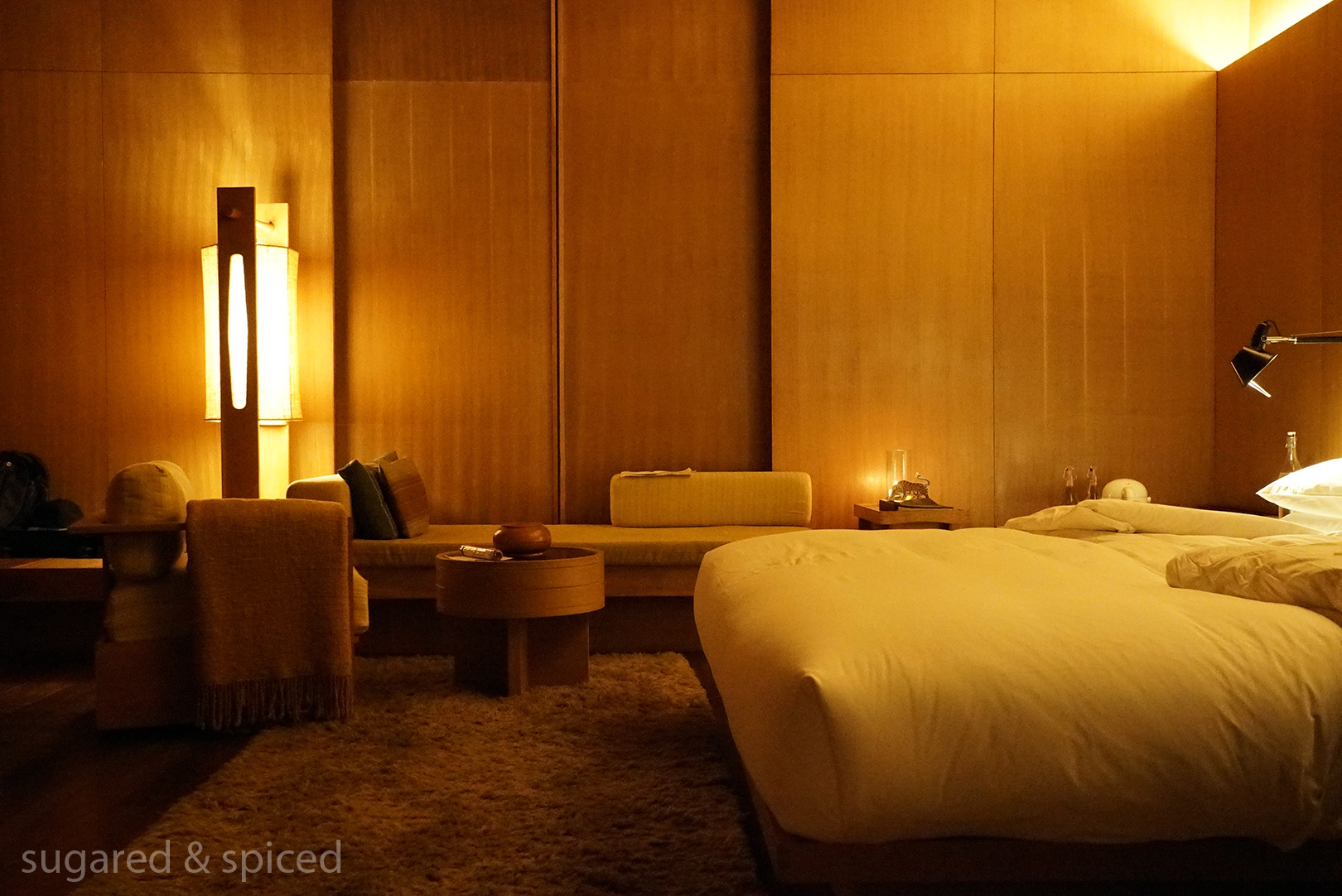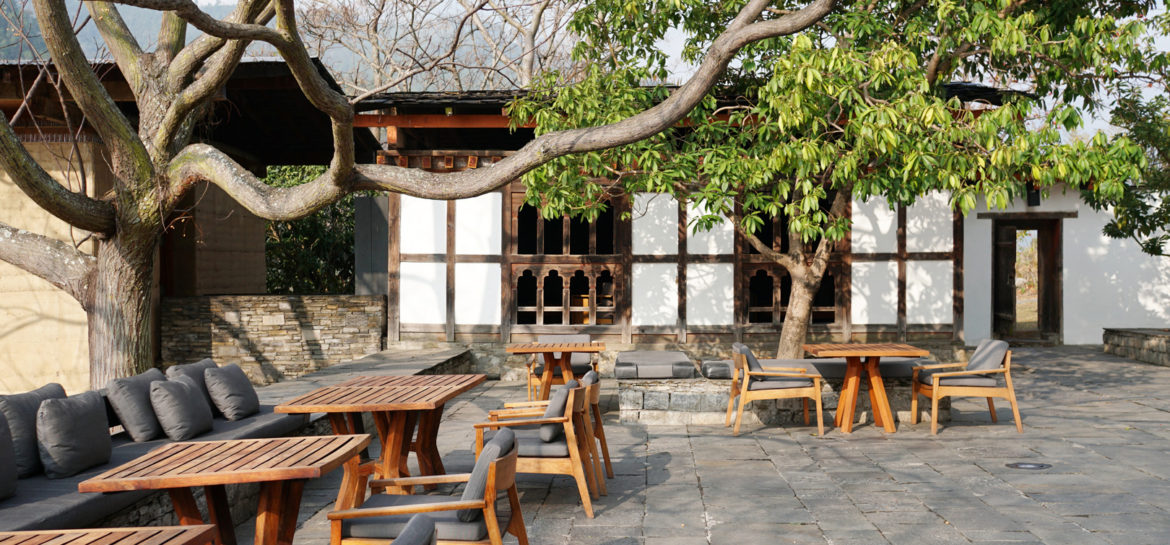
Day 4, from Gangtey to Punakha
Today, we were to make a 3-hour drive from Gangtey to our next destination – Punakha. But first, I had requested to observe a special assembly at the local village school, organized in celebration of the birthday of none other than His Majesty The King of Bhutan.
旅程的第四天正巧是不丹國王的四十歲生日。為了慶祝這個特別的日子,村落學校的孩子們準備了精彩的歌舞表演,我們也好奇地前去湊熱鬧。
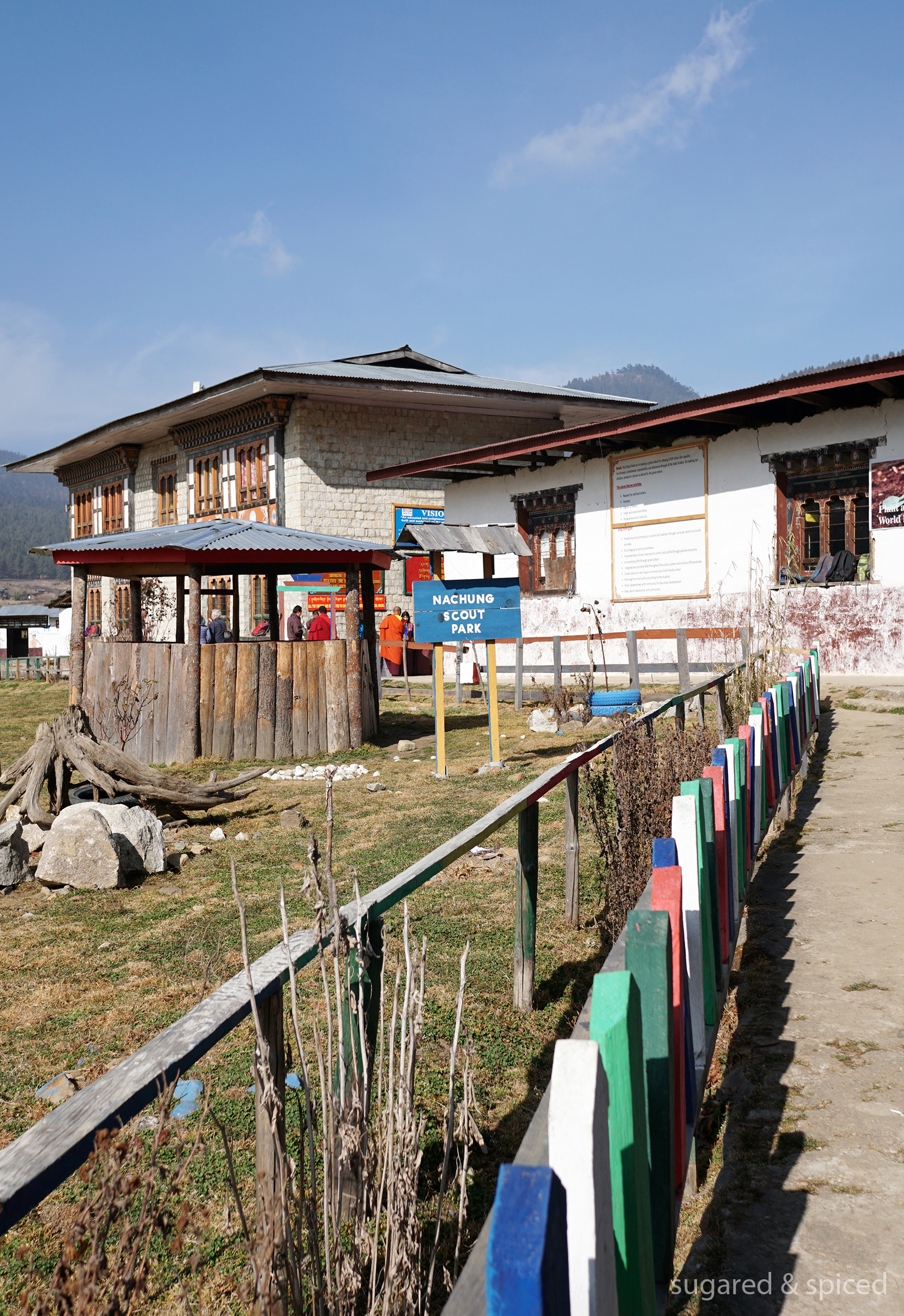
Upon entering the school, I noticed references to “Gross National Happiness” (GNH) on the walls. The fourth king of Bhutan coined the term in the 1970s (when he was only in his early 20s!), by explaining that he would rather have GNH for his people than GDP. Bhutan has foregone opportunities to make money off its considerable natural resources – lumber, water, minerals, animals…often eschewing economic growth in favor of environmental preservation, good governance, culture and tradition, which are believed to be more important to the well-being of its people.
走進學校,首先注意到的是牆上掛有 “國民幸福總值”(Gross National Happiness,縮寫GNH)的字樣。這個風靡全球的概念最初由不丹第四任國王在70年代初期提出。當時才二十歲出頭的年輕國王被外國記者問及不丹的國民生產總值(GDP)時,語出驚人地表示:“相較於 GDP,不丹更重視 GNH”。他是全球第一個提倡 “快樂立國” 觀念的執政者,除了公平永續的經濟發展之外,也注重保護生態、維護傳統文化等,相信物質與精神生活上的平衡能給人民帶來真正的幸福。
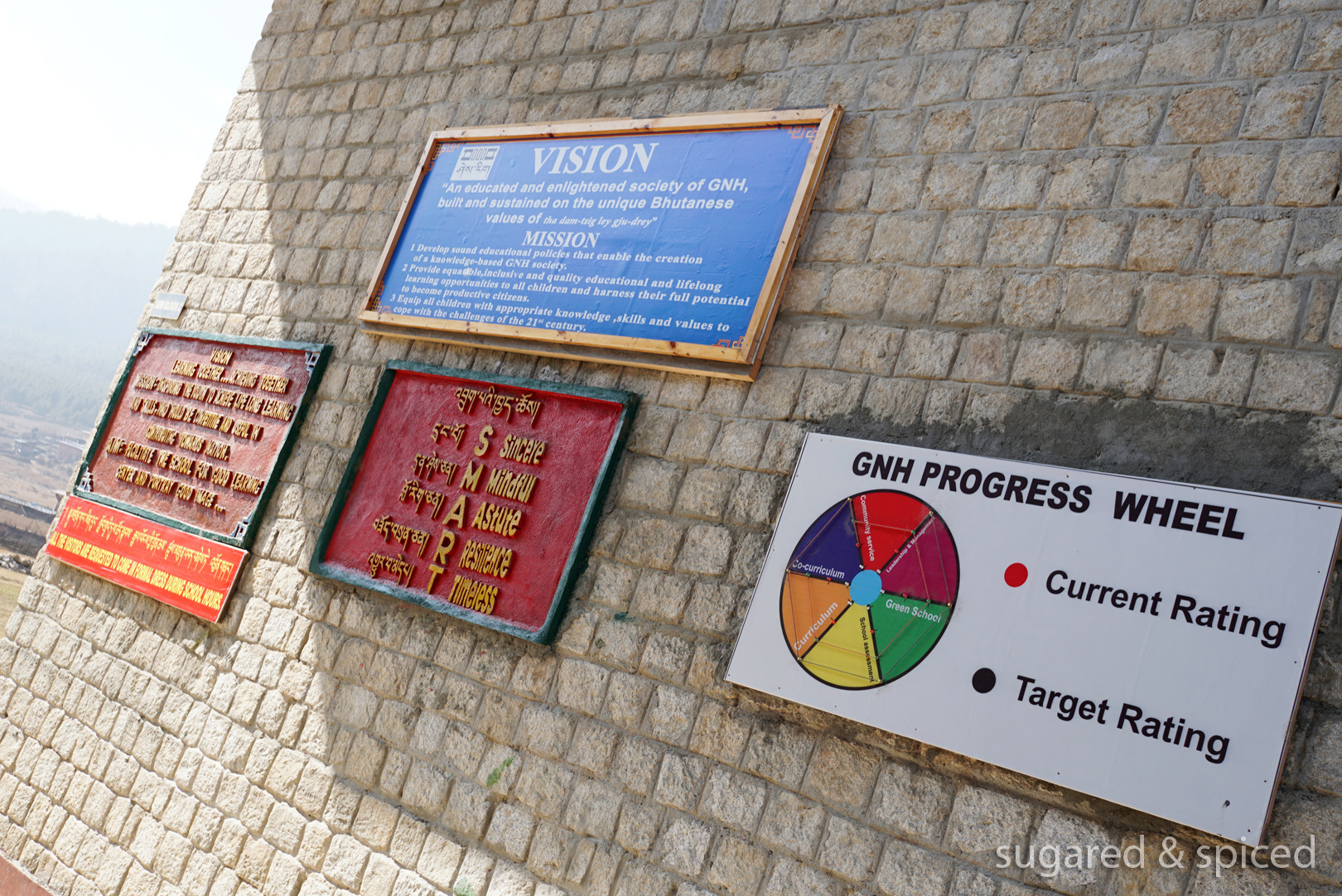
For example, it is written in the constitution that at least 60% of the country must always be forested (the level is currently at 71%, an important factor that makes Bhutan the only carbon-negative country in the world). Bhutan has free health care for all its citizens, and no homeless people. In some aspects, it has been at the cutting edge of international trends – plastic bags have been banned since 1999, and tobacco is practically illegal there.
比如在環境保護方面,不丹憲法規定森林至少佔國土面積 60%以上(目前是71%),等同限制農業以及高獲利的伐木業發展,注重生態價值多於商業價值,讓不丹稱為世界上唯一一個負碳排量的國家。數年前國王喜得小王子,在全國境內種下108000棵樹苗以表慶祝。政府也提供人民免費的醫療和教育,而且沒有流浪漢。在某些方面,不丹甚至走在國際潮流的尖端,從1999 年起就開始禁用塑膠袋,吸菸也是違法的。
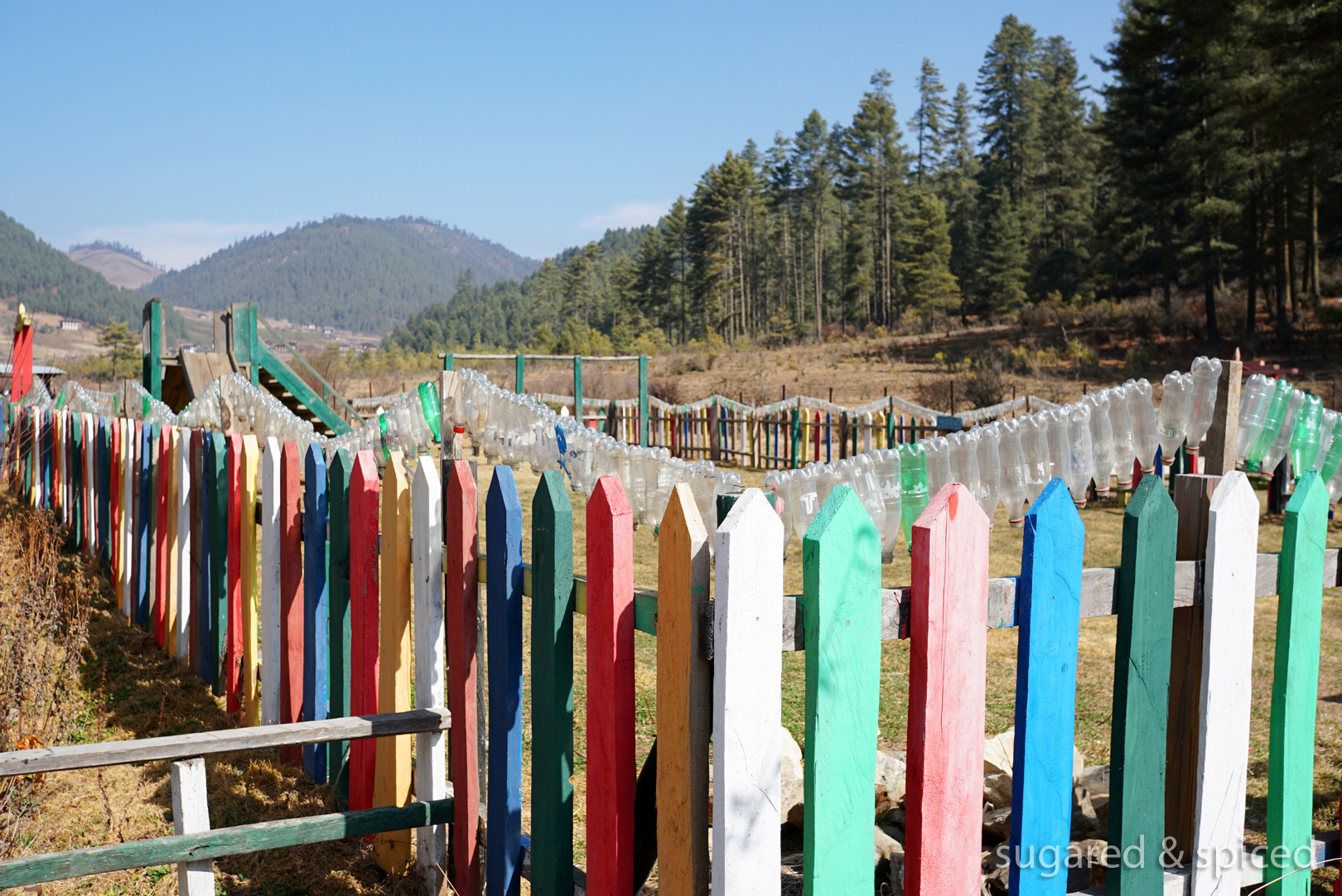
(Recycled plastic bottles used as school decorations.)
(學生們用回收塑料瓶做的裝飾。)
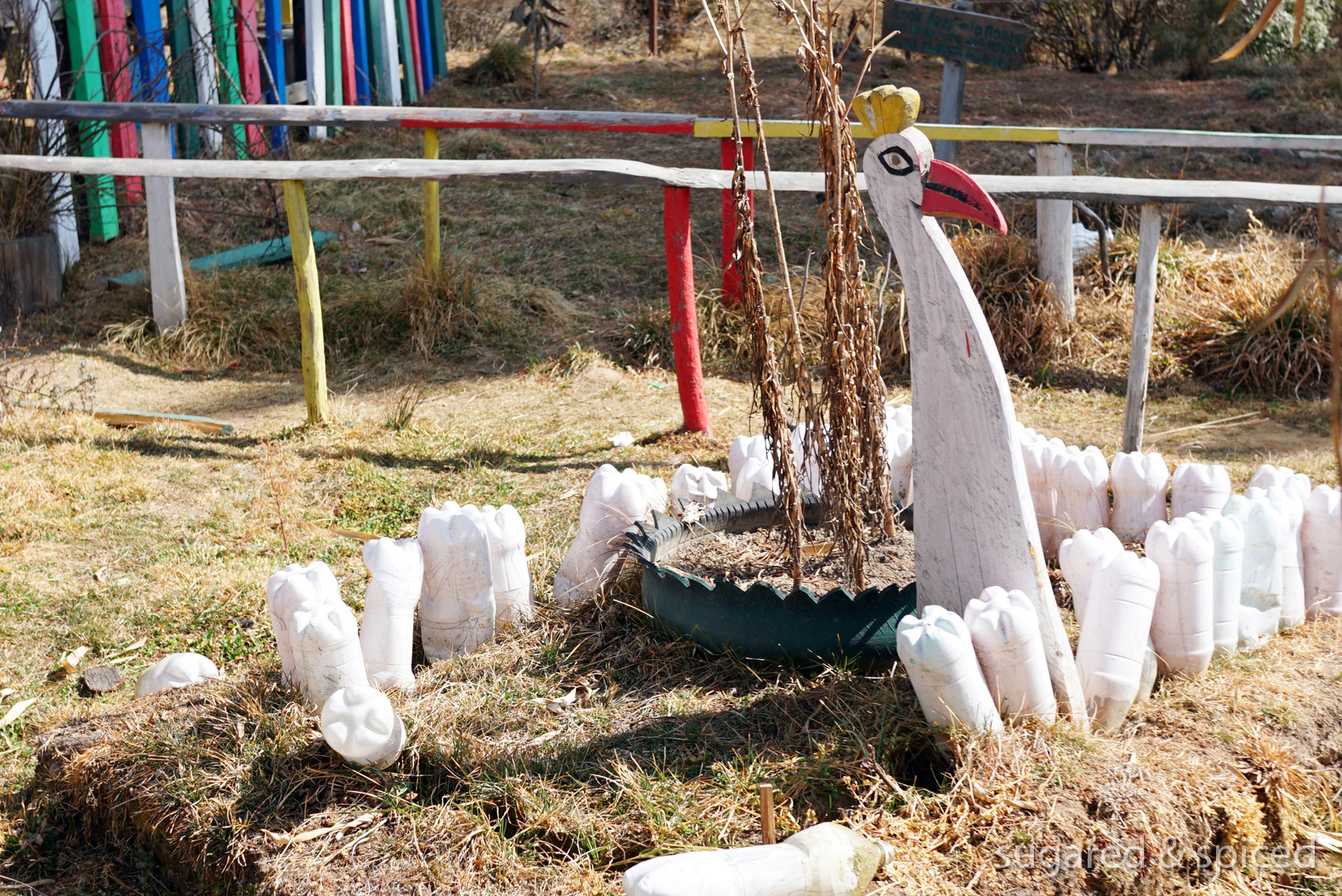
Of course, it’s not picture perfect. With modernization, made more rapid by the introduction of television and internet to its people in 1999, Bhutan is experiencing its share of problems, such as environmental degradation caused by road and hydropower constructions, a widening income gap between rural and urban areas, as well as a rise in unemployment rate in the cities and labor shortage on farmlands as flocks of young people leave their villages to seek out a better life in urban centers. Will the future generation be able to enjoy the same kind of peace and sense of well-being as their parents and grandparents have? I couldn’t help but worry.
當然,不丹並不完美。隨著國家走向現代化發展,許多問題也接連浮現 – 道路和水壩的修建造成了一定程度的自然破壞,經濟成長擴大了貧富差距,而大量年輕人為了追求 “更好的生活” 遷往城市,導致農村勞動人口流失以及城市失業率上升。面臨這些改變,不丹的下一代是否還能和長輩們一樣,享受安寧喜樂、步調從容的生活?我忍不住擔心。
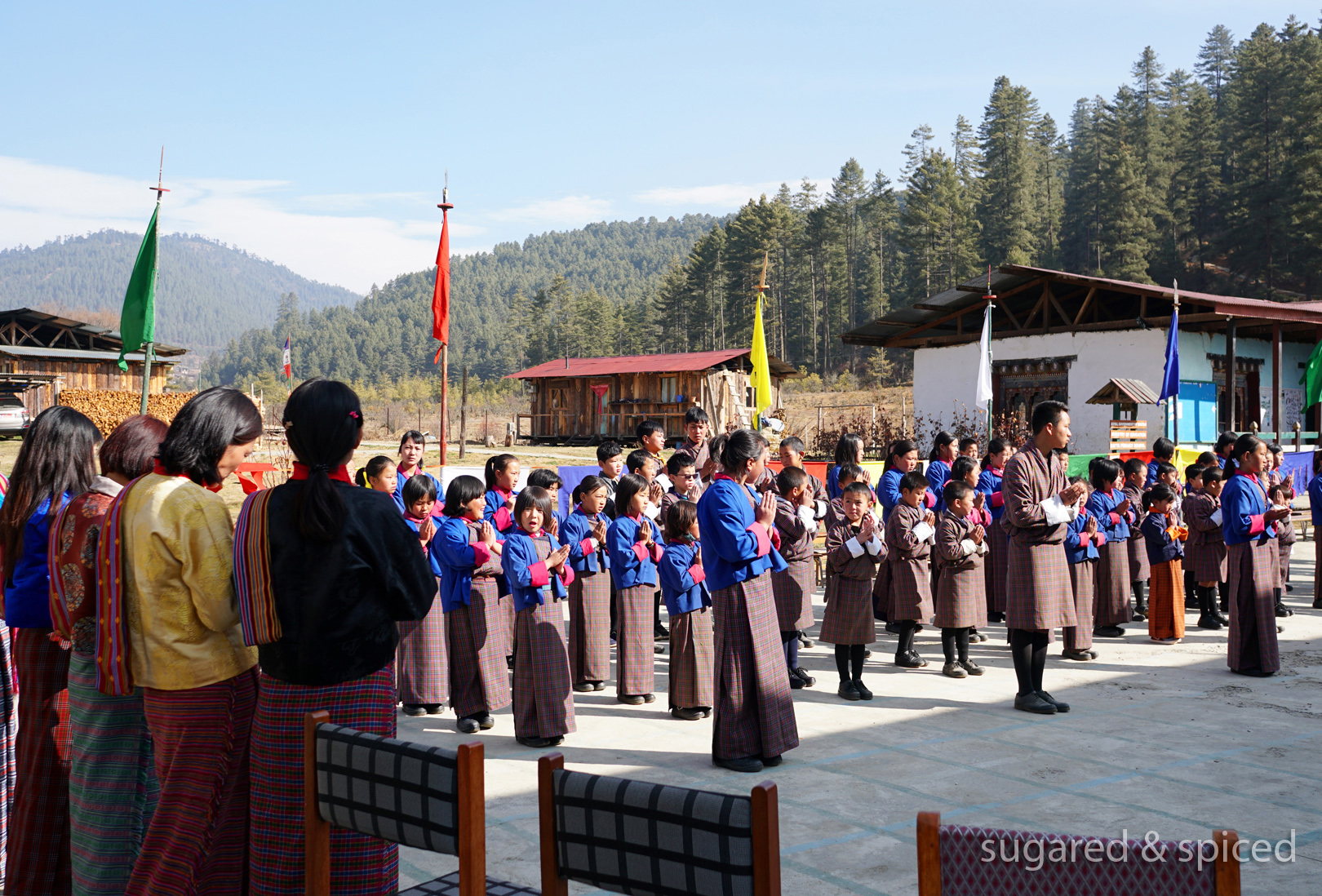
But at least for now, in this remote village in Gangtey, children still seem to be pure, carefree, and very happy. We arrived just in time for the assembly, which commenced with a quiet prayer led by a senior monk from Gangtey Monastery, followed by lively dance performances from the students. I marveled at the energy, feeling that it’s rather serendipitous for us to be in Bhutan on the day of the King’s birthday, and to be able to partake in this overflow of positivity.
不過至少在這個偏遠的村莊裡,孩子們仍然純真無邪、知足快樂。早會的一開始由崗提寺的和尚帶領祈福,接著是學生們的舞蹈表演。幾個調皮的小男孩沒有乖乖坐著觀賞節目,自顧自地在草原上奔跑,翻跟斗,跟著音樂盡興跳舞。我突然覺得自己不可思議地幸運,能夠在國王生日的這一天站在不丹的土地上,吸收如此飽滿的正能量。太陽曬得身子暖暖的,腳邊躺著的狗狗慵懶地搖著尾巴…
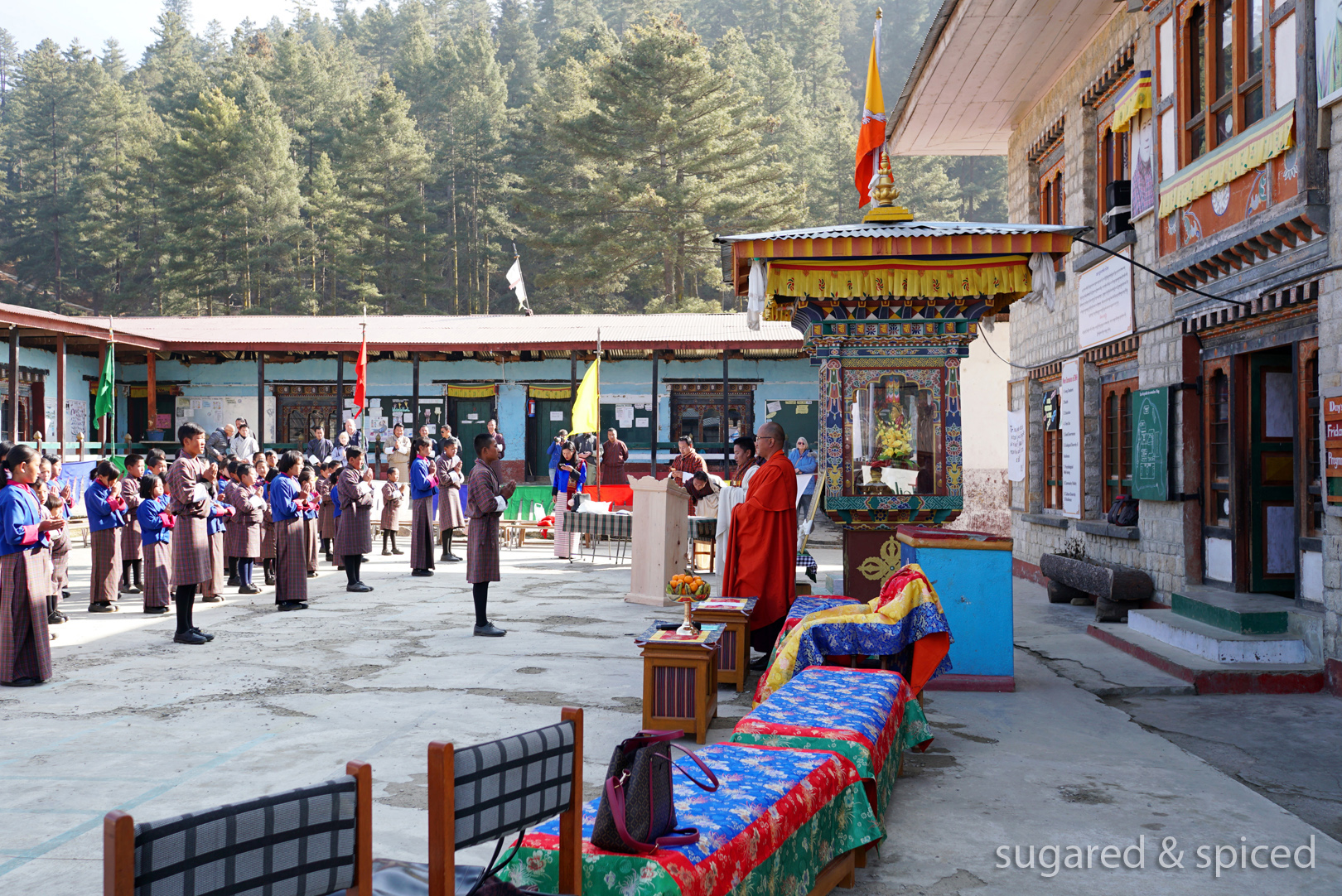
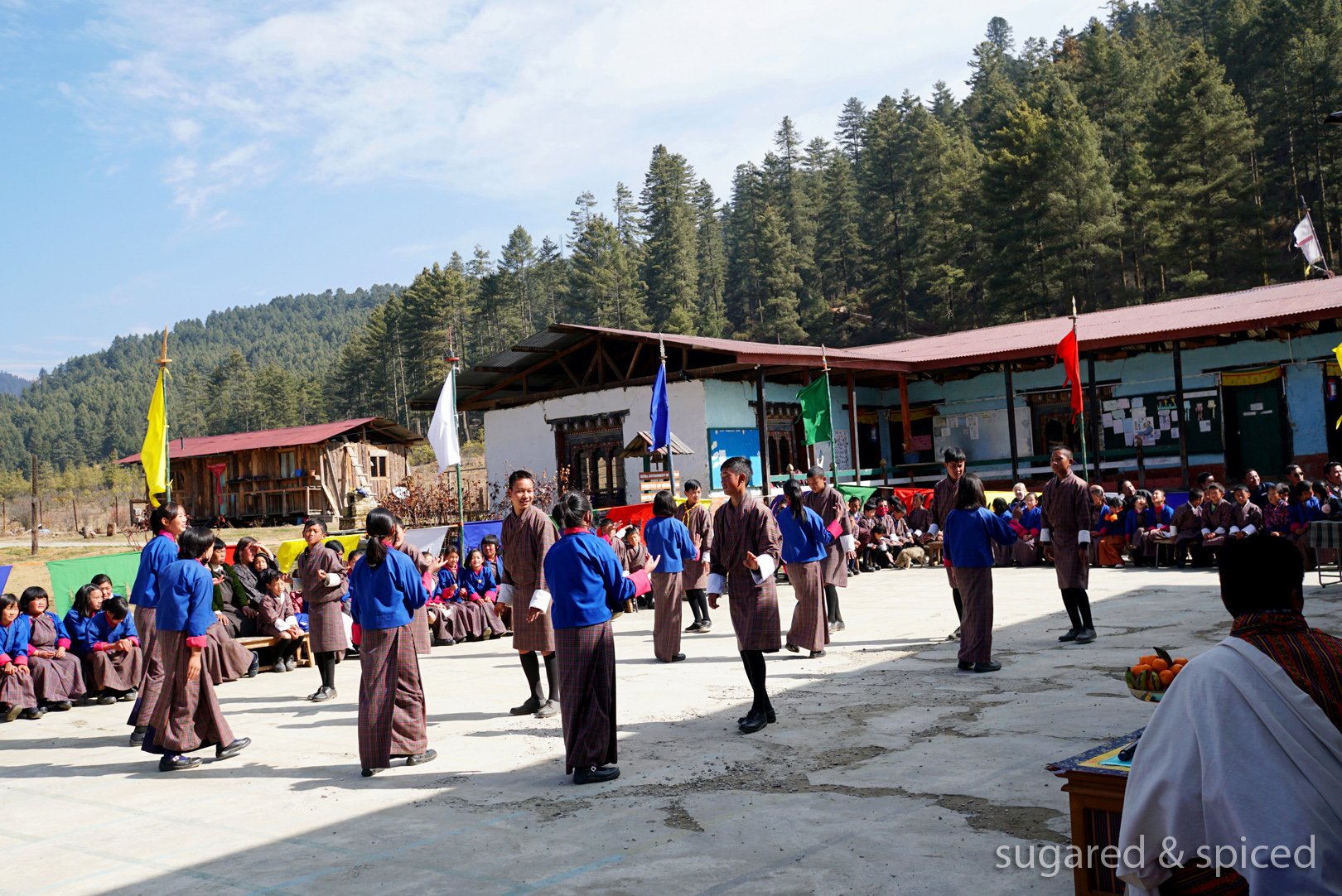
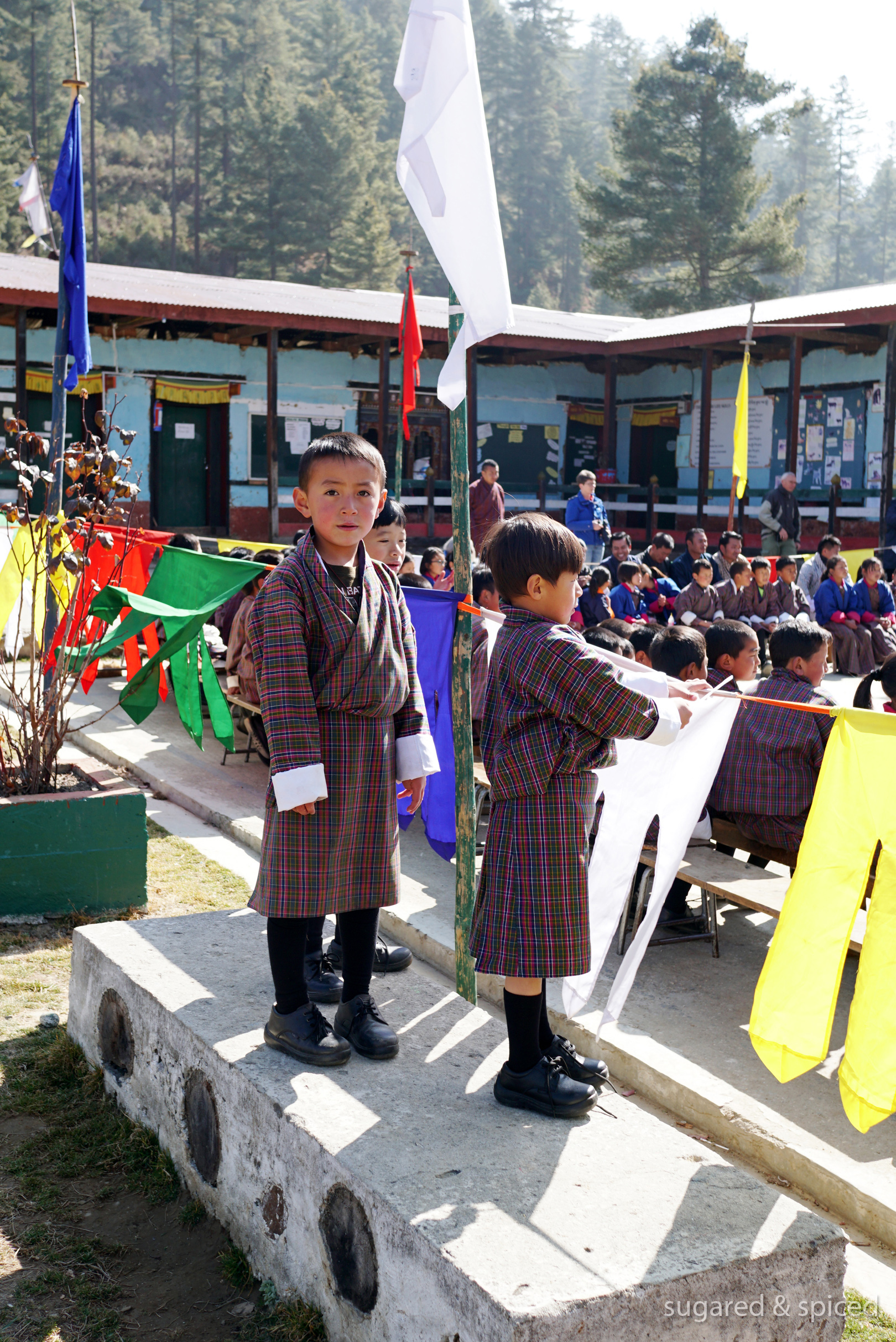
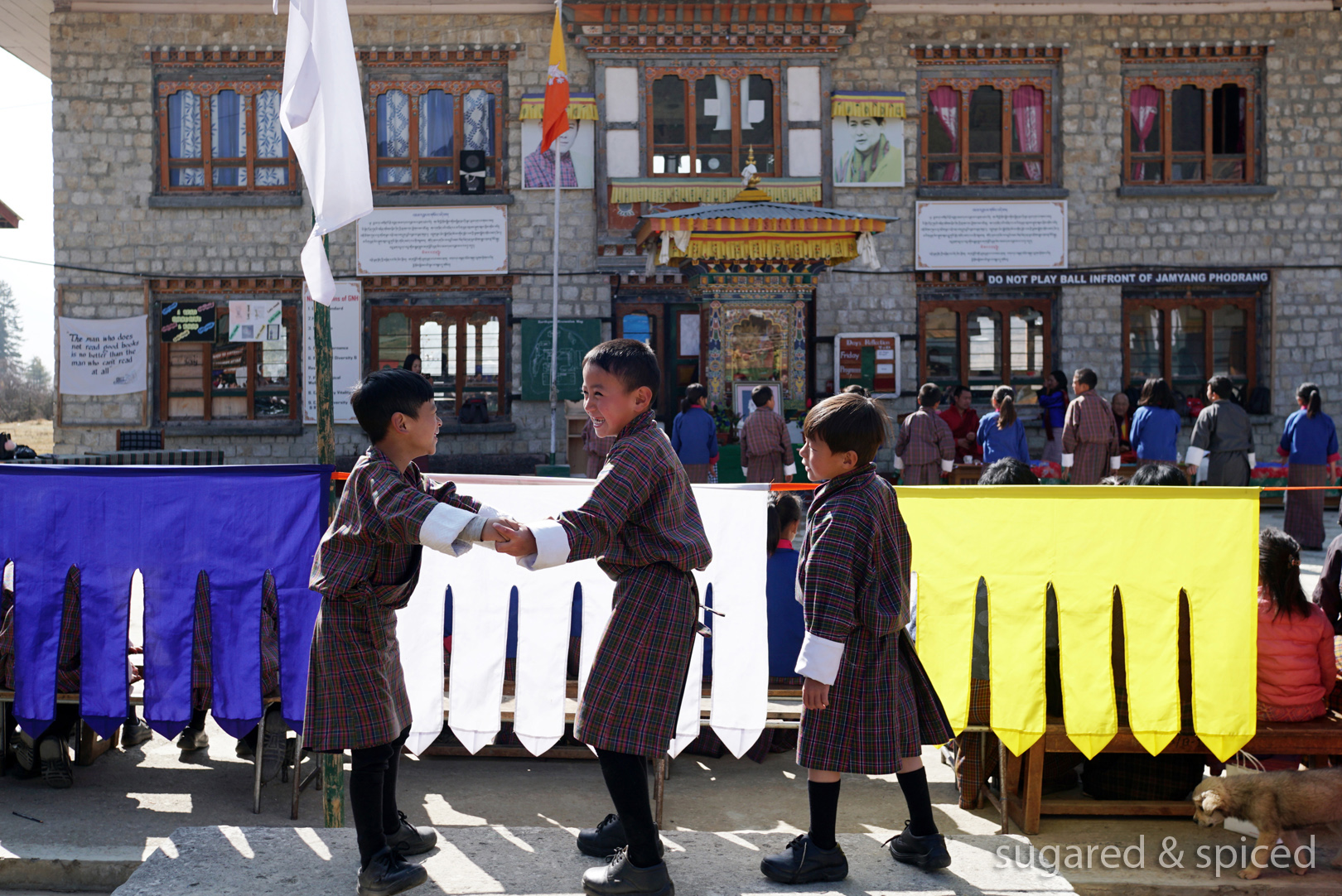
There was also a distribution of awards to students and teachers. This little girl with a happy grin received recognition for having the best grades and for reading the most number of books this semester.
早會還有頒獎環節。這位小女孩同時收穫了 “最佳成績” 和 “閱讀最多” 兩個獎項,笑得樂開懷。
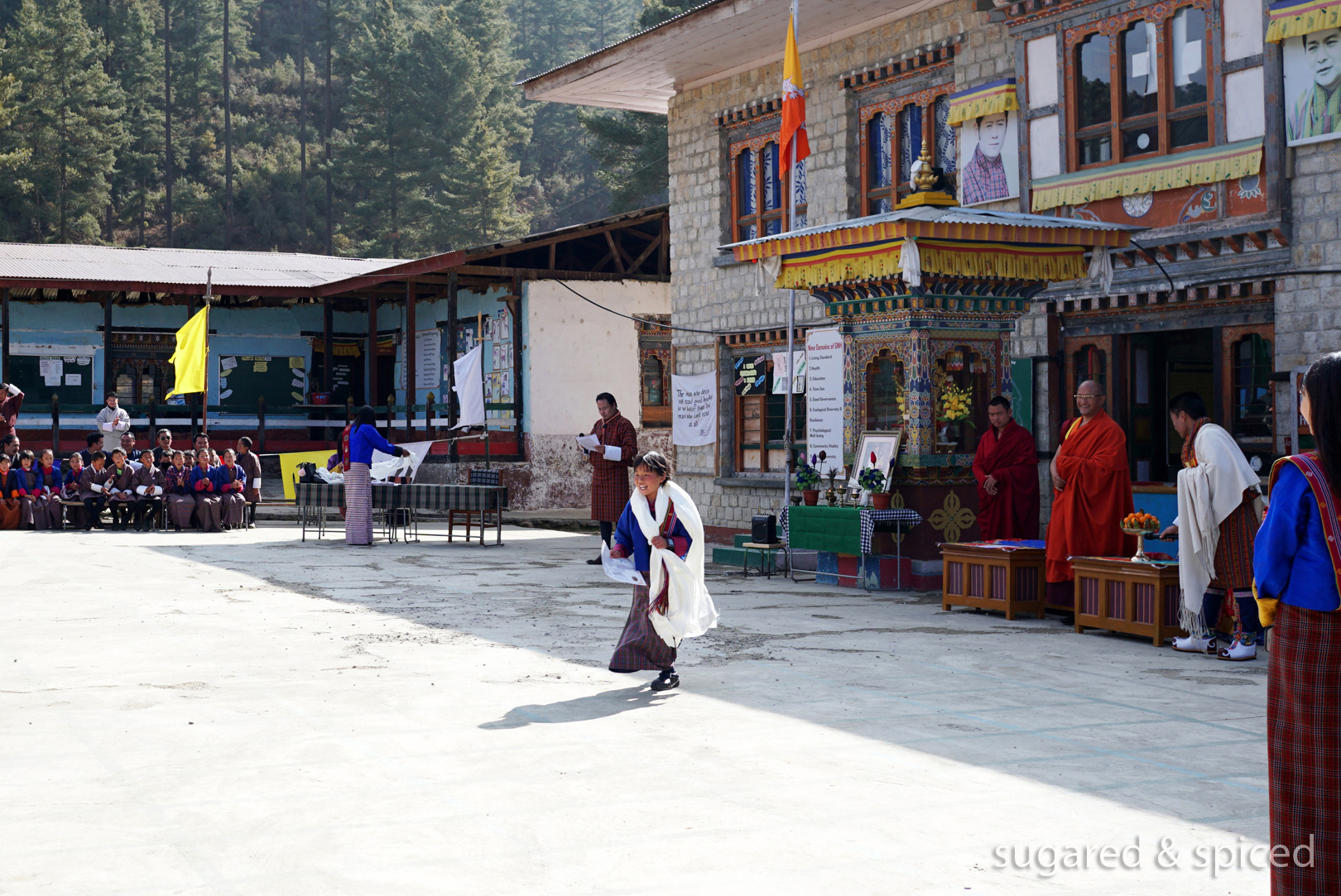
A few villagers observing the assembly on the side.
在一旁觀賞早會的村民們。
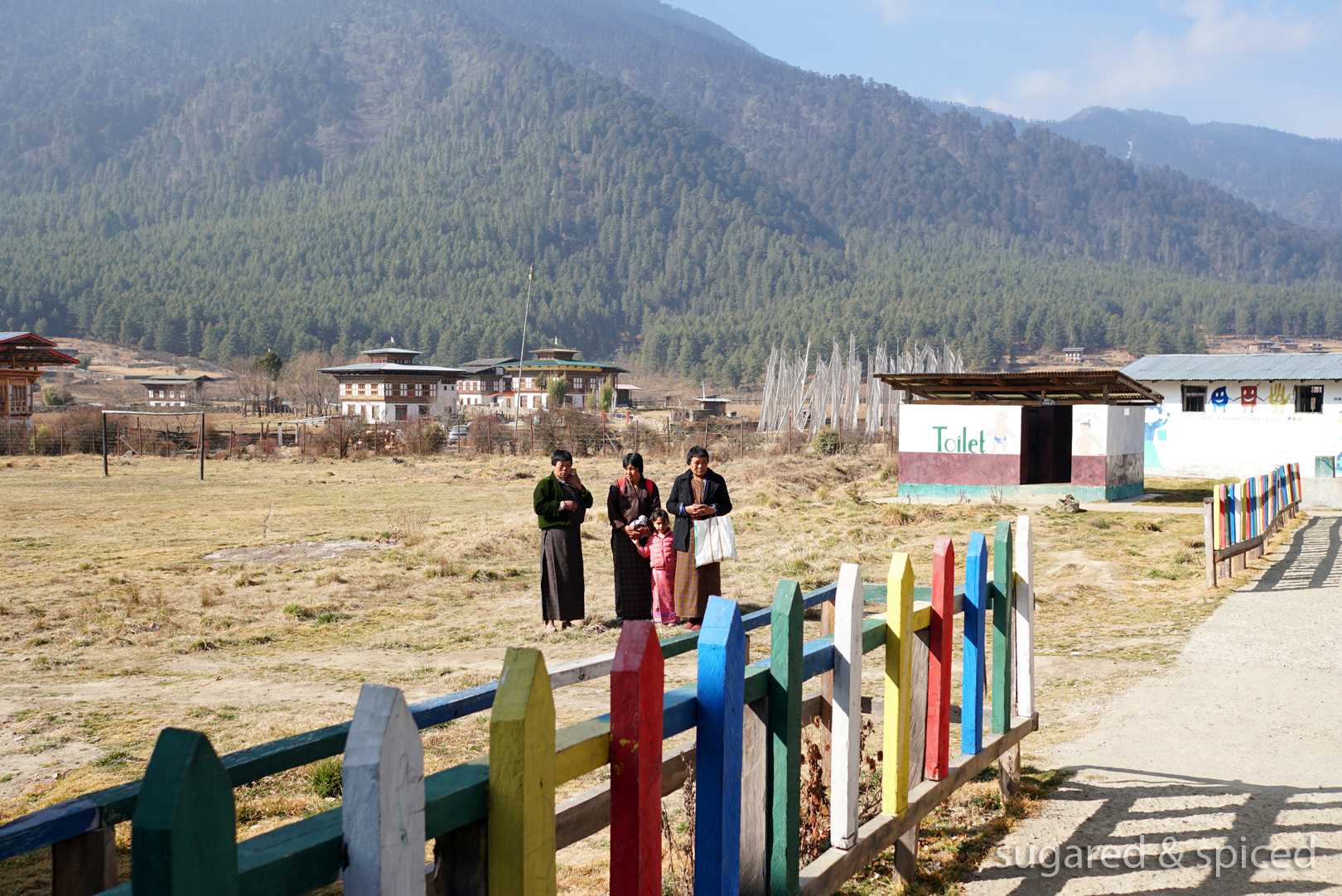
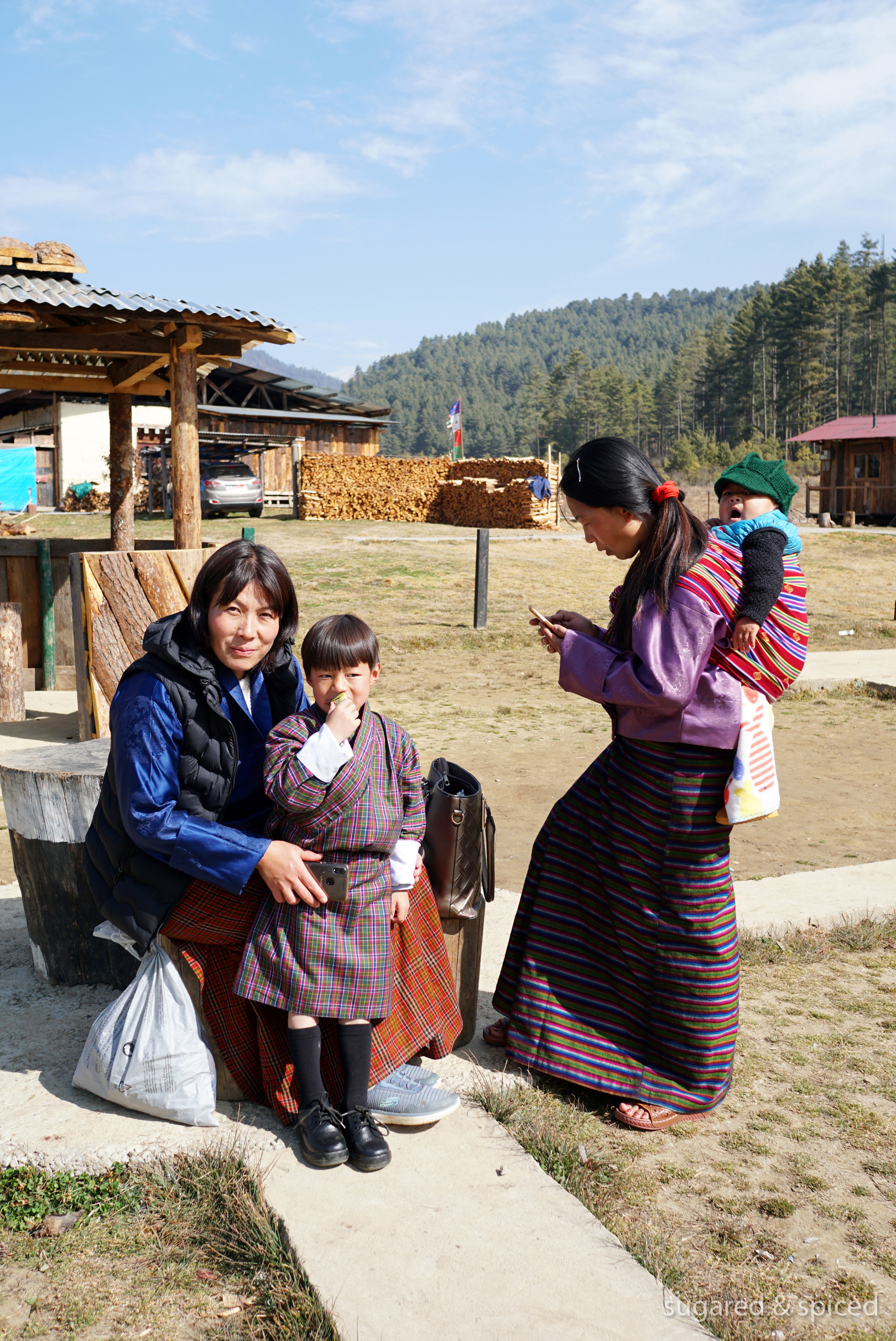
As the celebration drew to an end, students dispersed into their classrooms, and it was time for us to leave Gangtey. As I climbed into our car, I noticed how nicely it had been kept. The floor mat, which would inevitably become dirty at the end of the day due to my muddy shoes (all that hiking, you know), was now clean, and fresh water as well as snacks had been refilled in case we needed an energy boost on the road.
慶祝活動告一段落,學生們回教室上課,我們也該離開了。上車時,我發現 Kinley 將車子打掃得乾乾淨淨,昨晚被我的登山鞋弄髒的地墊已煥然一新,飲用水和零食也早已備好。啊,真是太貼心了。
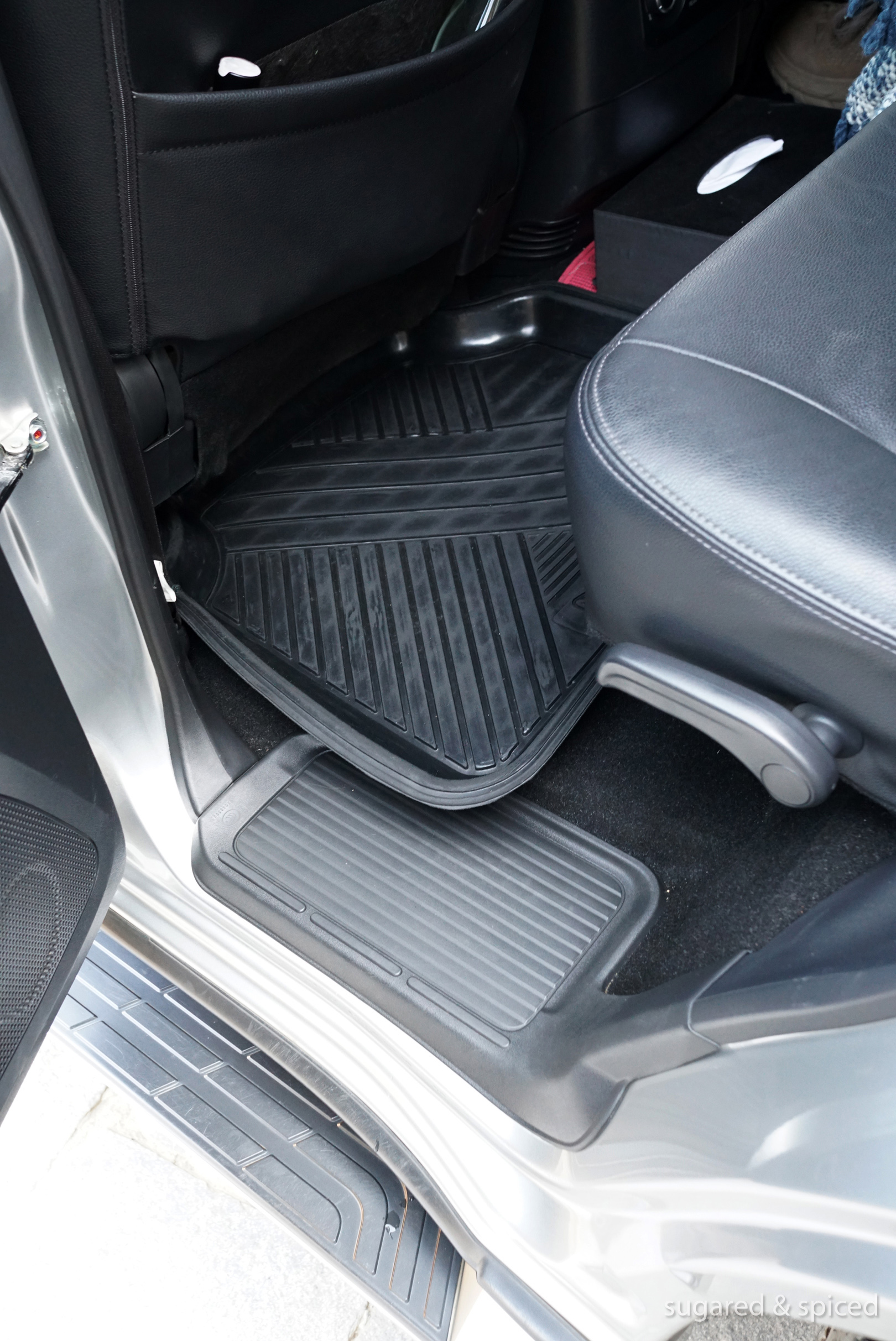
Kinley, our quiet and reliable driver, and Dawa, our jolly and fun-loving guide.
我們安靜可靠的司機先生,以及開心果導遊先生,有他們在就無比安心。
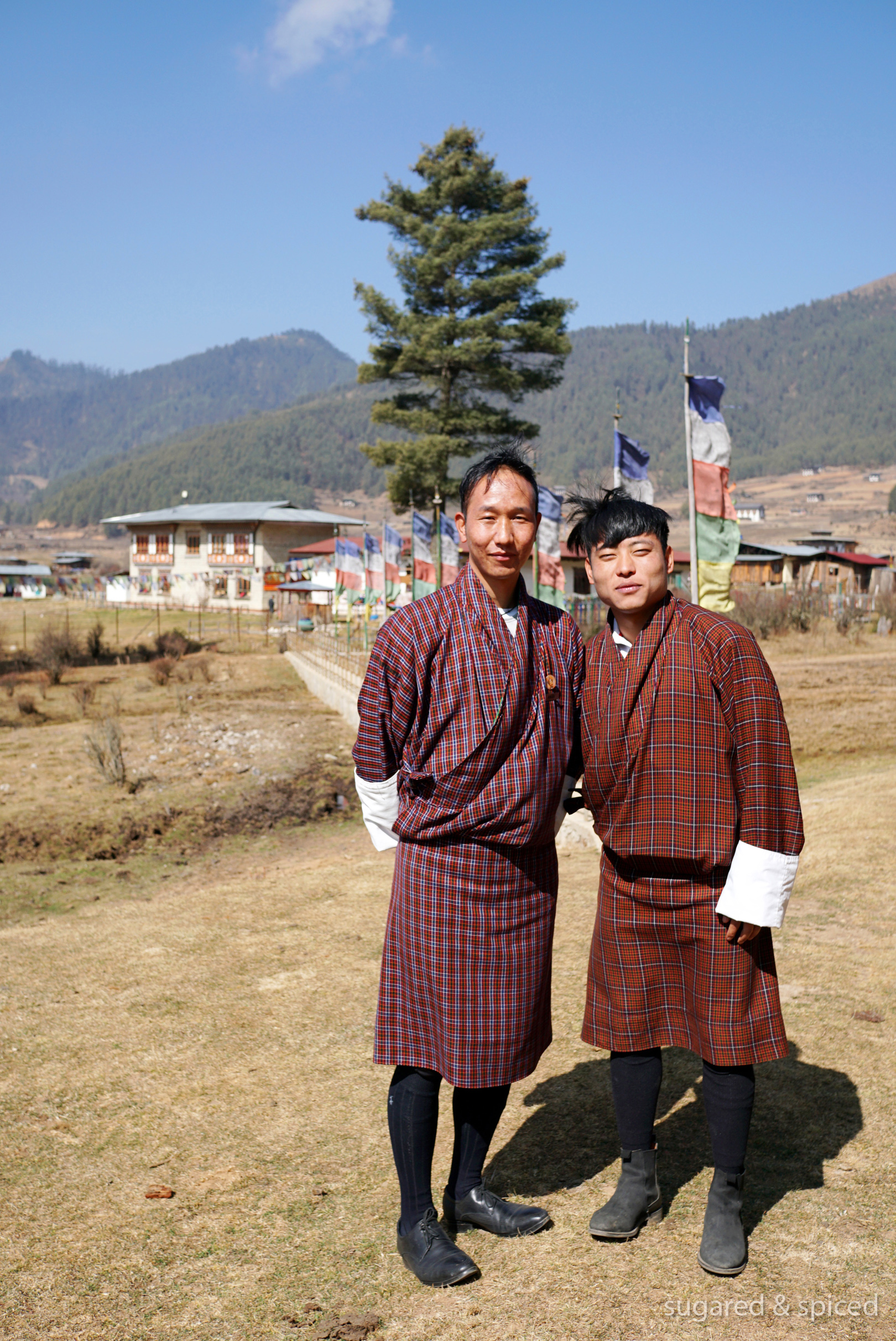
From Gangtey to Punakha, off we went.
離開 Gangtey,前往下一站 Punakha。
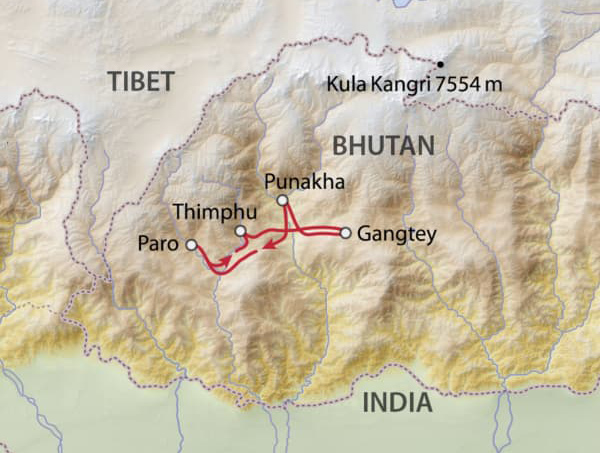
Blue skies, winding roads, yaks, and more yaks.
藍天,曲折的山路,還有成群的氂牛。
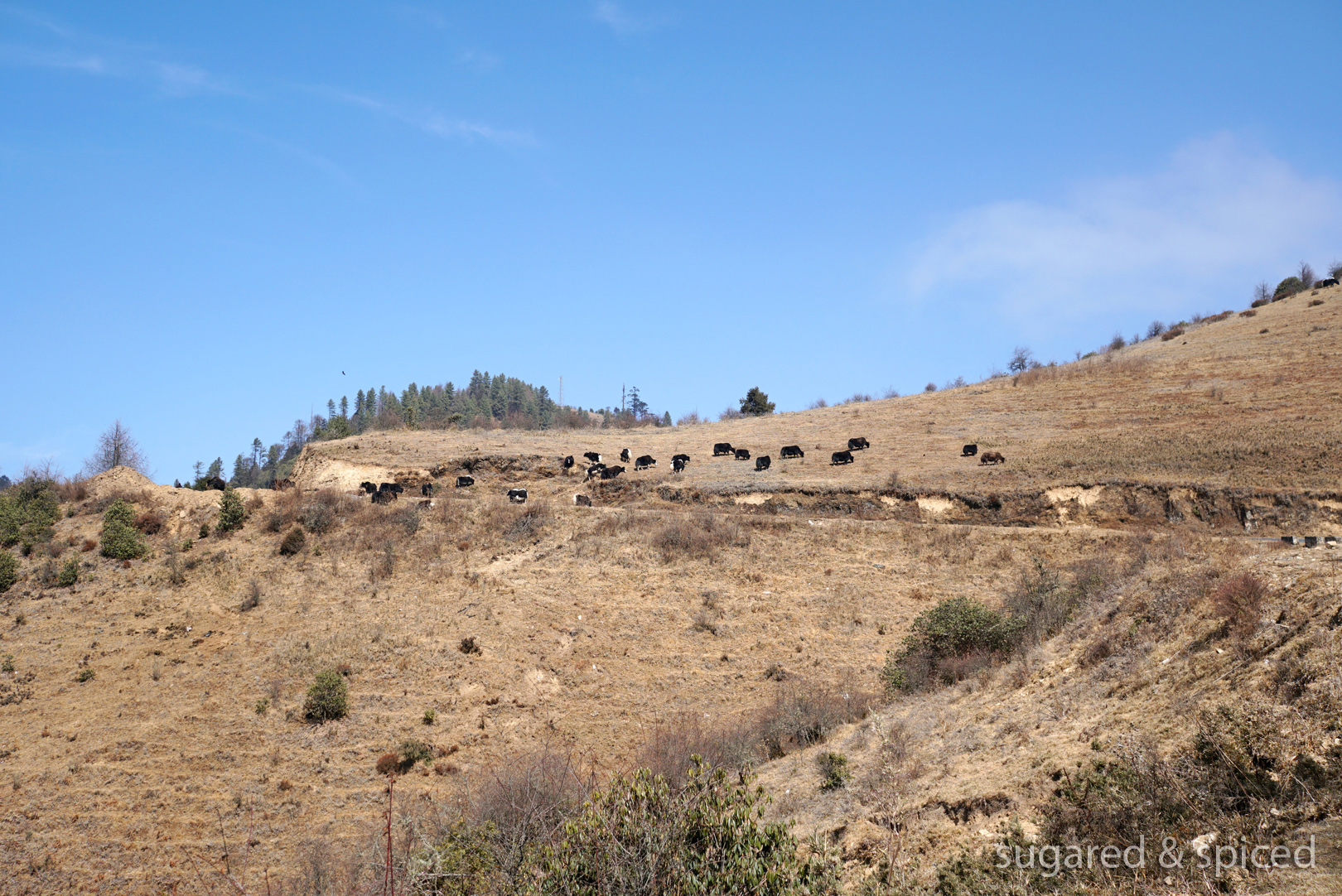
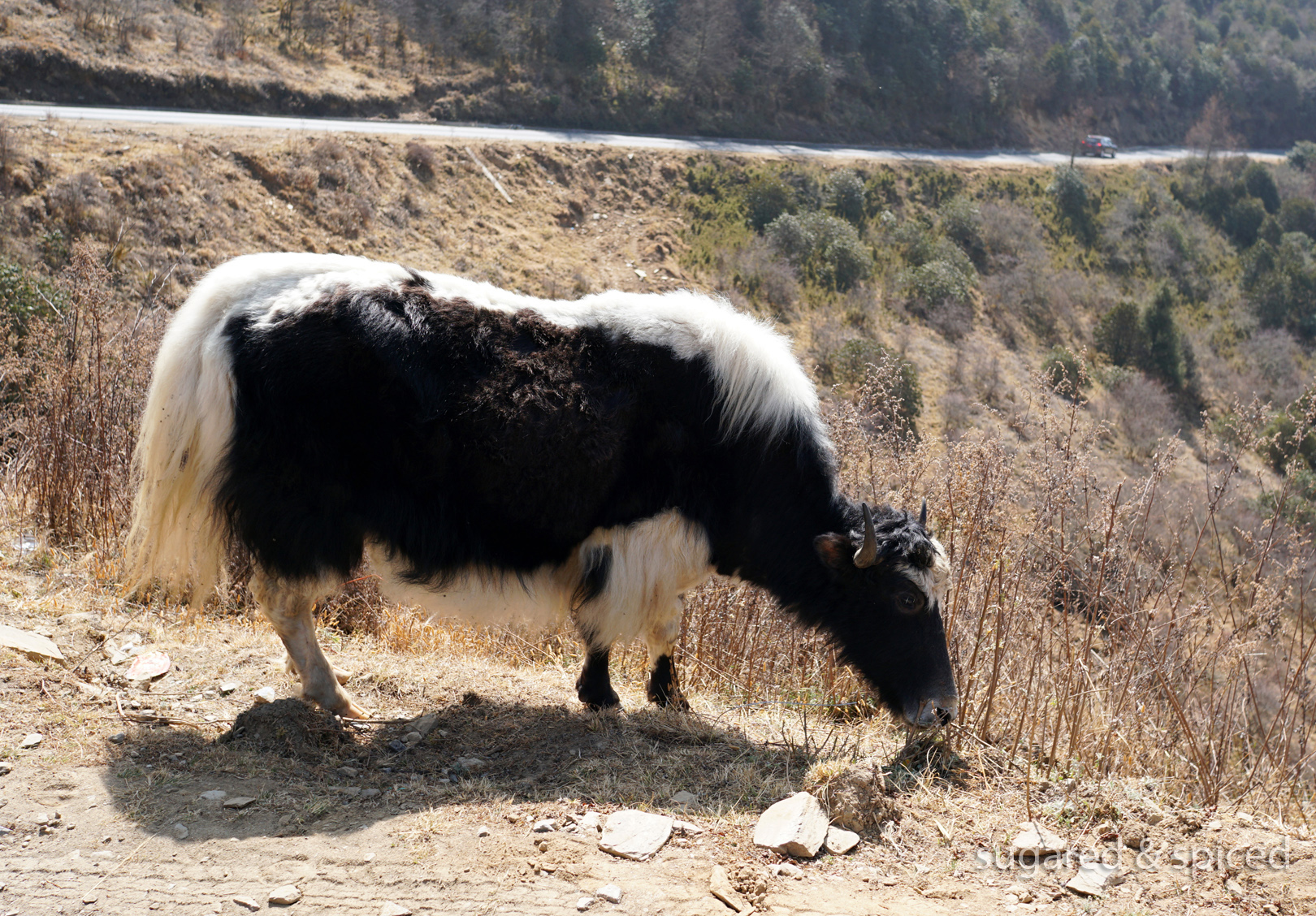
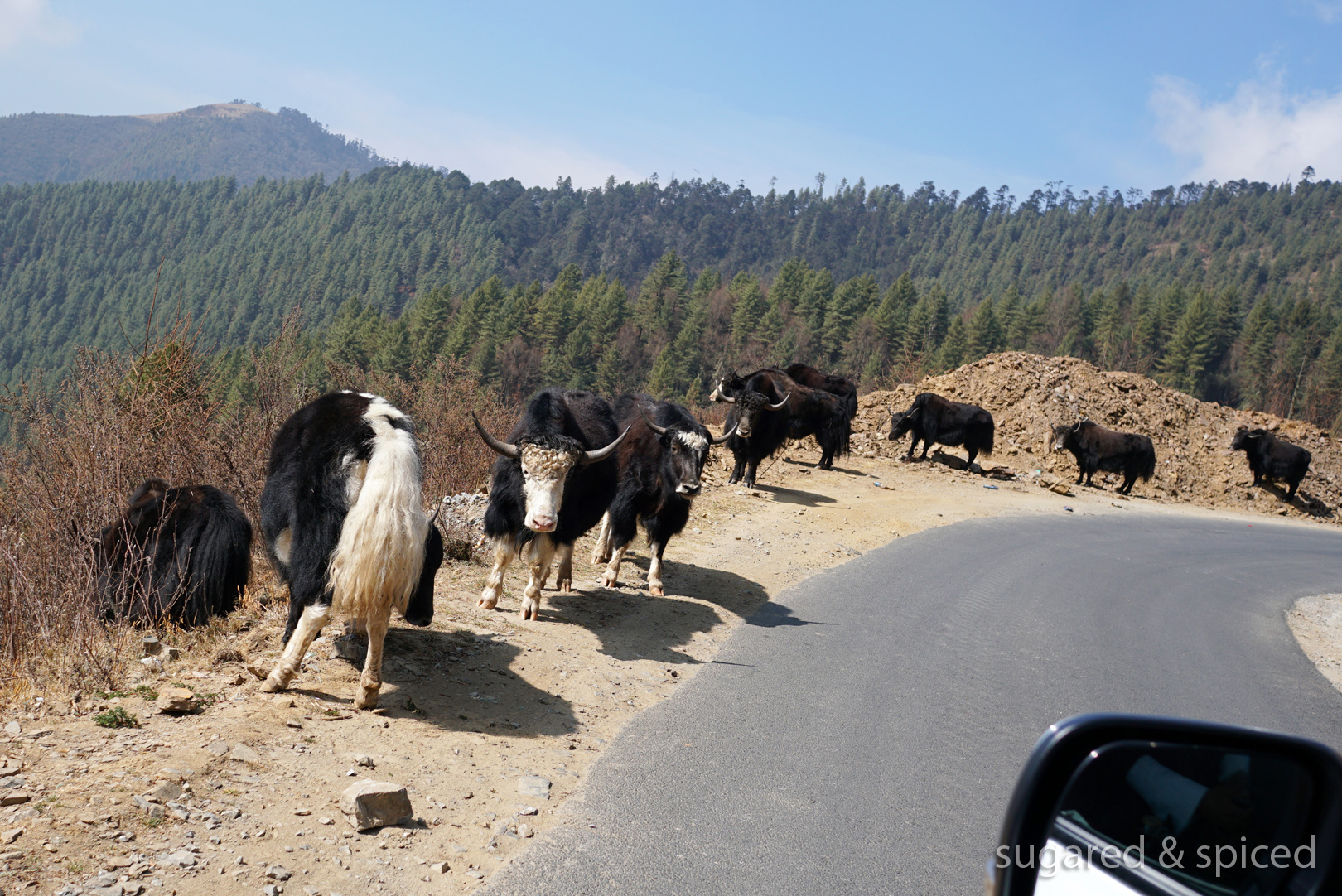
We also spotted some grey langurs, which are apparently quite rare to see.
也很幸運地碰上了罕見的灰葉猴。
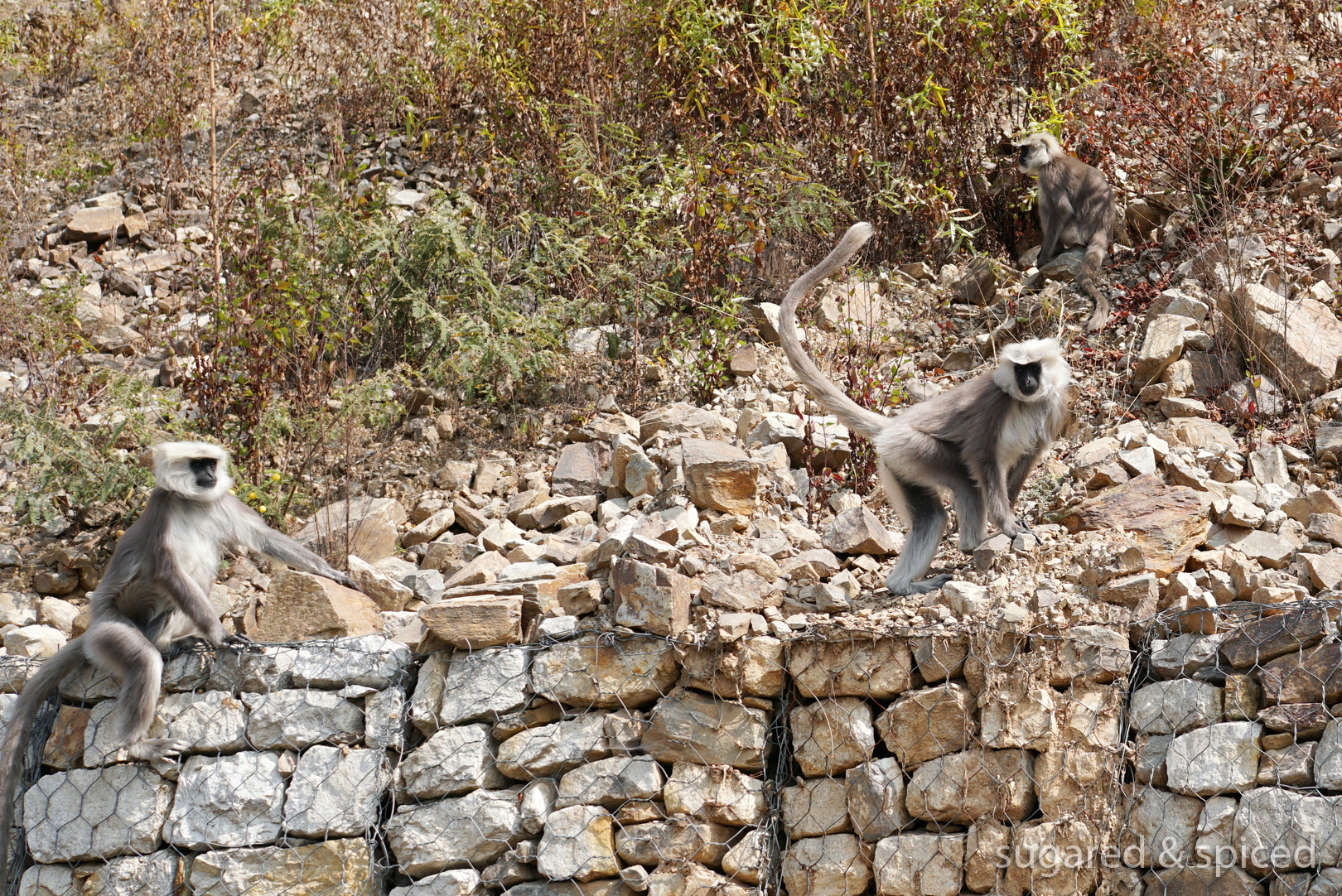
We reached Lawala Pass at 3500 meters in elevation, and while it was less dramatic than Dochula Pass in terms of architecture, it still offered a beautiful view of the valley and the Himalayas in the afar.
開往 Punakha 的路上,途經海拔3500米的 Lawala Pass(拉瓦拉山口)。今日天氣不錯,可以看到遠方的喜馬拉雅山脈。
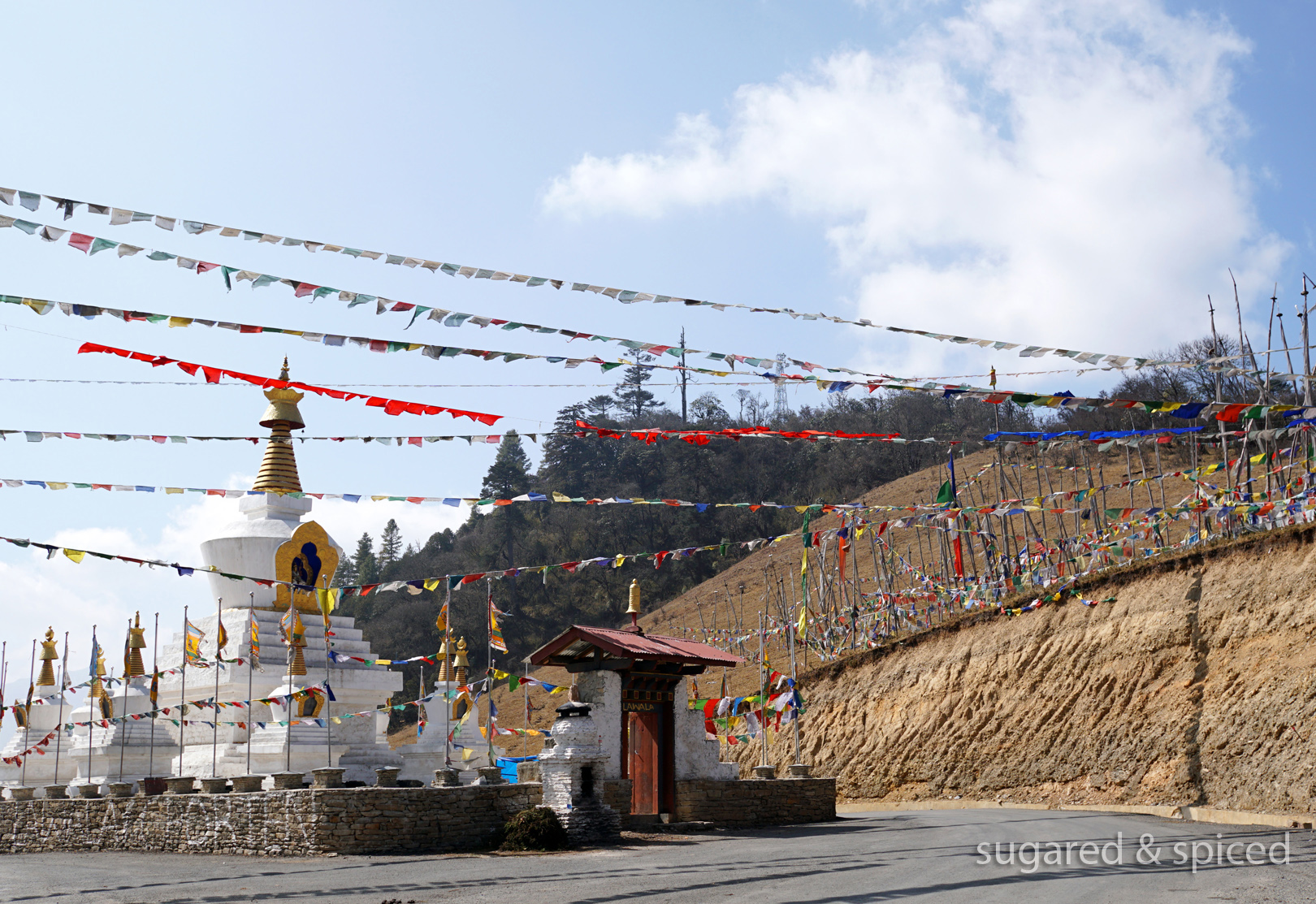
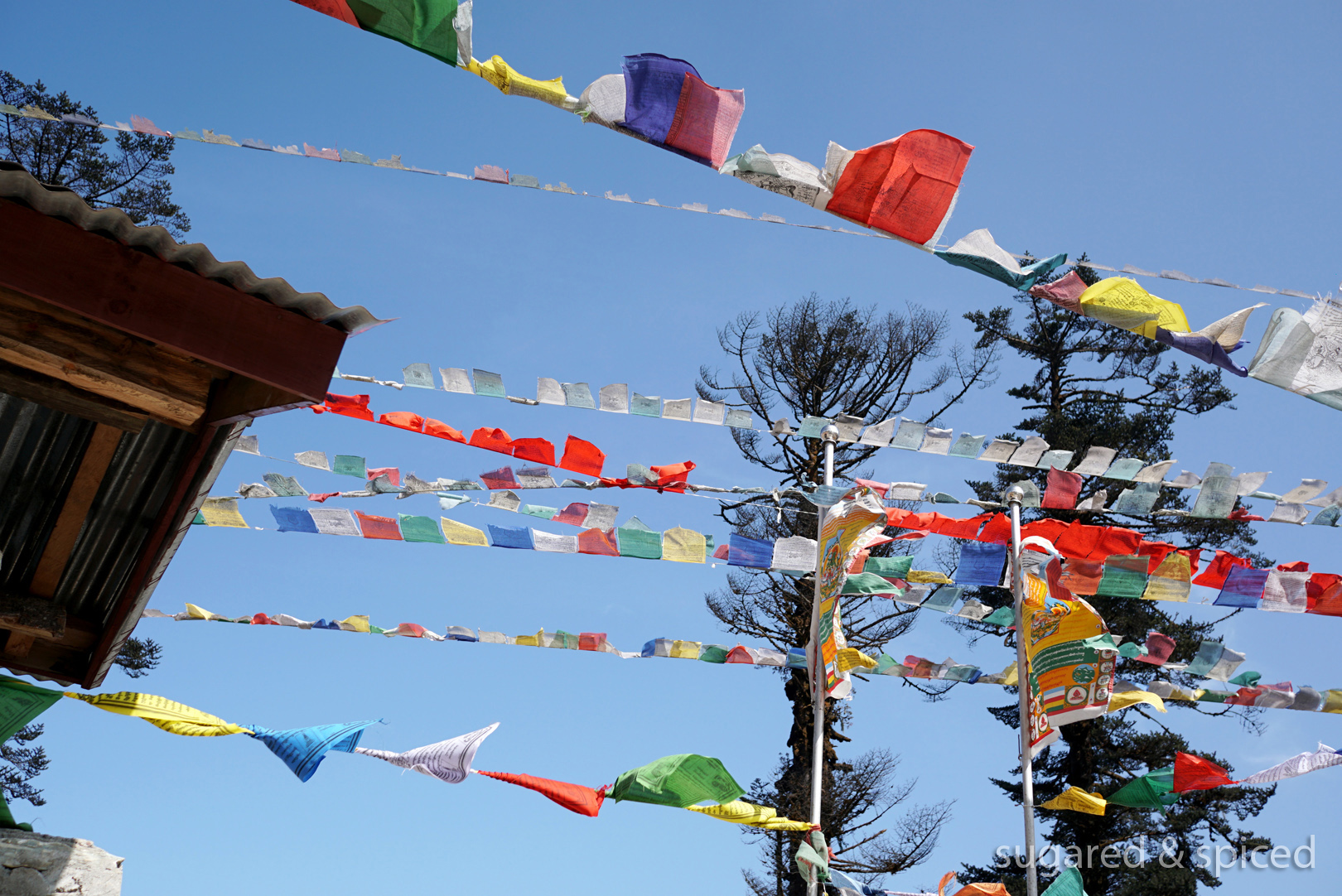
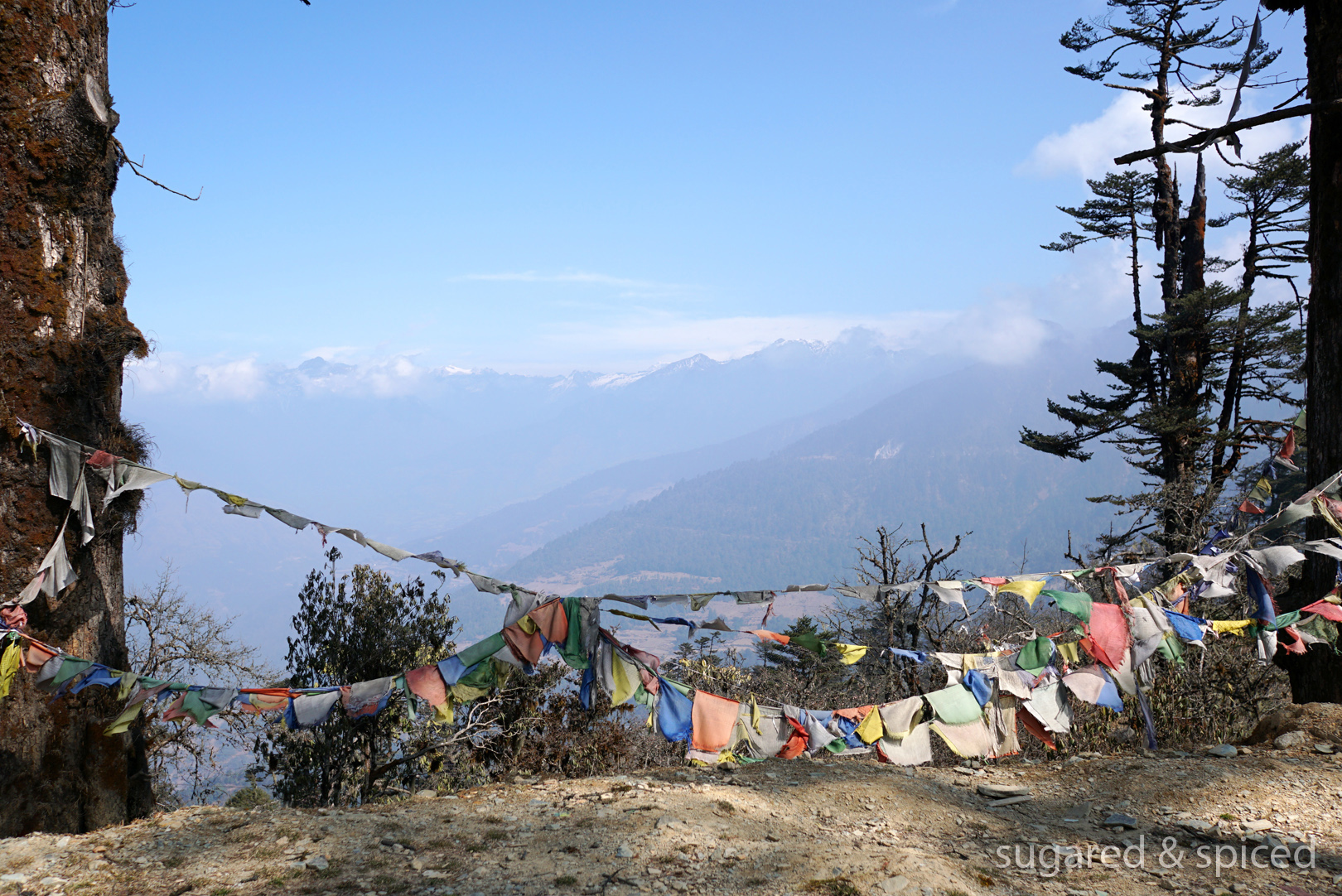
From there on, we descended. Punakha is located at a lower elevation of 1,200 meters, I could feel the temperature rise as we slowly made our way down the curvaceous road. The weather changed from brisk mountain air to semitropical, and acres of rice paddies began terracing the hills. This beautiful valley seemed ripe with promise, it’s no wonder this area is where the Bhutanese royals choose to spend their winters.
Punakha 海拔 “僅” 有1200米,車子沿著蜿蜒山路下降,可以明顯地感覺到溫度攀升。窗外的冷冽山風被亞熱帶特有的溫暖取代,一片富饒的山谷在我們眼前展開。Punakha 的氣候如此怡人,難怪是不丹皇室成員們的避寒勝地。
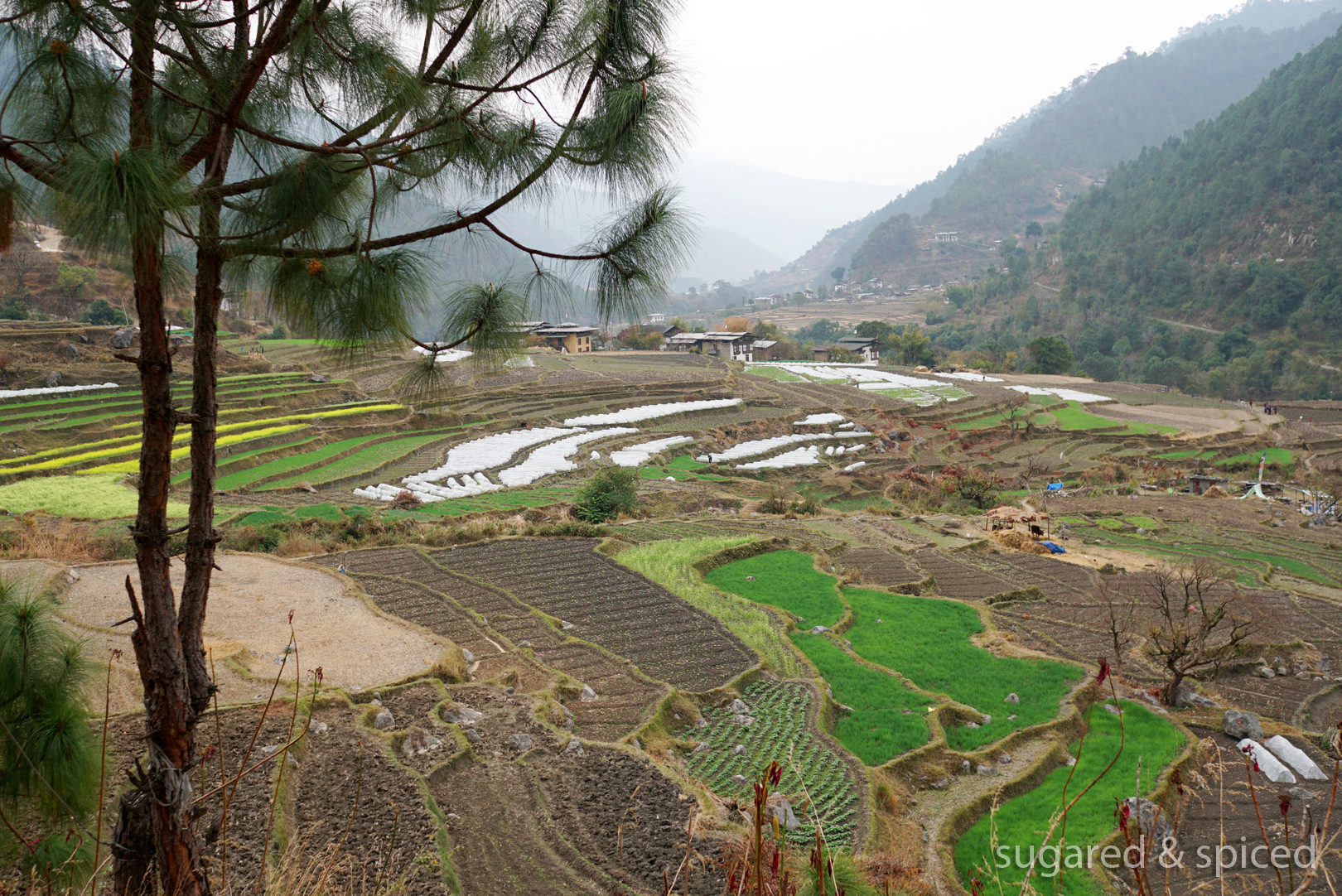
Passing by the magnificent Punakha Dzong, a fortress which we will visit tomorrow.
經過壯觀的 Punakha Dzong,是我們明天要拜訪的景點之一。
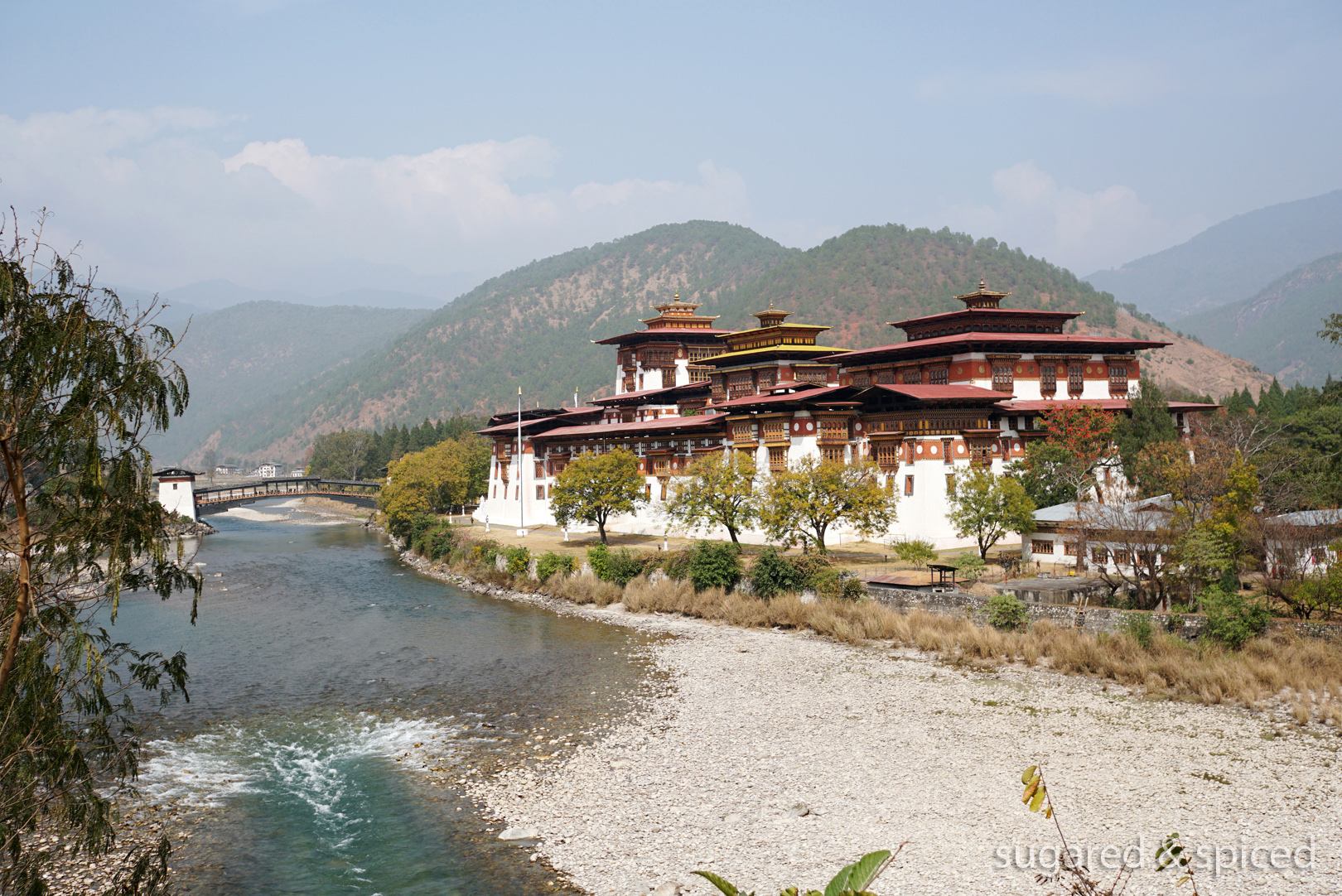
Arrival at Amankora Punakha was rather dramatic: it had to be reached on foot, via a suspension bridge festooned with prayer flags fluttering furiously in the wind. Underneath the bridge, the Mo Chhu River flowed slowly while humming a soft lulling melody, like it was caught up in the sunlight and wanted to stay.
車子沿著 Mo Chhu(母河)河畔一路順順地開著,突然停在一座吊橋邊。Amankora Punakha 就在彼岸,需要步行穿過吊橋才能抵達。橋上掛滿了五色風馬旗,在風中呼呼啦啦地飄揚;橋下的河水輕輕低吟,感覺像是曬著太陽十分舒服,想多逗留片刻,所以特意流得緩慢…
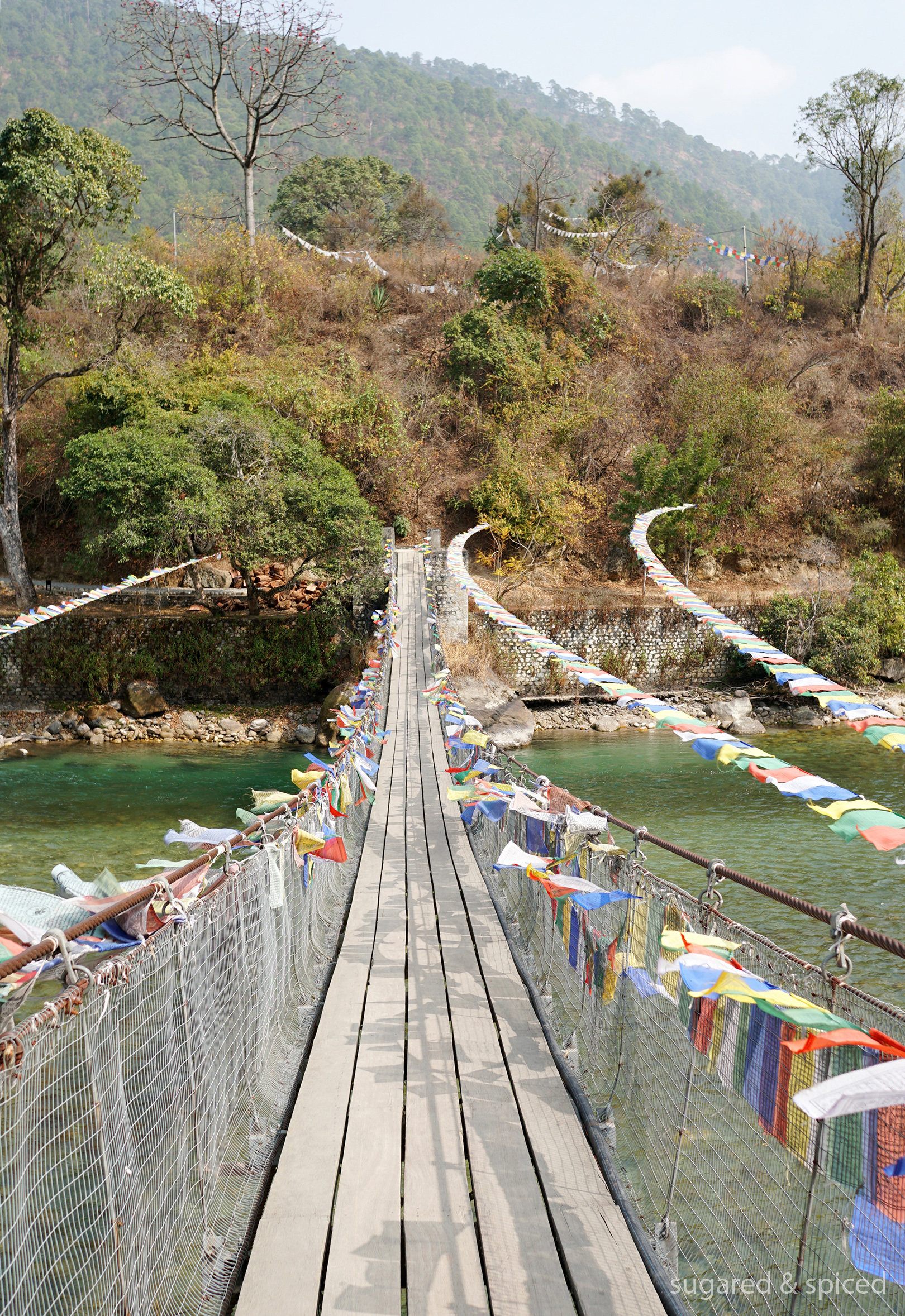
At the other end, a staff awaited us with scrolls of prayer flags in his hands. Traditionally, these flags come in sets of five colors, arranged from left to right in a specific order, each representing a different element: blue (sky), white (air), red (fire), green (water), and yellow (earth). It’s believed that health and harmony are produced through the balance of these five elements.
As previously mentioned, prayer flags are usually positioned to catch the wind so that with each flutter, the printed mantra can be released into the air. We considered hanging the flags on this suspension bridge, or perhaps on one of the mountain tops we will hike to, but in the end decided to take them home, where we will be sure to find a windy spot to spread the positivity far and wide.
在橋的另一端,服務人員已恭候多時,手裡捧著要送給我們的風馬旗。五種顏色代表不同元素,有固定的排列順序:藍(天)- 白(氣)- 紅(火)- 綠(水)- 黃(土)。五種元素的平衡能帶來健康與和諧,而旗子上的咒幔會隨風飄送四面八方,彷彿日以繼夜地誦頌著真經。
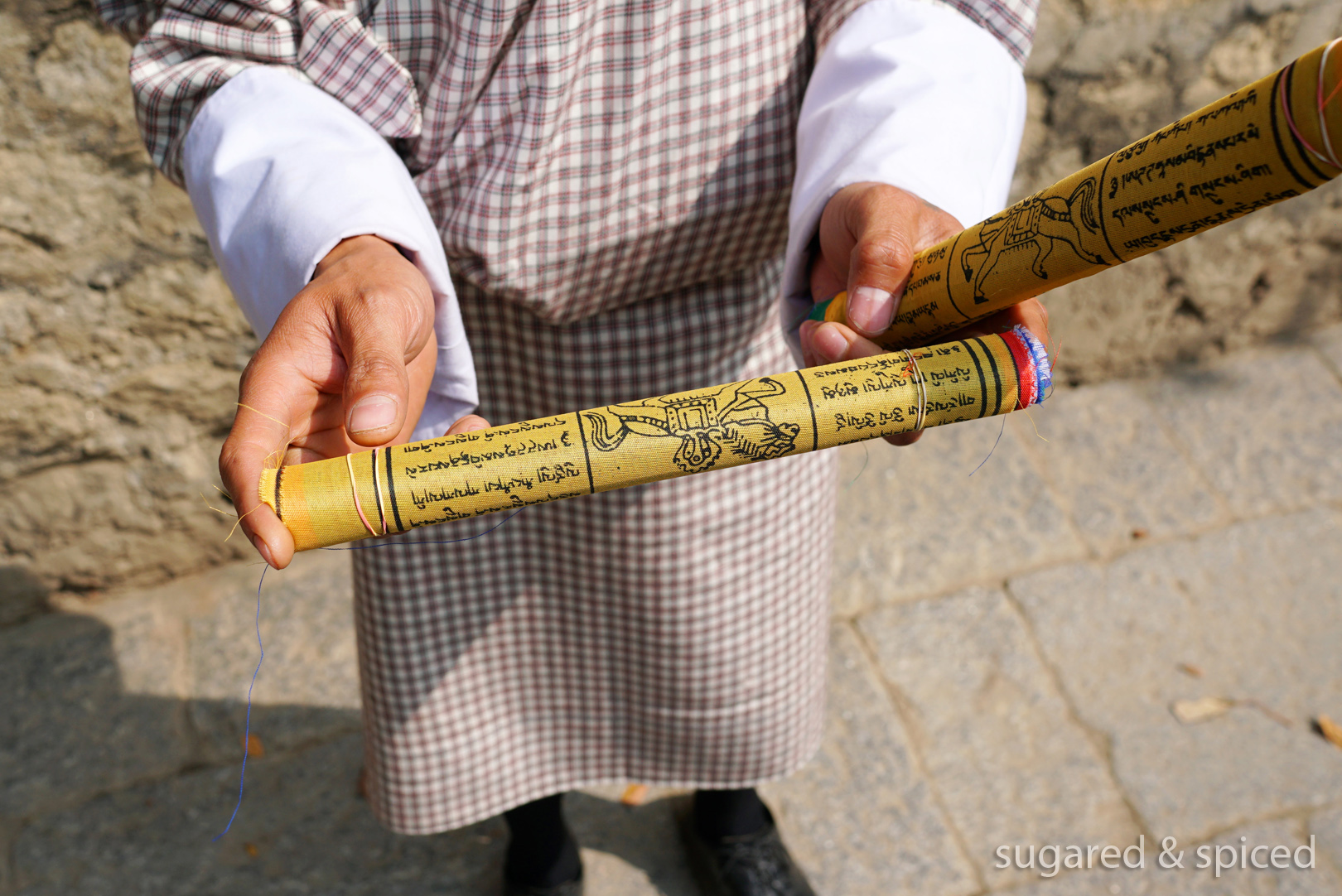
A short buggy ride later, we arrived at Amankora Punakha. It was immediately obvious that this lodge had a drastically different ambience from the previous two we stayed at. Instead of being surrounded by a field of tall, majestic blue pines, we were now in a manicured garden of orange trees and poinsettia bushes.
坐上接駁車穿過一片樹林,進入 Amankora Punakha。小巧精緻的庭院裡種著橘子樹和印度木棉,與之前在 Gangtey 被挺拔松樹環繞的氛圍完全不同,少了蒼勁飄渺,多了雕琢雅緻。
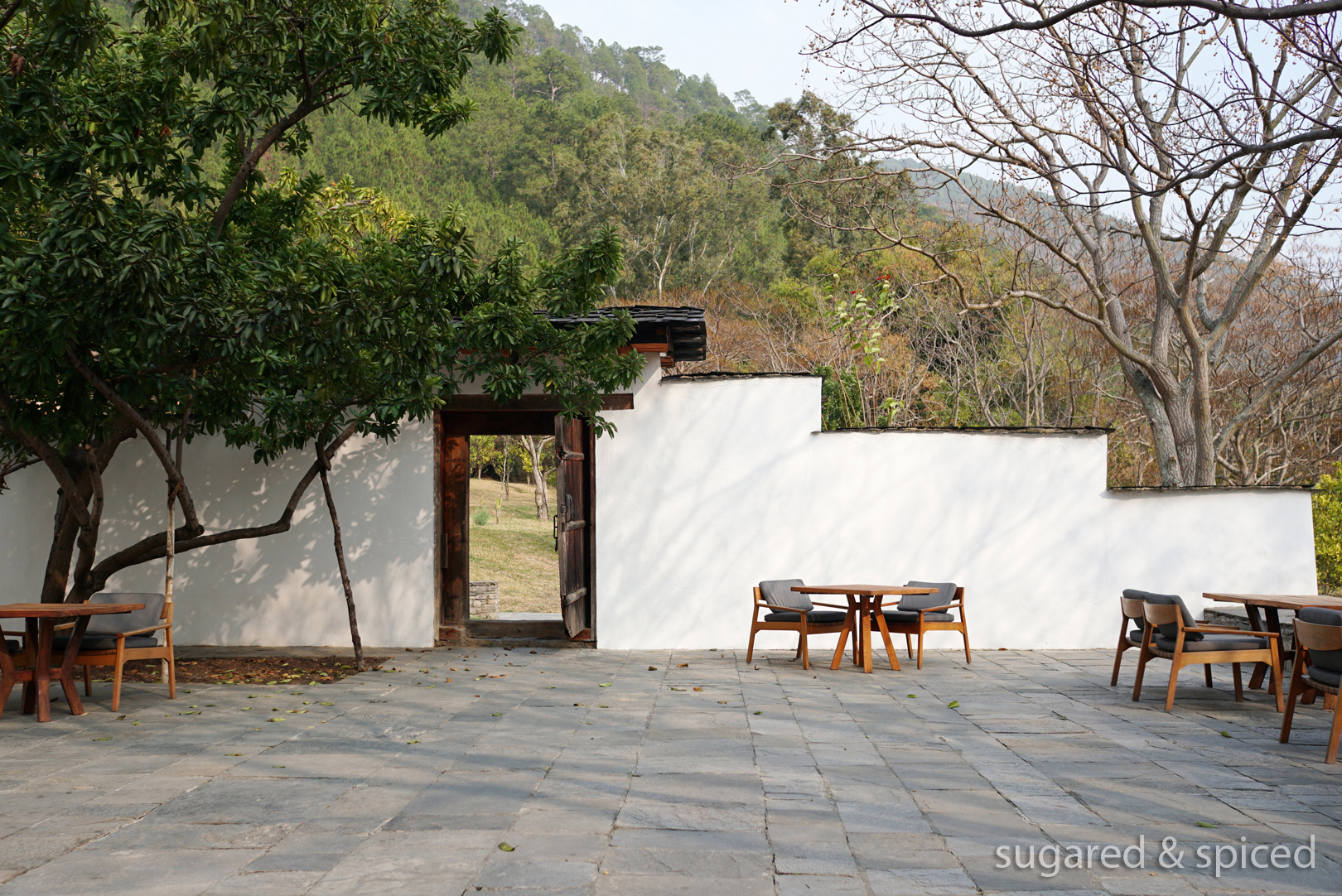
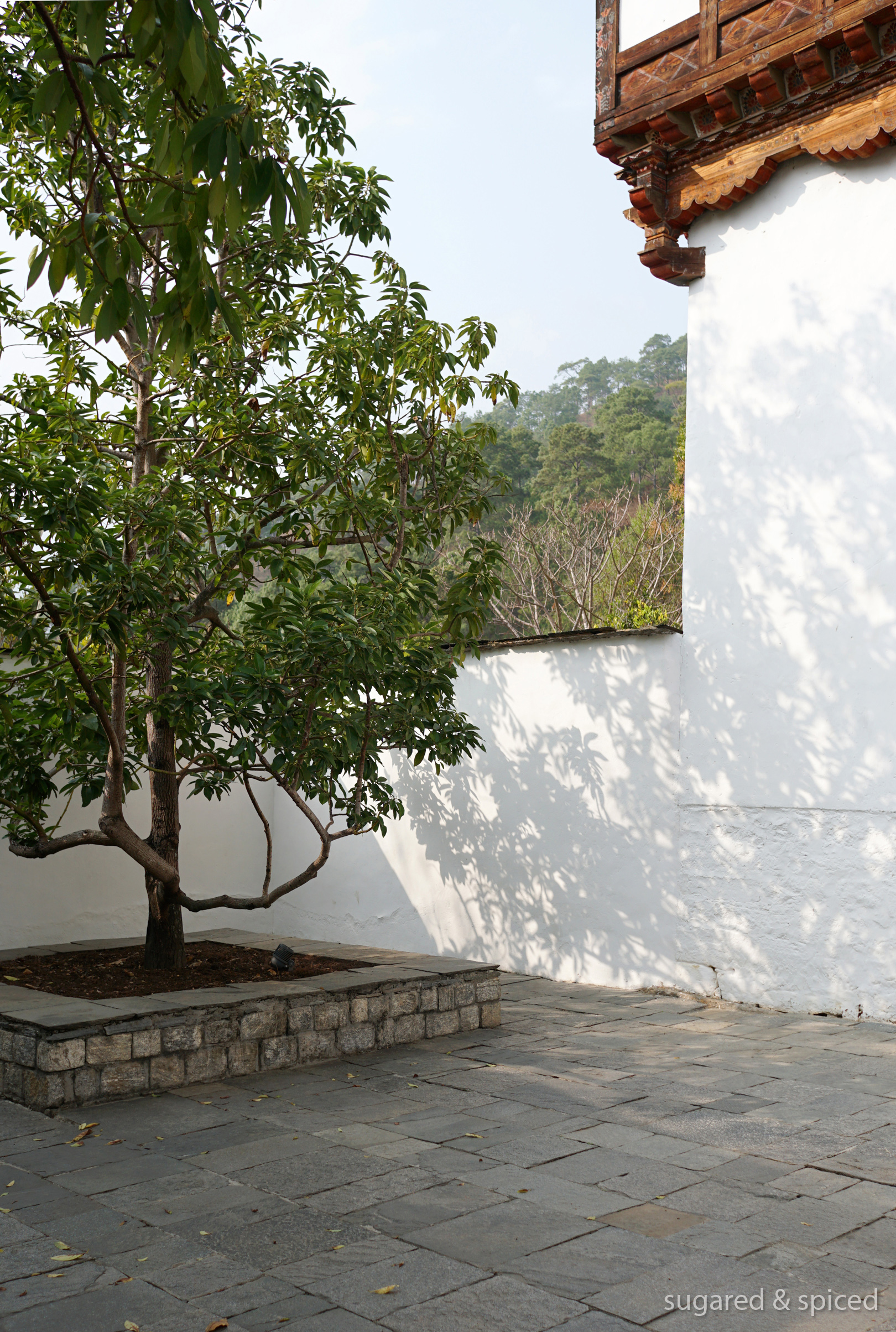
And instead of hot apple juice or hot ginger tea, we were served ice-cold pomegranate sodas. Even the staff’s uniform was of a lighter color, matching the spring vibe of this valley. Indeed, it was another season entirely!
迎賓飲料從熱呼呼的蘋果汁和蜂蜜薑茶變成冰鎮石榴汽水,服務人員的著裝也換成清爽色調。這裡,完全是另一個季節了。
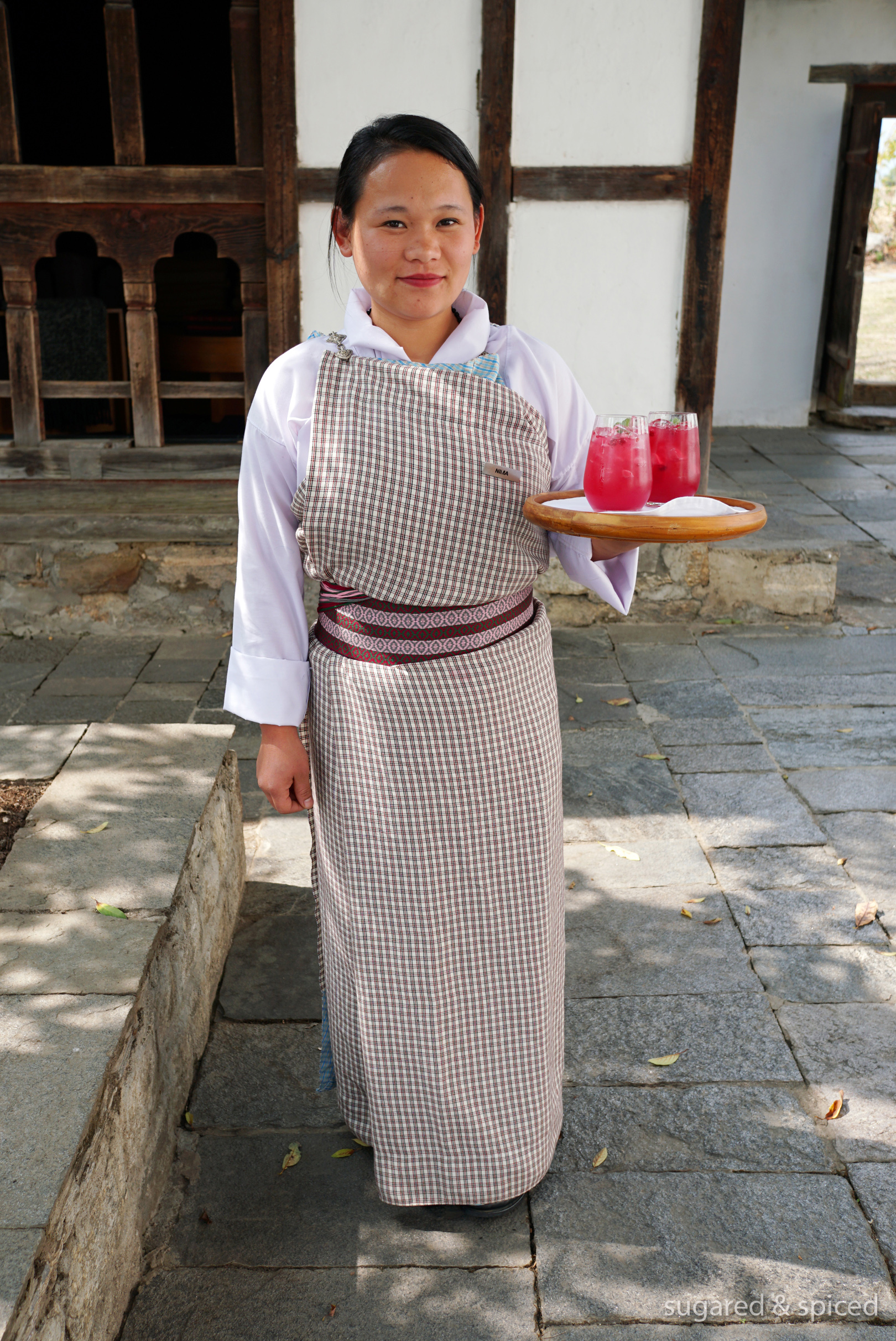
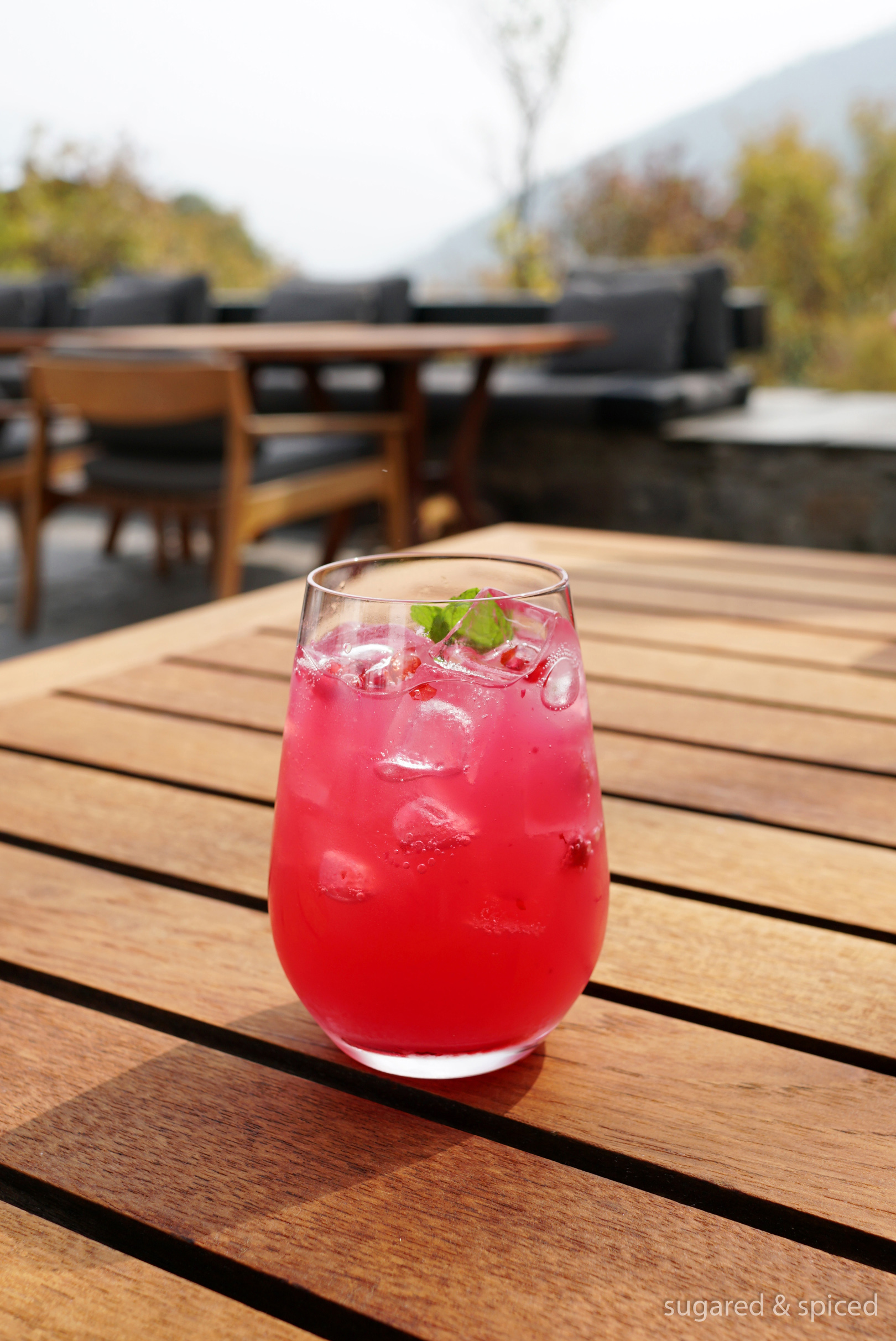
The centerpiece of the lodge is a traditional Bhutanese farmhouse, built by a former Je Khenpo (chief abbot of Bhutan) as his residence and later bequeathed to one of Bhutan’s Queen Mothers upon his passing. This structure had been meticulously maintained over the years, and now functions as the dining room, living room, and prayer space of Amankora Punakha.
庭院中心的傳統建築原是某任國師給皇太后的遺贈,由於安縵創始人與不丹皇室交情甚深,Amankora Punakha 才得以借用這幢美麗的屋子,做為給客人休憩的空間。
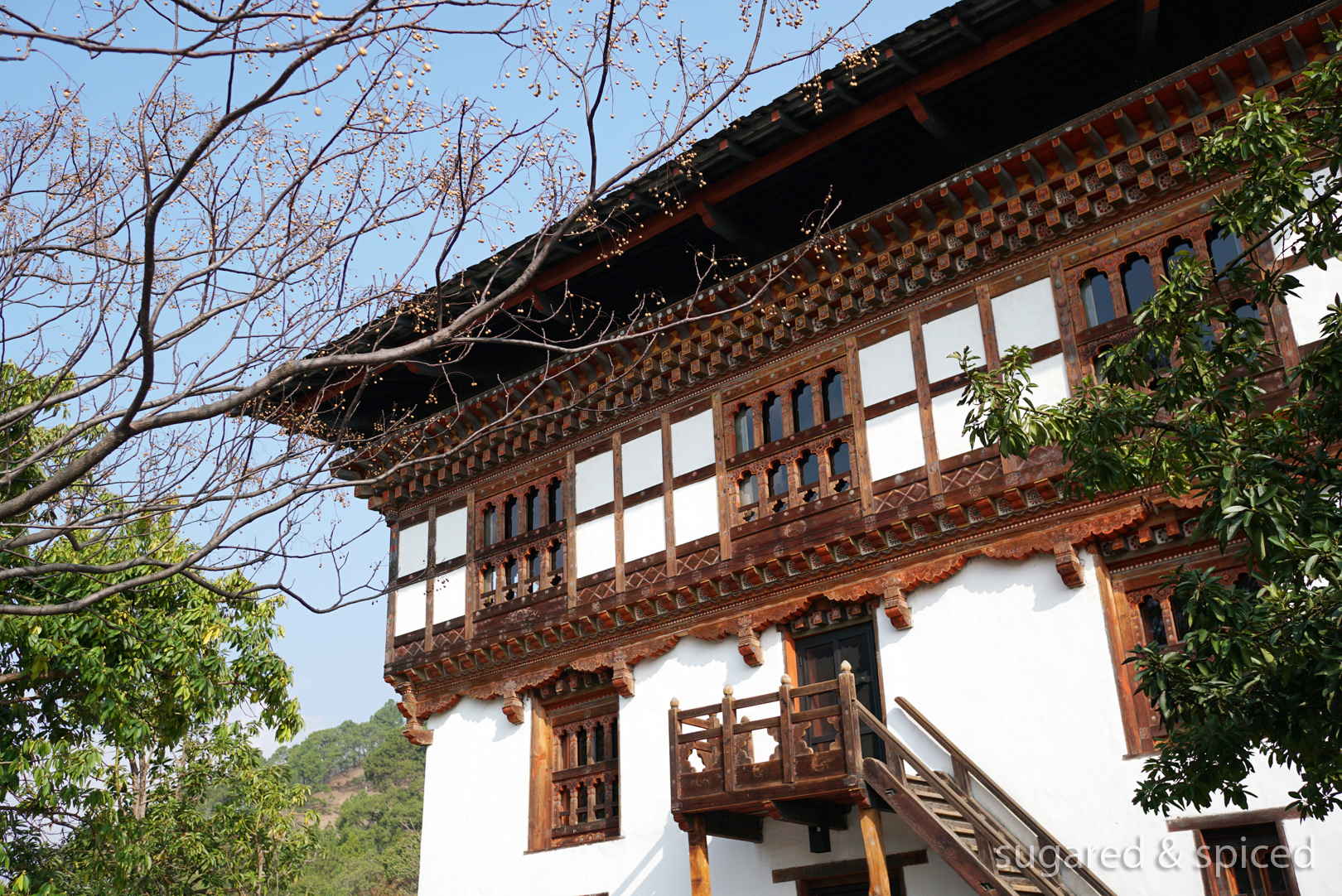
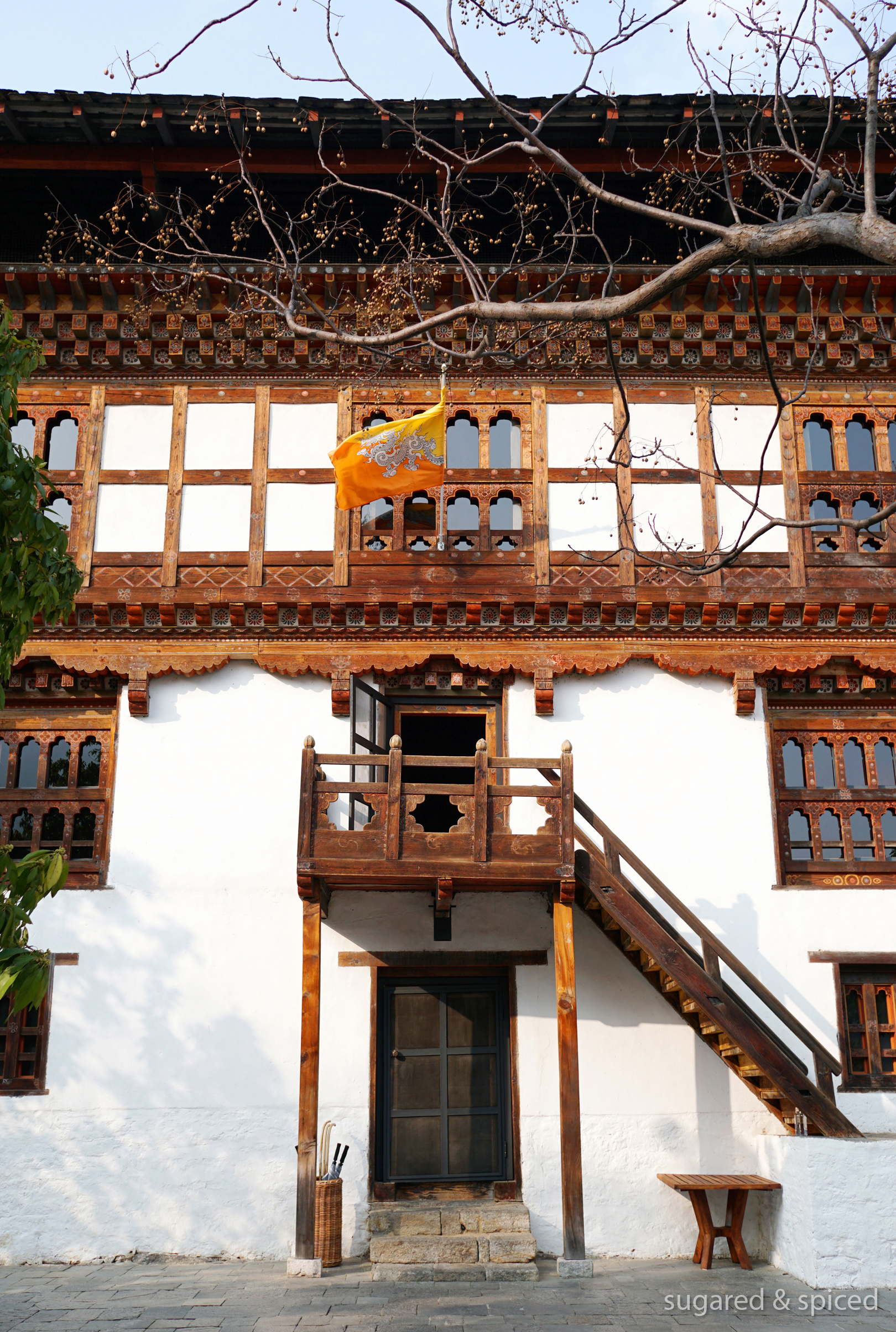
The first floor houses a dining space with two large communal tables. Upstairs are a few living rooms, rendered extra cosy with the afternoon sun streaming through gorgeously carved windows.
在整理這間老屋時,安縵刻意修舊如舊,留下歲月的韻味。午後柔和的陽光穿過木窗滲入室內,有種時空凝結的錯覺。
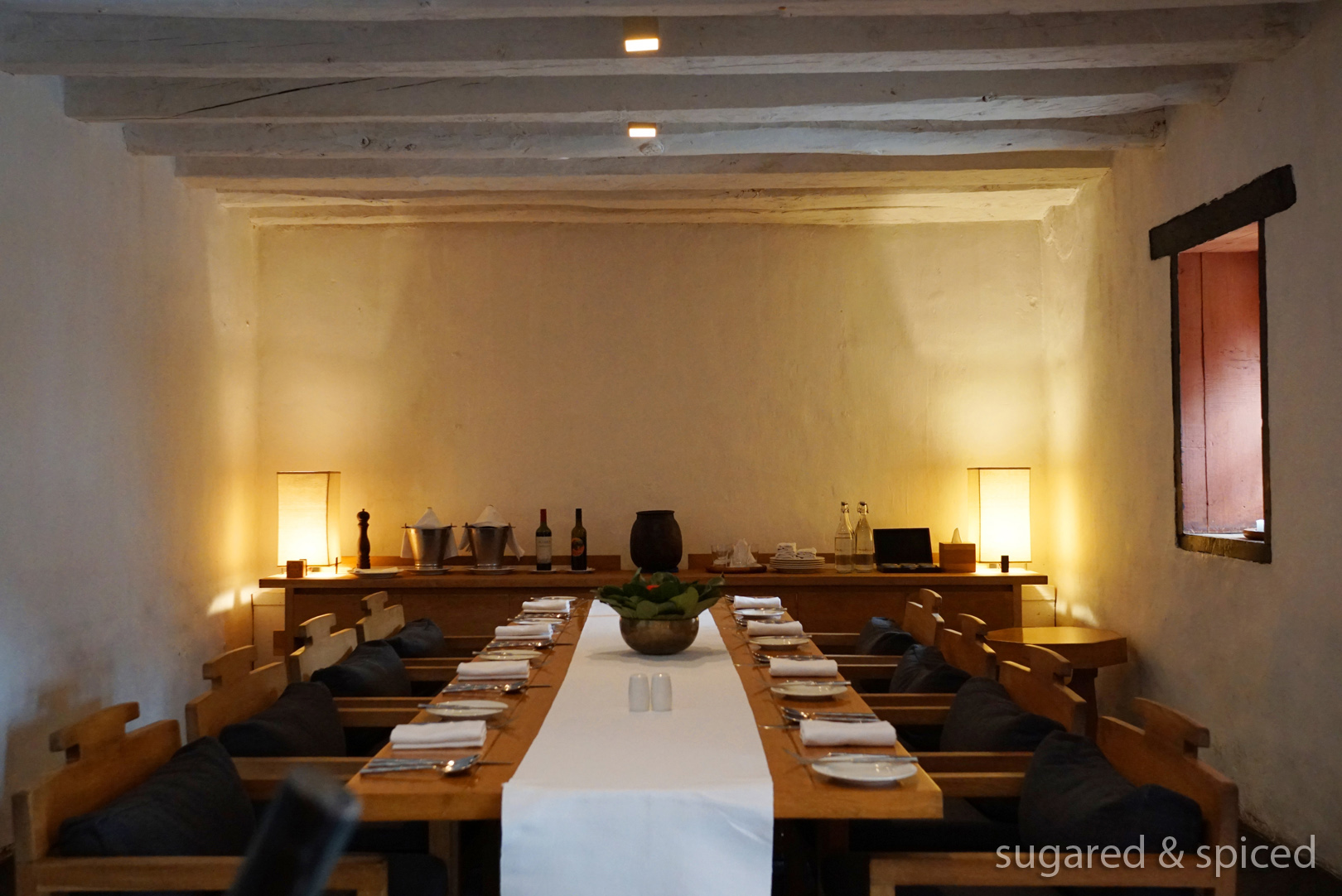
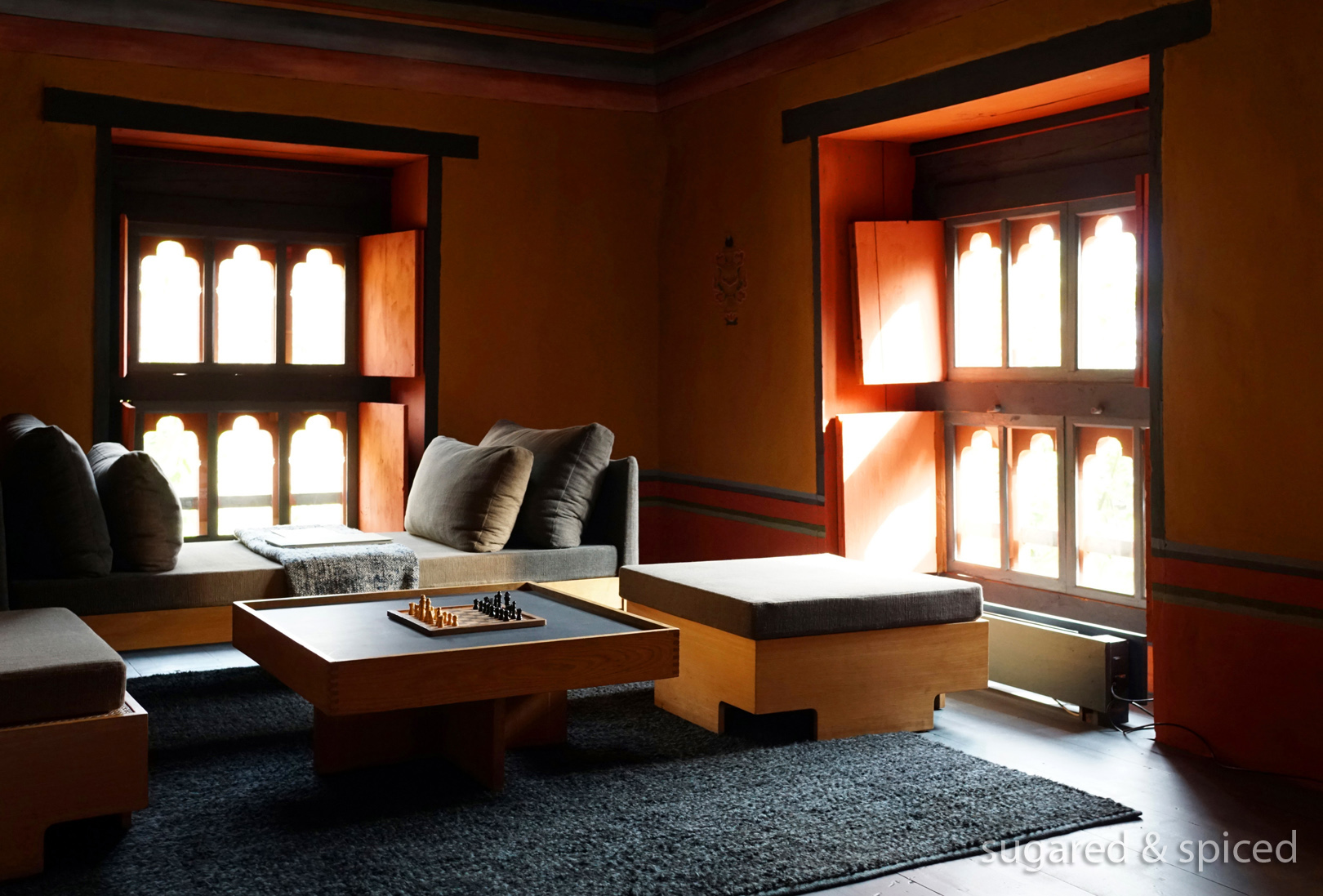
Charming wall paintings, colored with traditional vegetable dye.
年代久遠的別緻壁畫,由植物天然的色彩繪製而成。
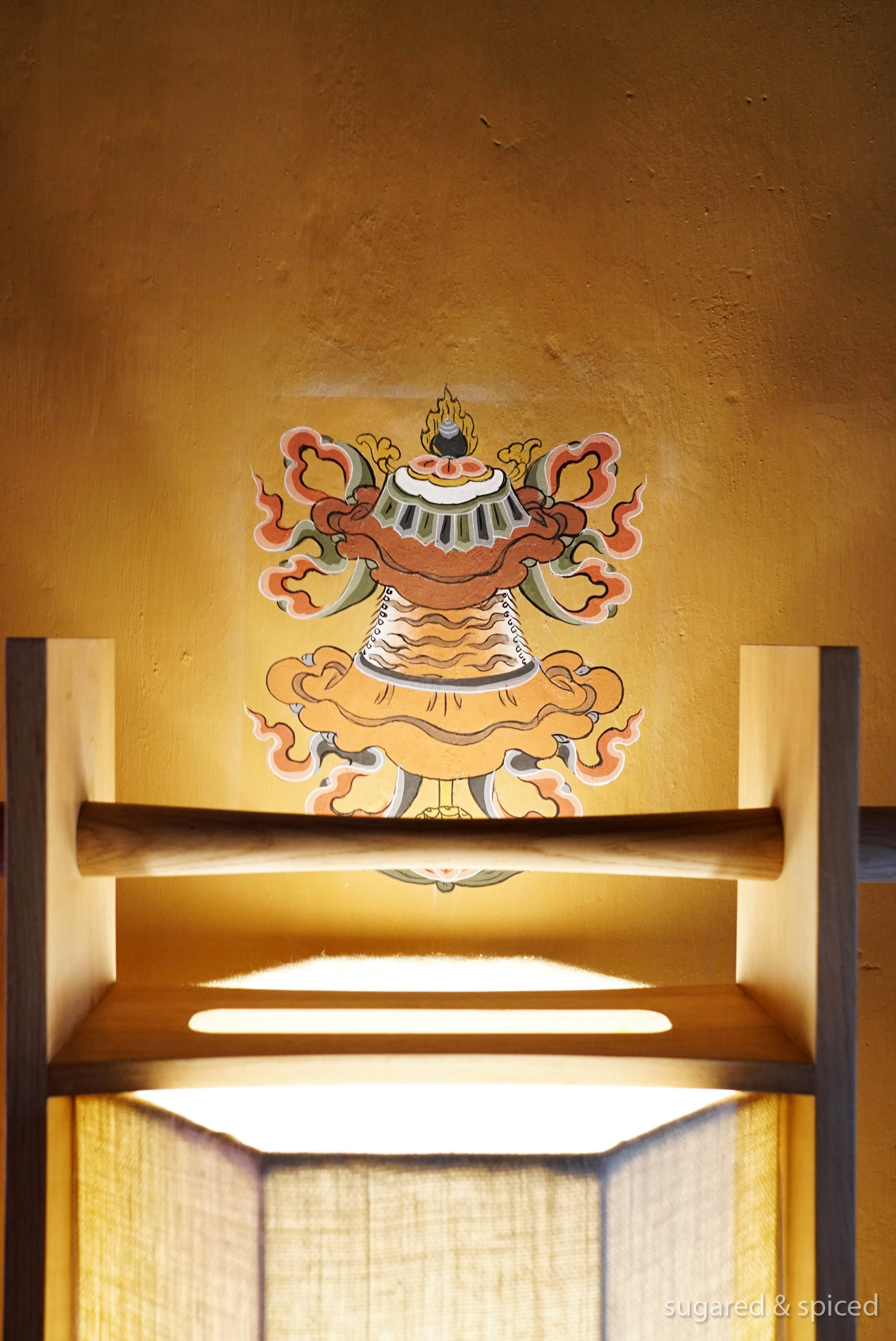
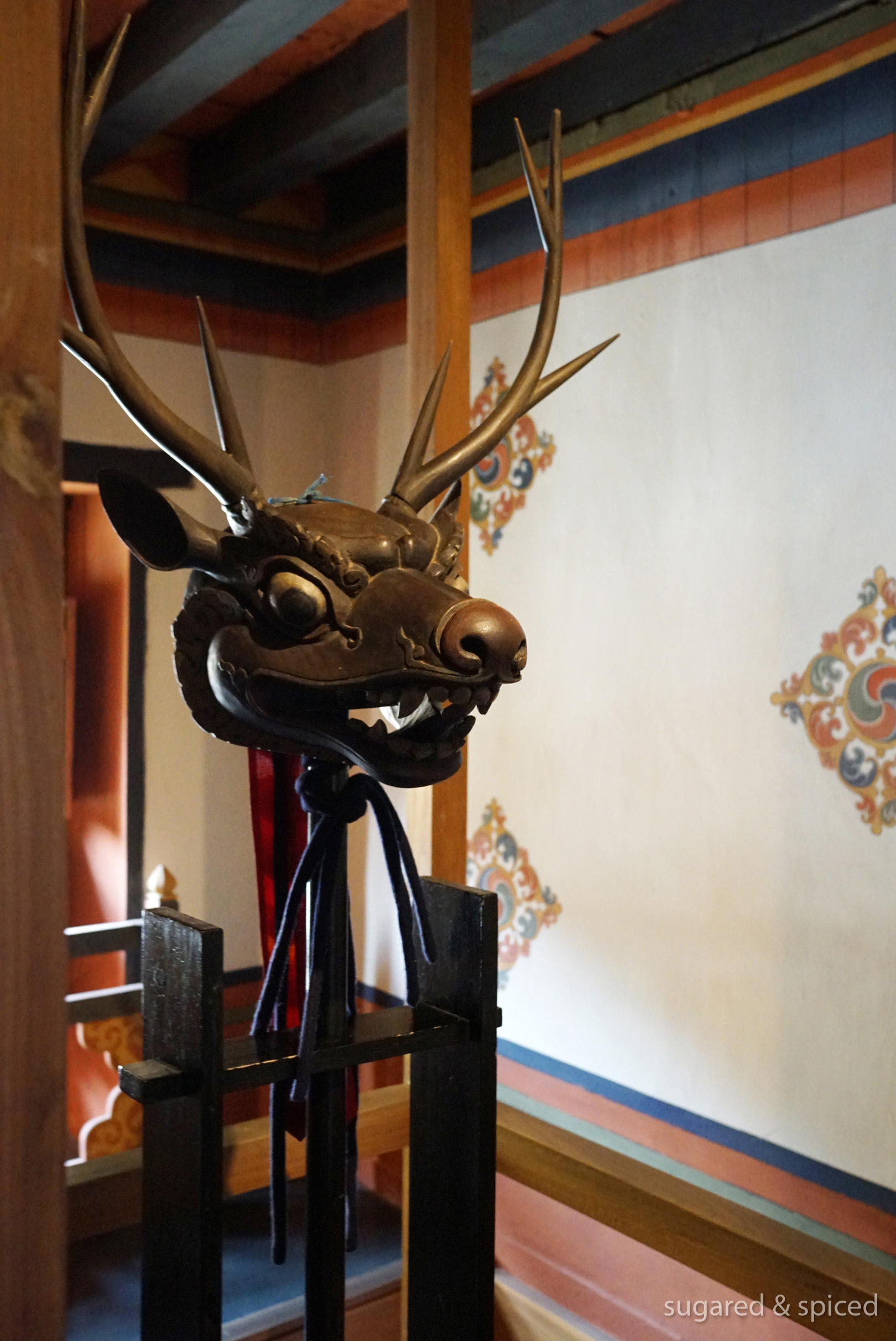
On the third and top floor of the farmhouse, there is a traditional altar room, where we were to attend a chanting ceremony later in the afternoon.
小屋的三樓有個佛堂,可能因為經常點著香和酥油燈吧,老舊的櫃子上有濃濃的煙燻痕跡。傍晚,我們將回到此處參加祈福儀式。
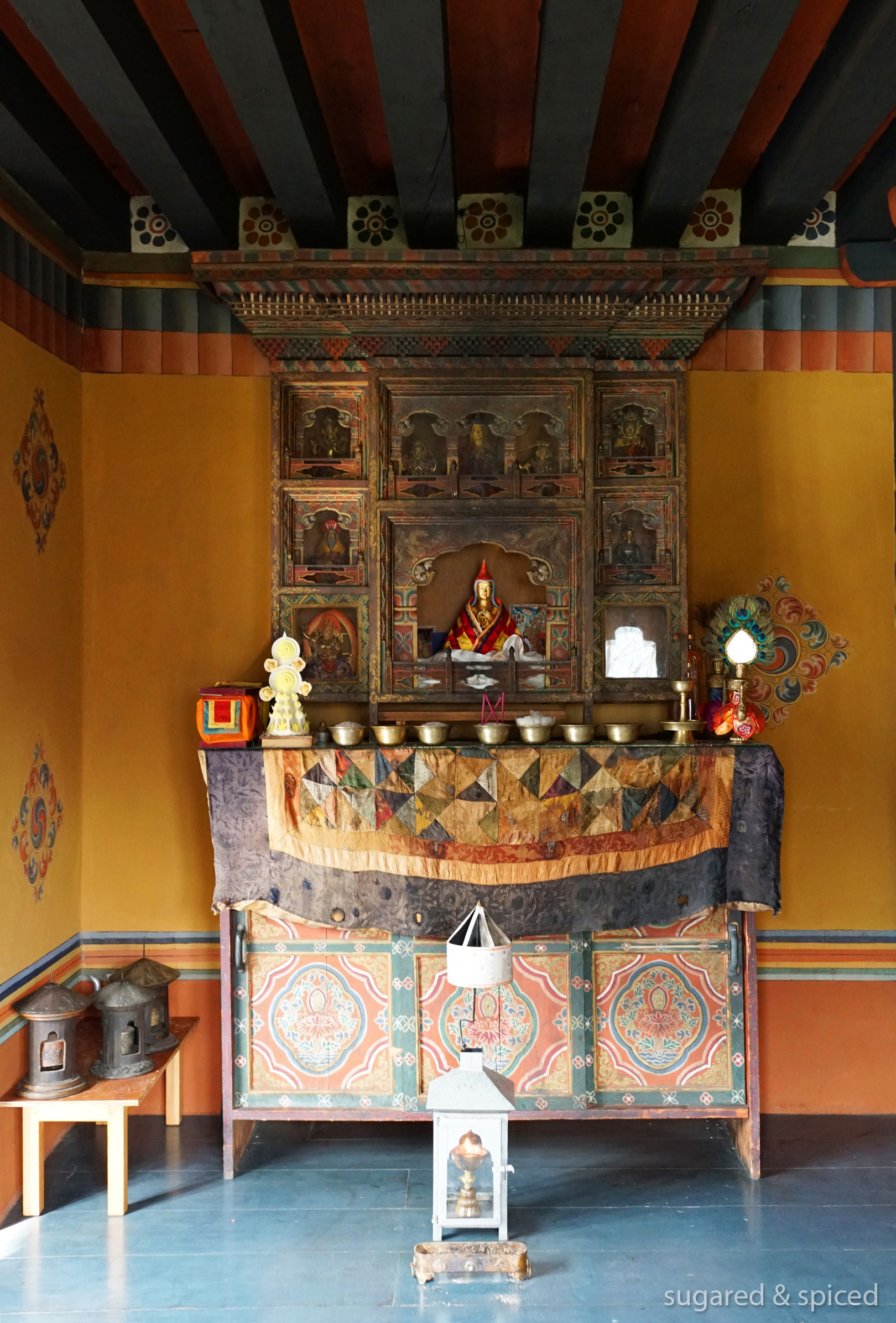
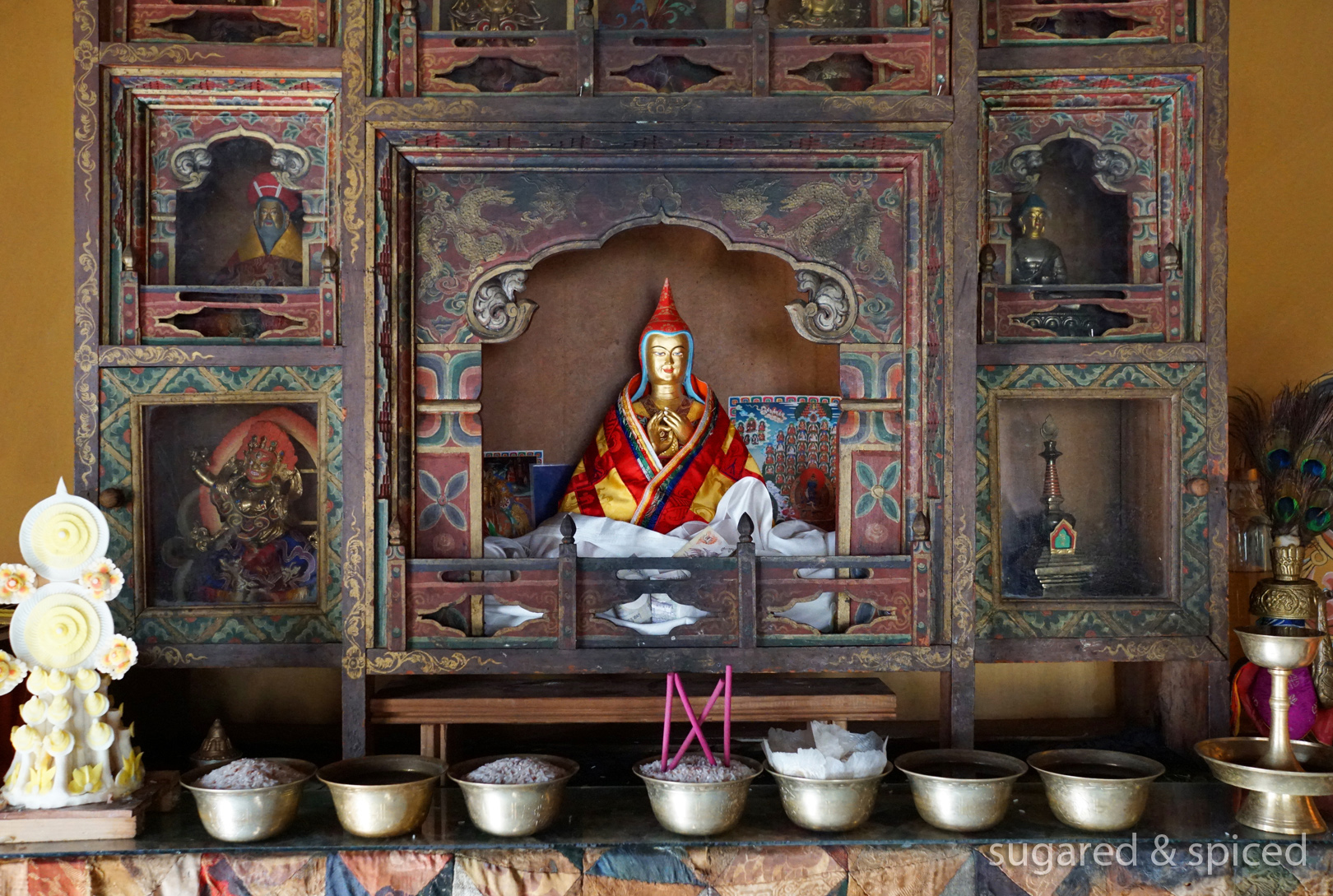
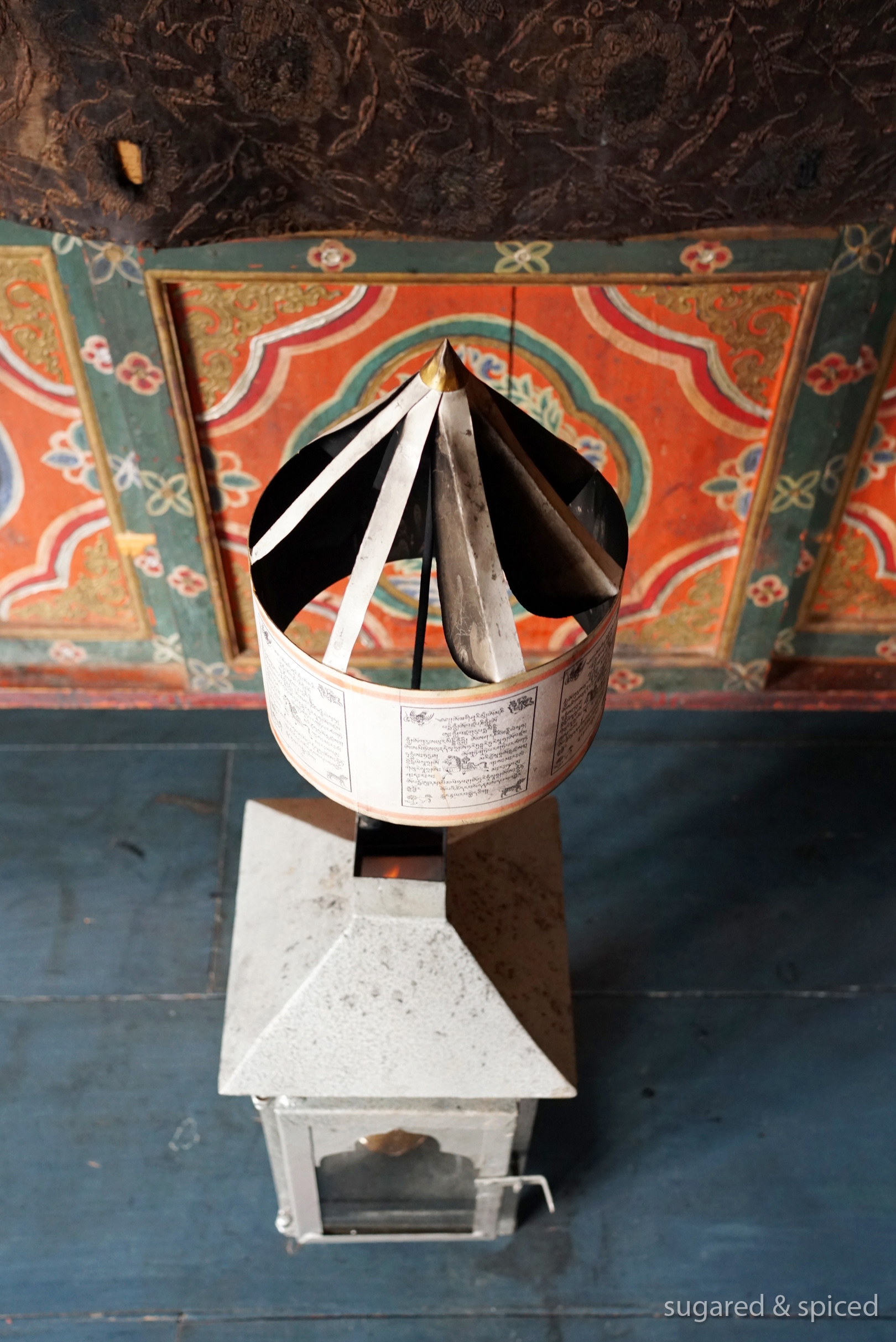
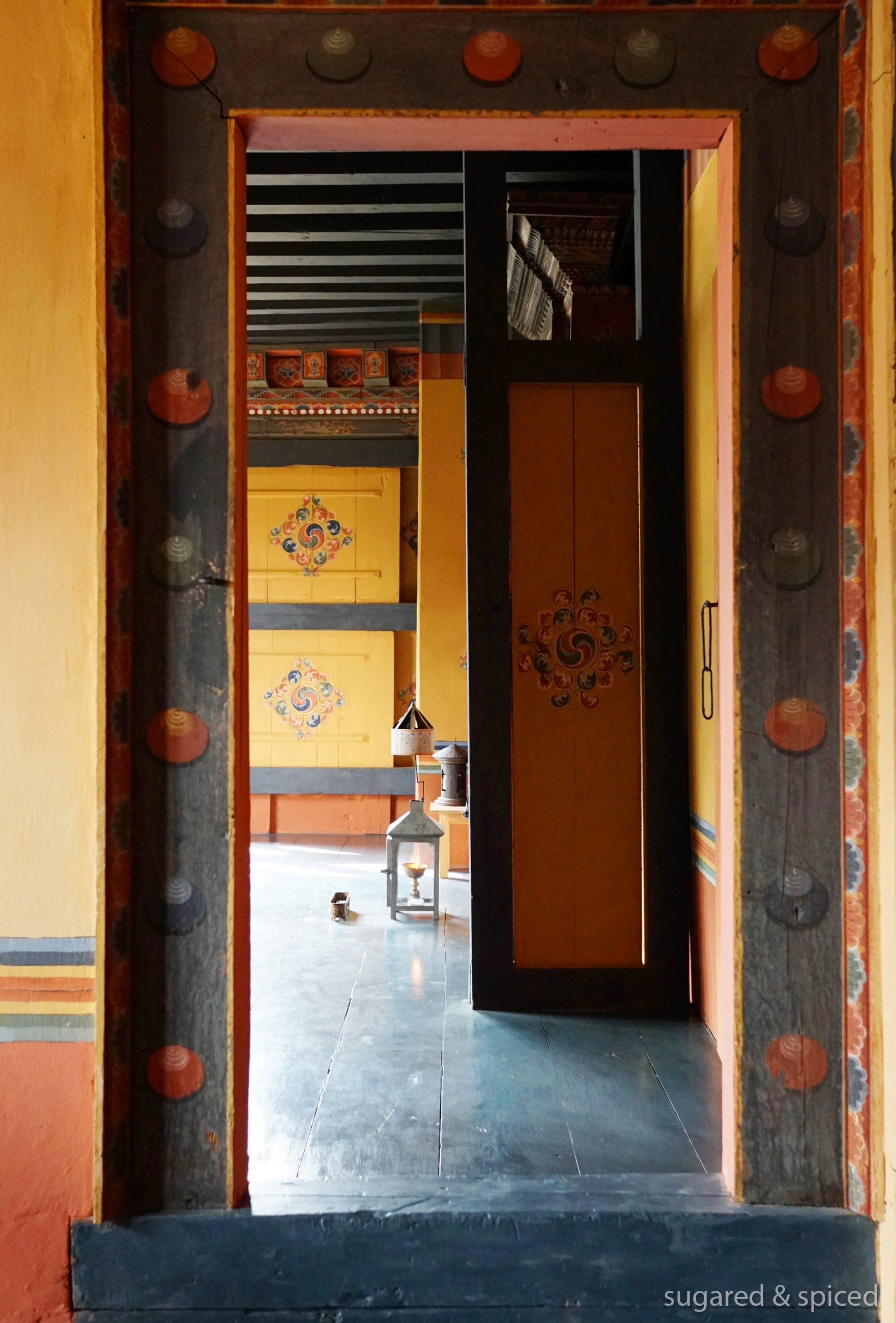
But first, a sunny lunch out on the terrace, with the rice fields of Punakha valley as backdrop.
當天陽光正好,我們決定在露台上吃午飯,欣賞稻田風景。
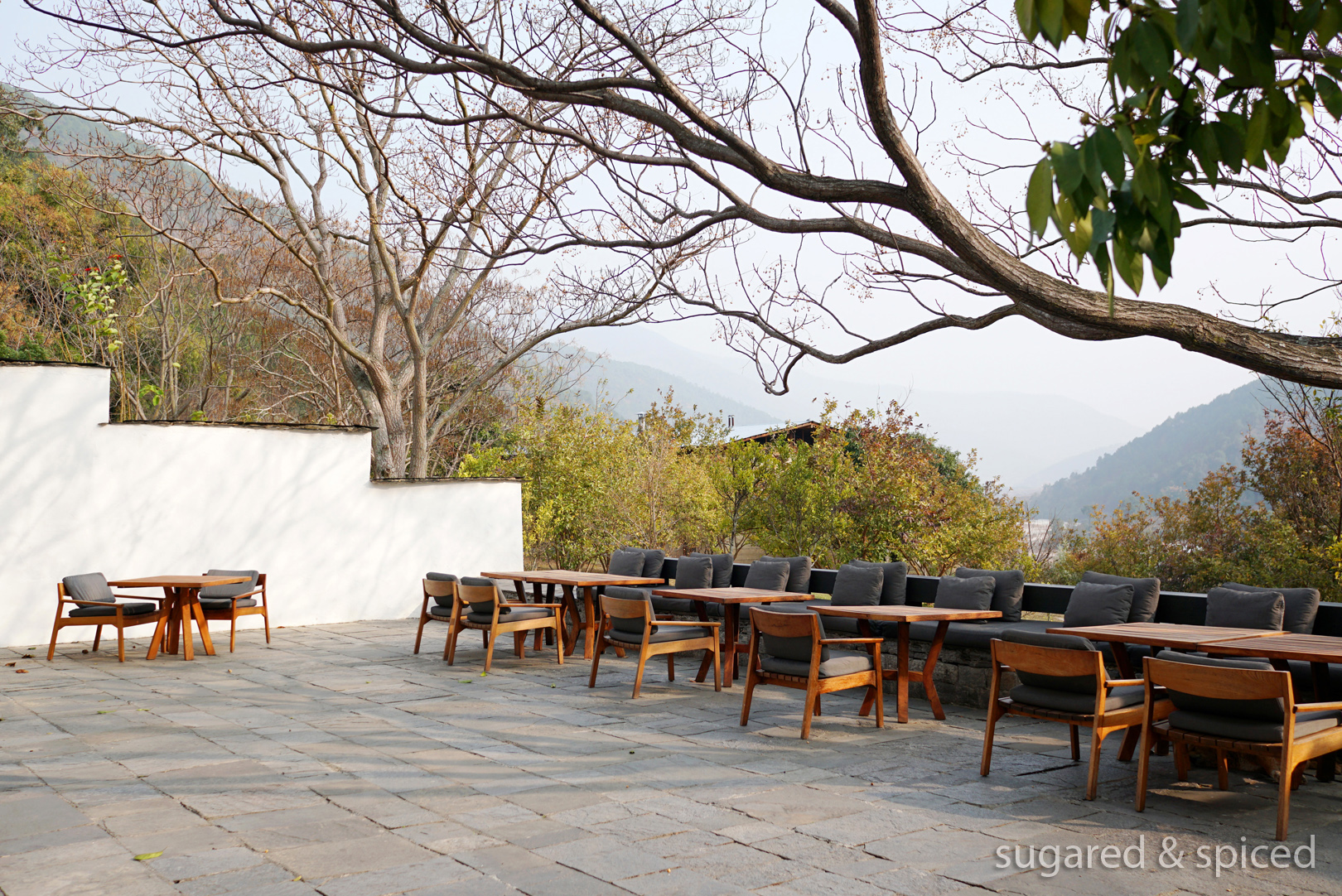
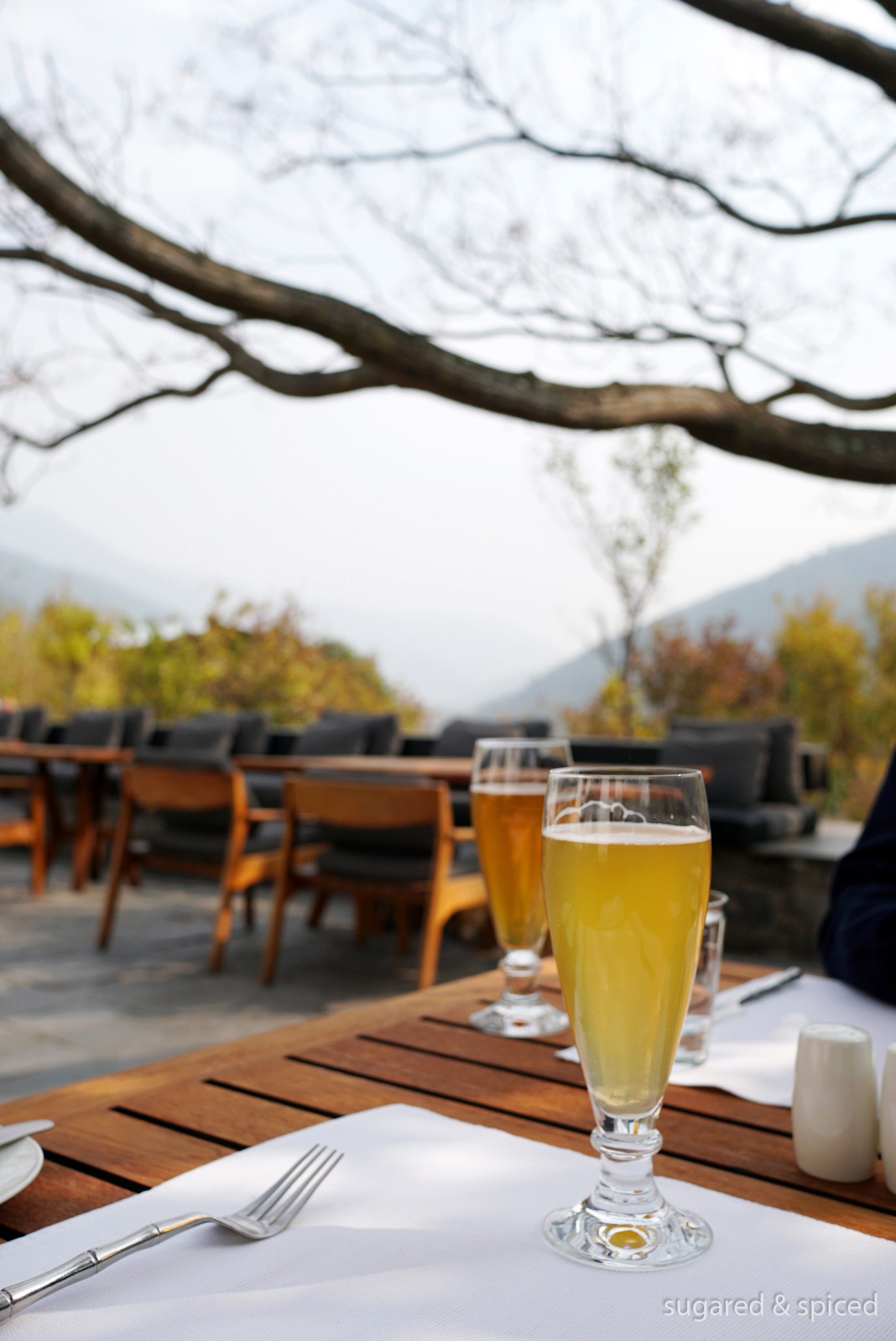
Focaccia with hazelnut spice dip and olive oil.
義大利香草麵包佐榛果香料蘸醬和橄欖油。
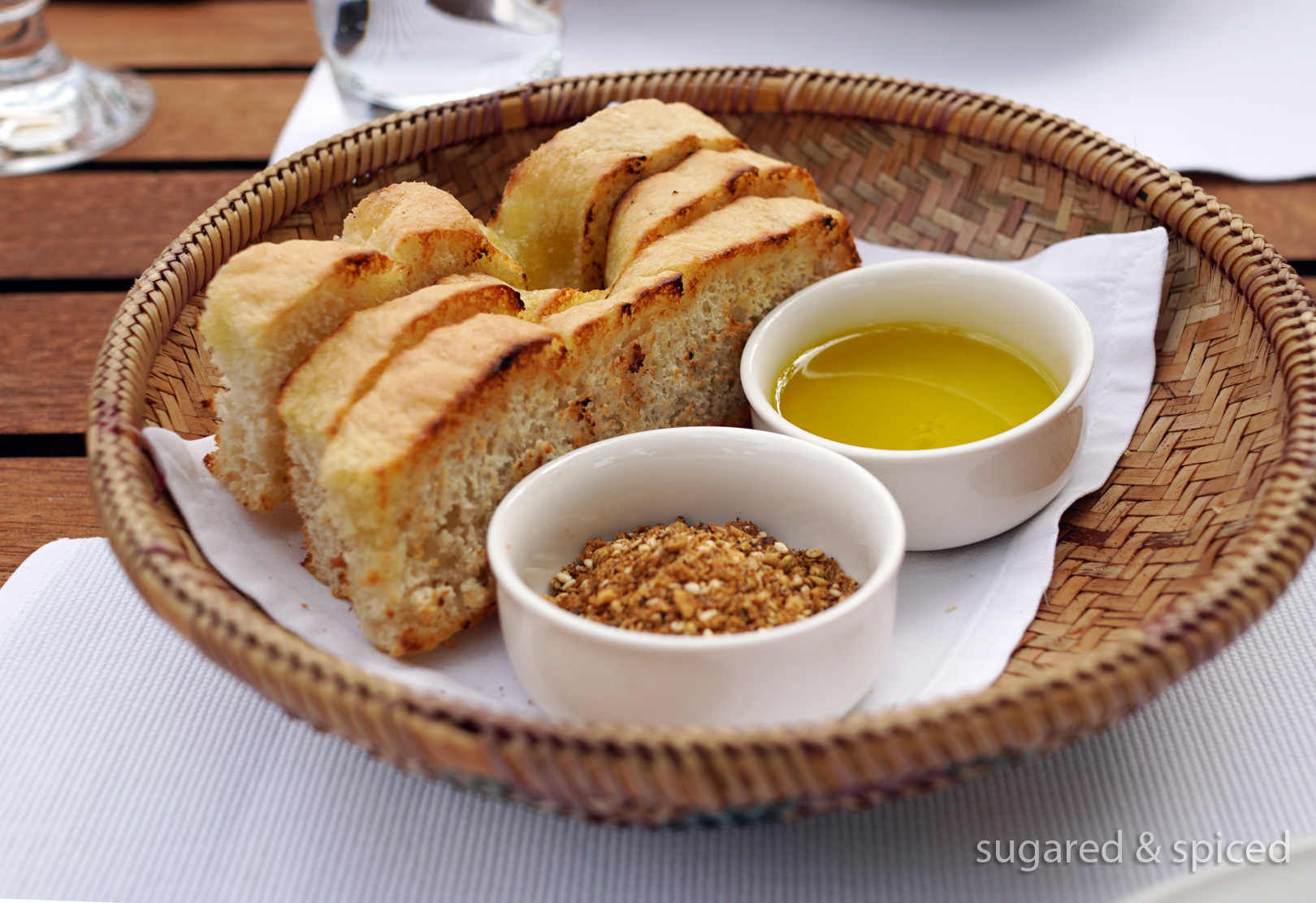
The best roasted carrot salad, with the perfect sweetness and crunchy texture.
令人驚艷的胡蘿蔔沙拉,有著恰到好處的脆口感和甜度。
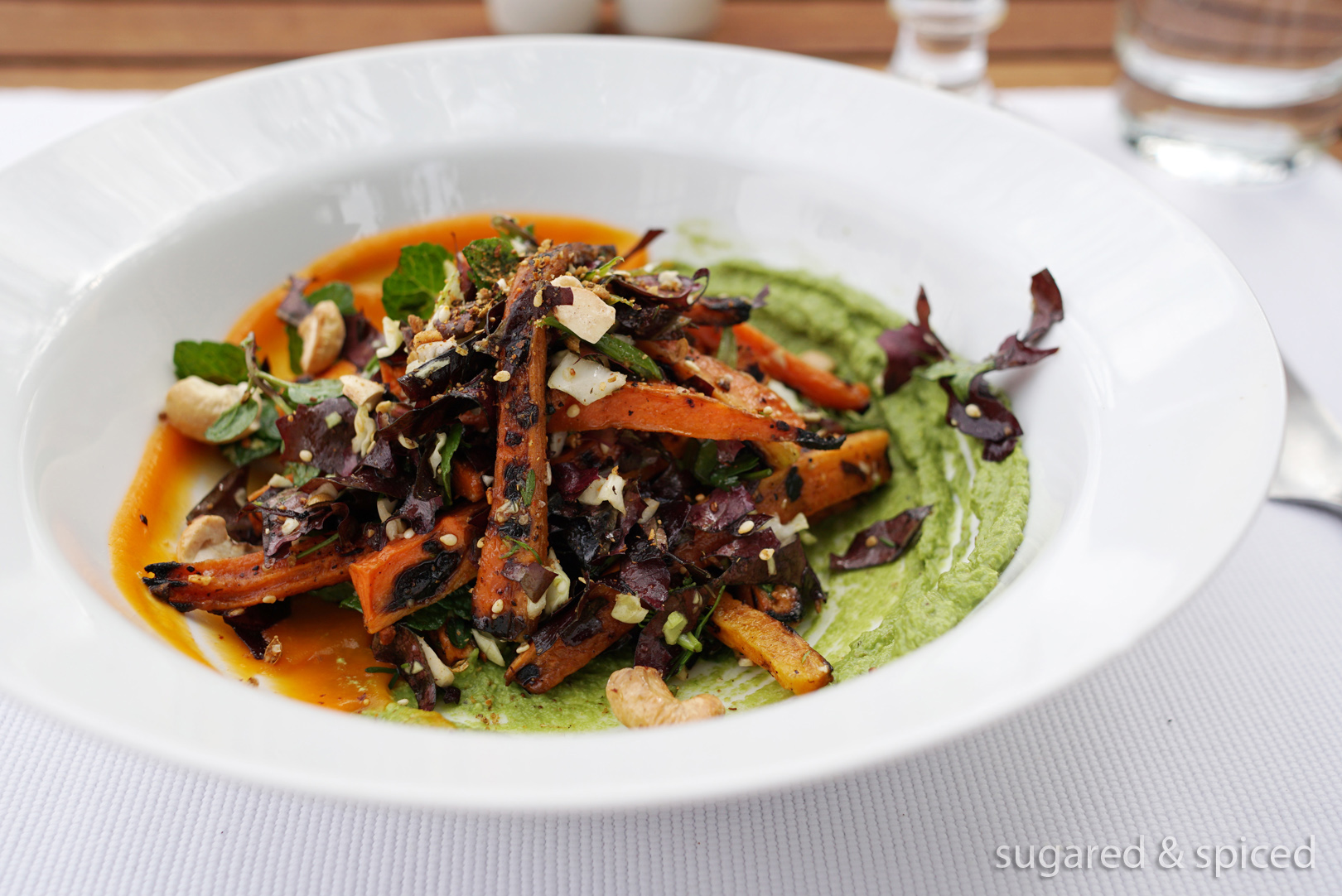
And this fish wrap! Healthy, tasty, and very filling.
健康可口的烤魚卷餅。
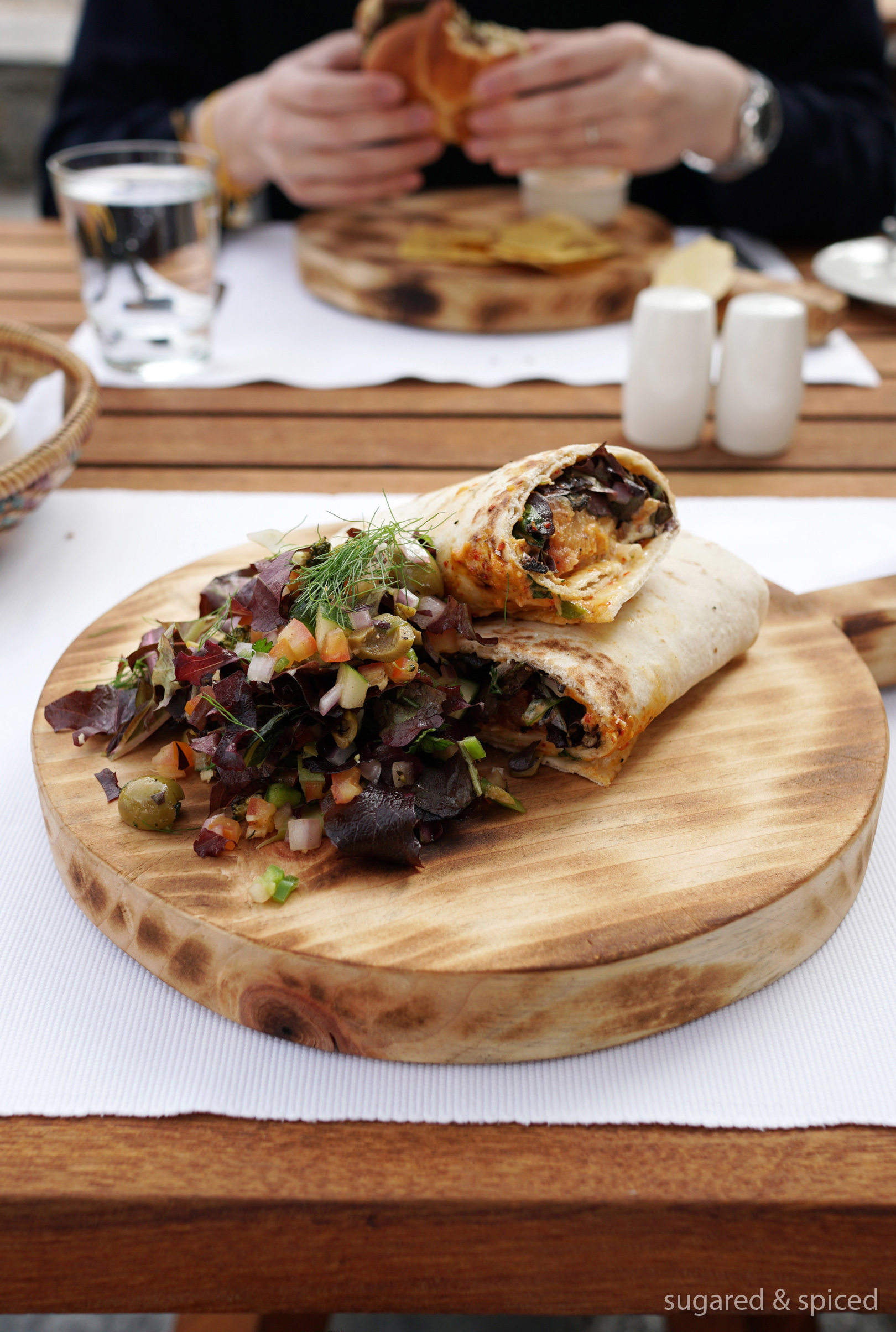
Ahhh…life is good.
曬曬太陽吹吹風…yes, life is good。
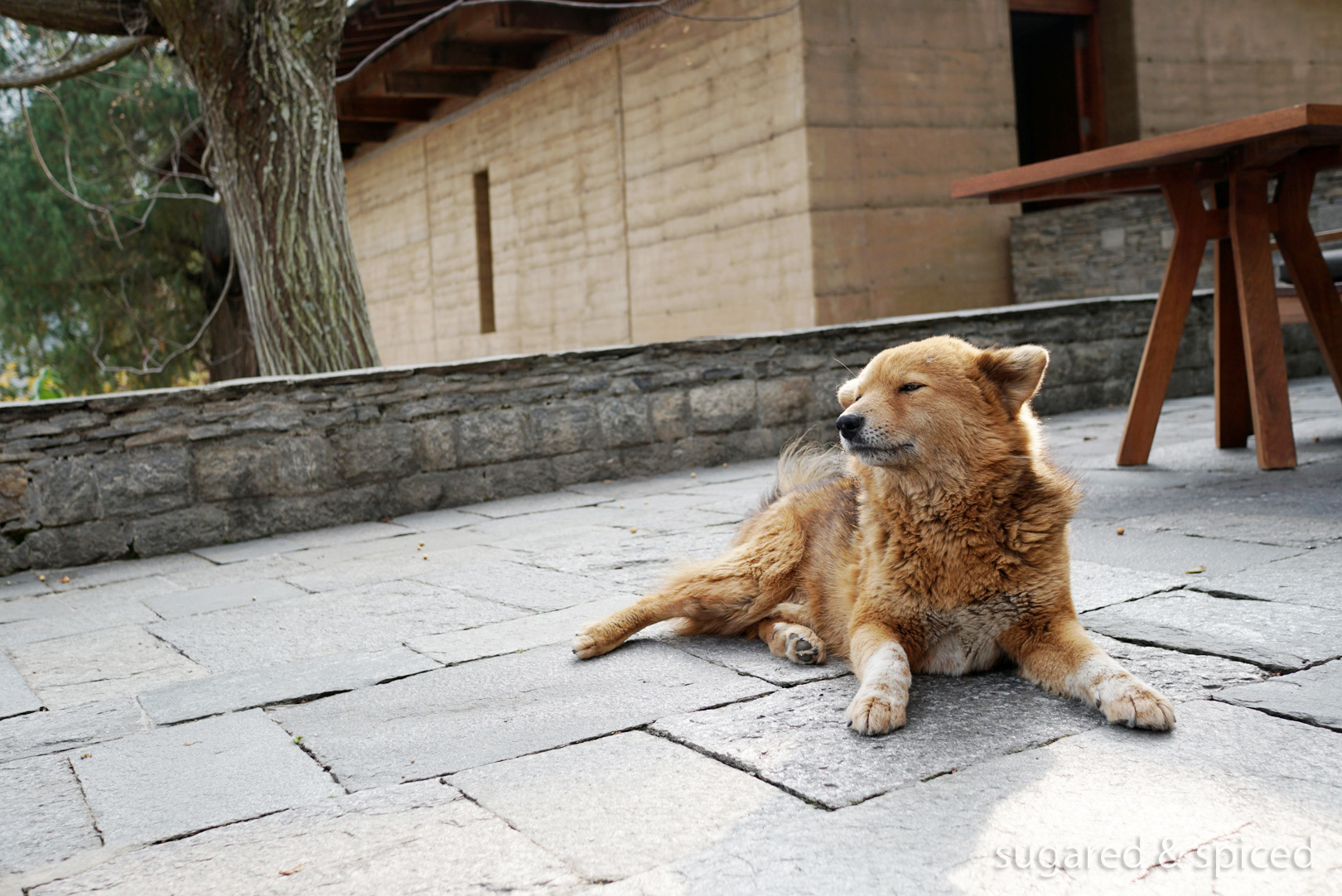
Punakha lodge is also the only Amankora lodge with a pool, and it’s got a view like none other. It was still a bit too chilly for us to take a dip, but I imagine this would be very lovely when the weather warms up later in the year.
Punakha lodge 是五間 Amankora 裡唯一有泳池的,雖然因為天氣還微涼,我們沒有下水,不過可以想像春暖花開時泡在泳池裡,遠處有朦朧山谷,近處有牛兒靜靜吃草,應該相當愜意。
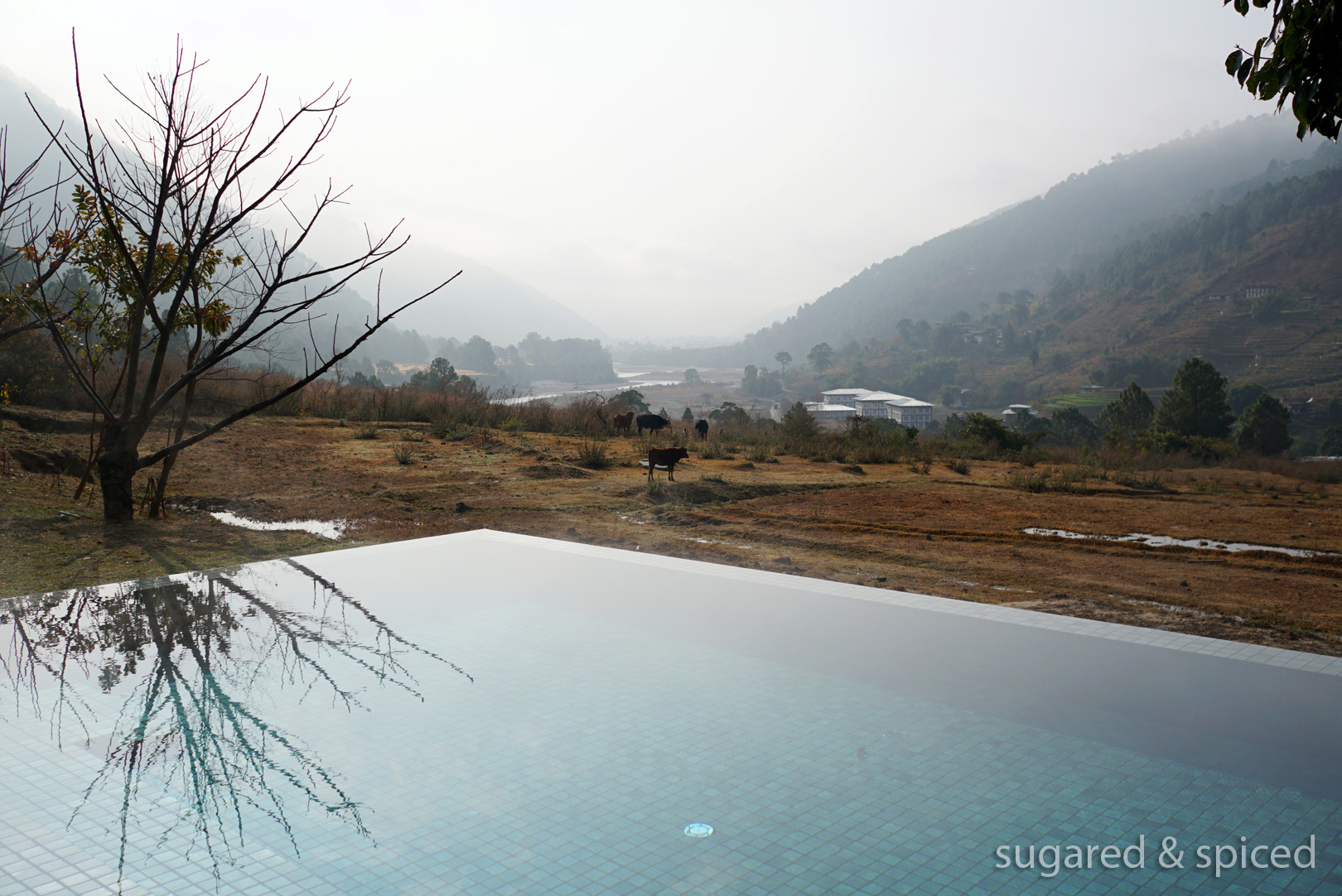
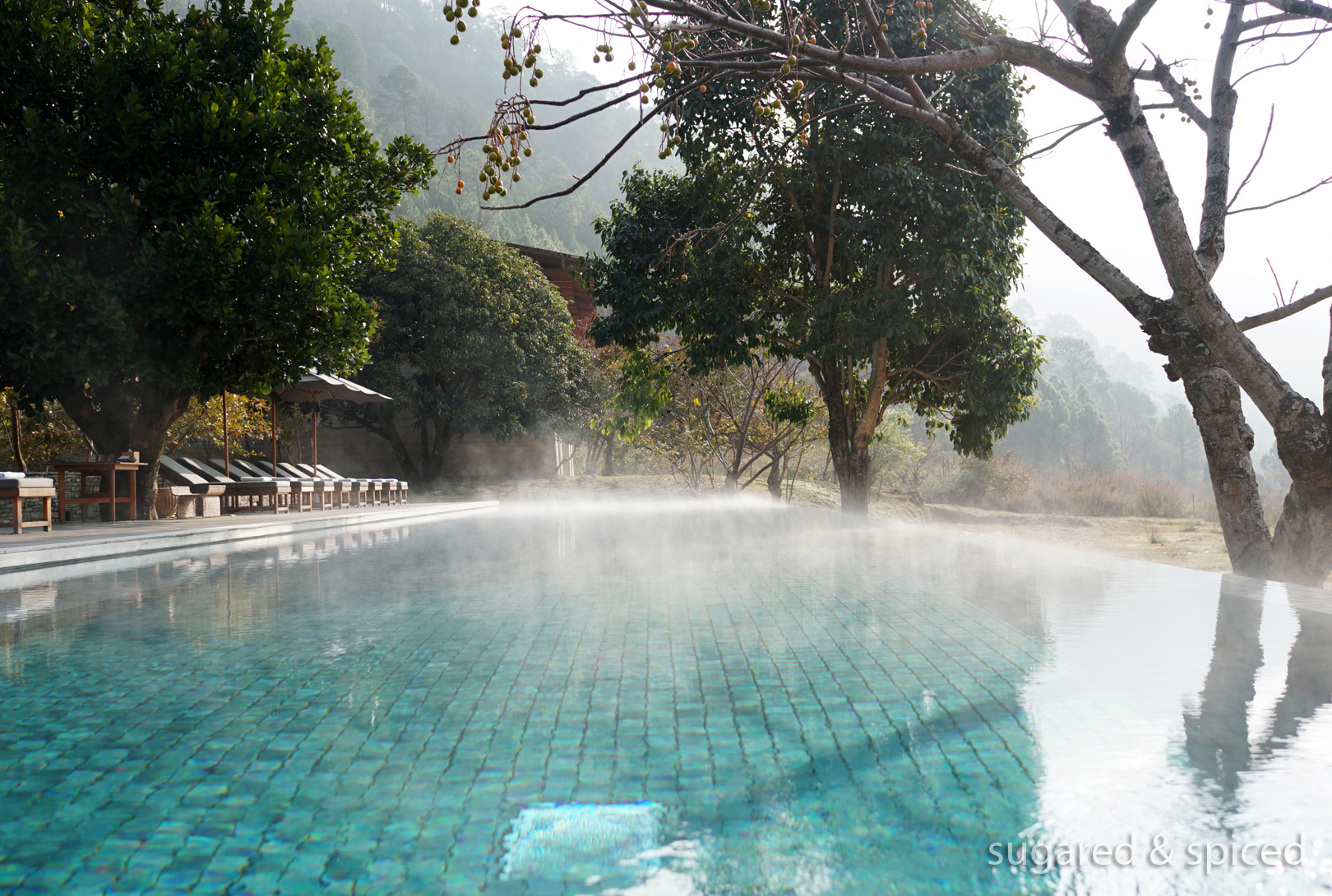
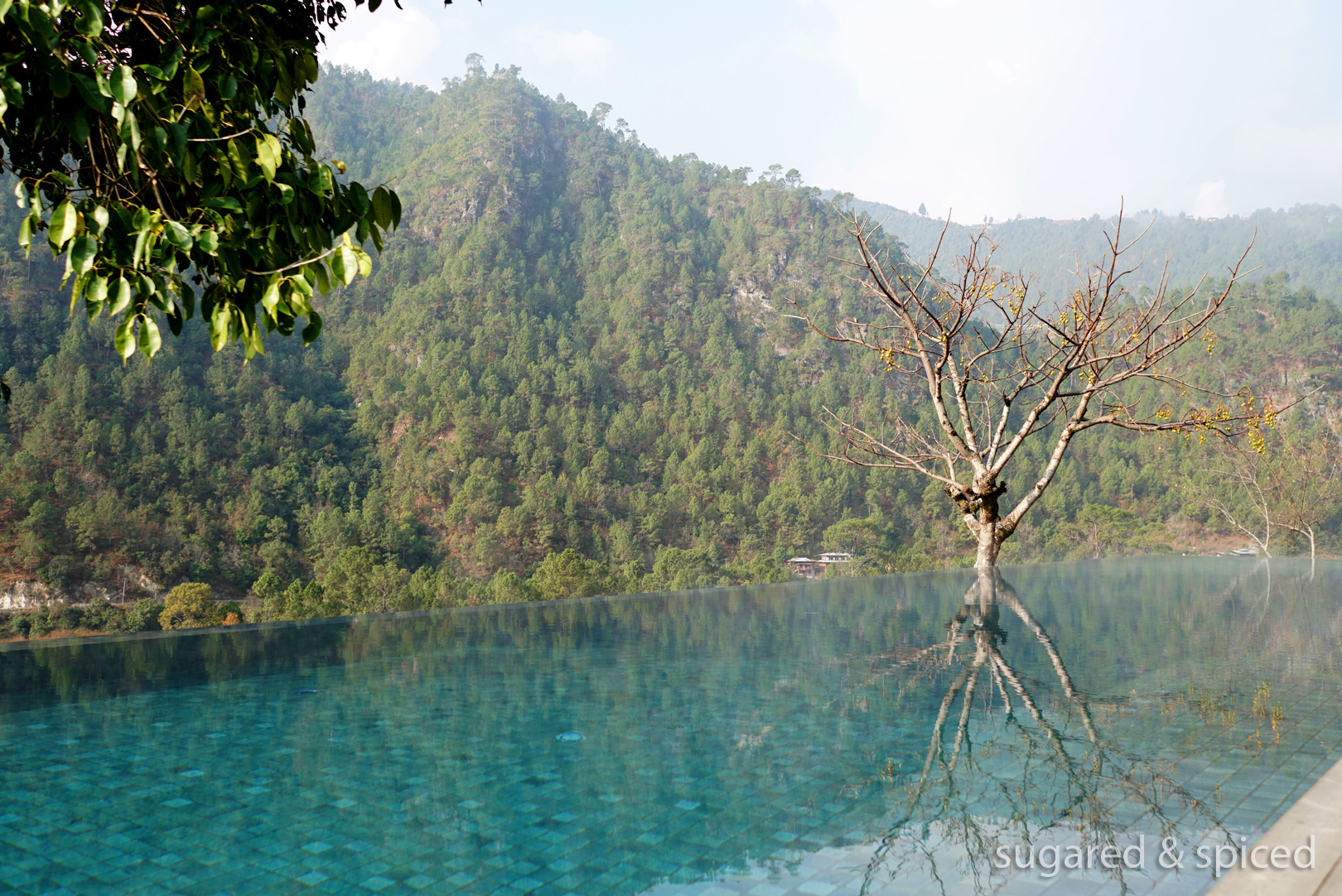
The suites at Punakha lodge have a slightly different orientation – the bathtub has a view as well:
房間格局與之前的大同小異,最大的區別是多了一扇在浴缸旁邊的窗。
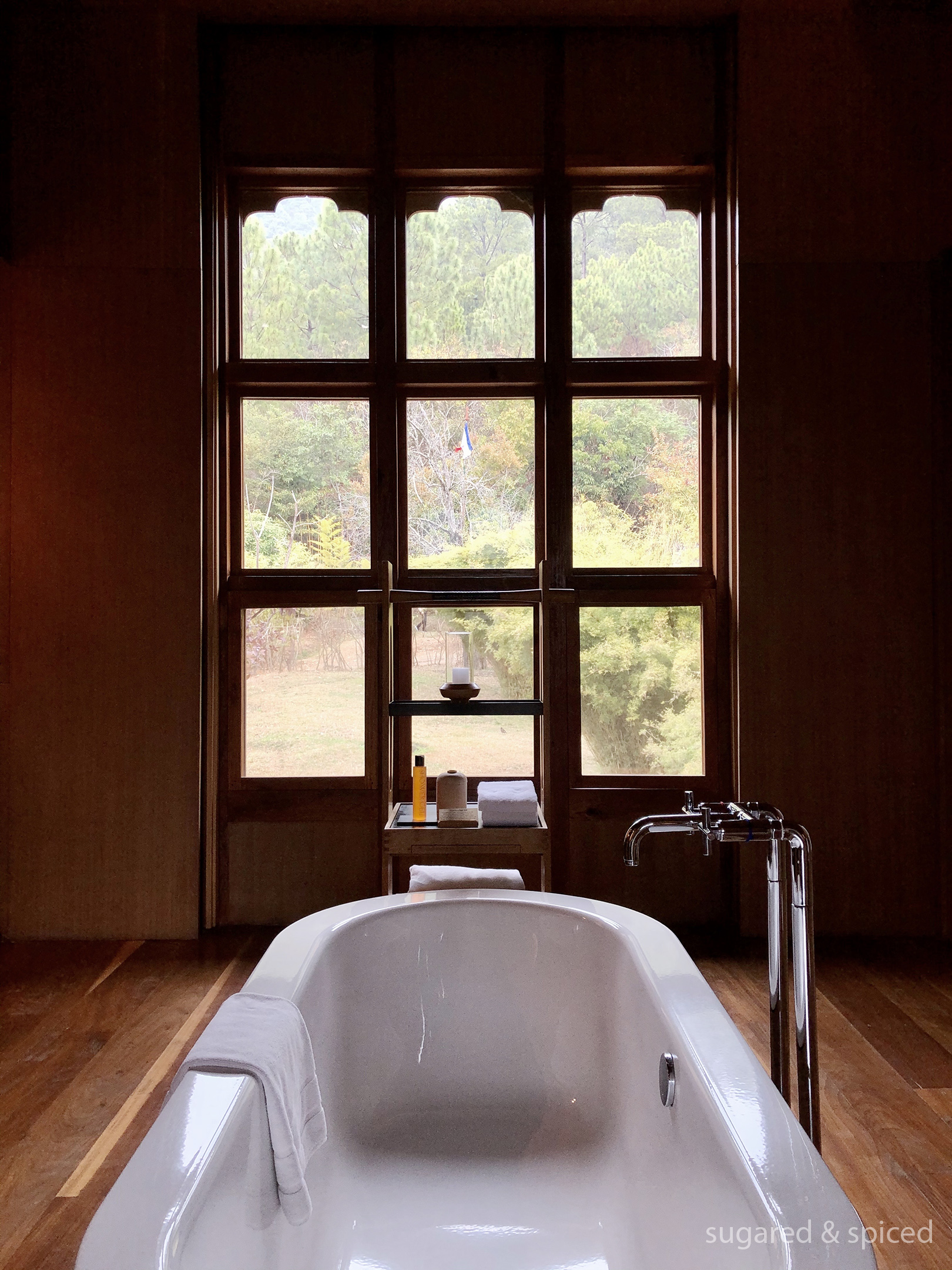
My favorite spot, of course, was still the banquette.
我的最愛,仍是這扇窗邊的軟榻。
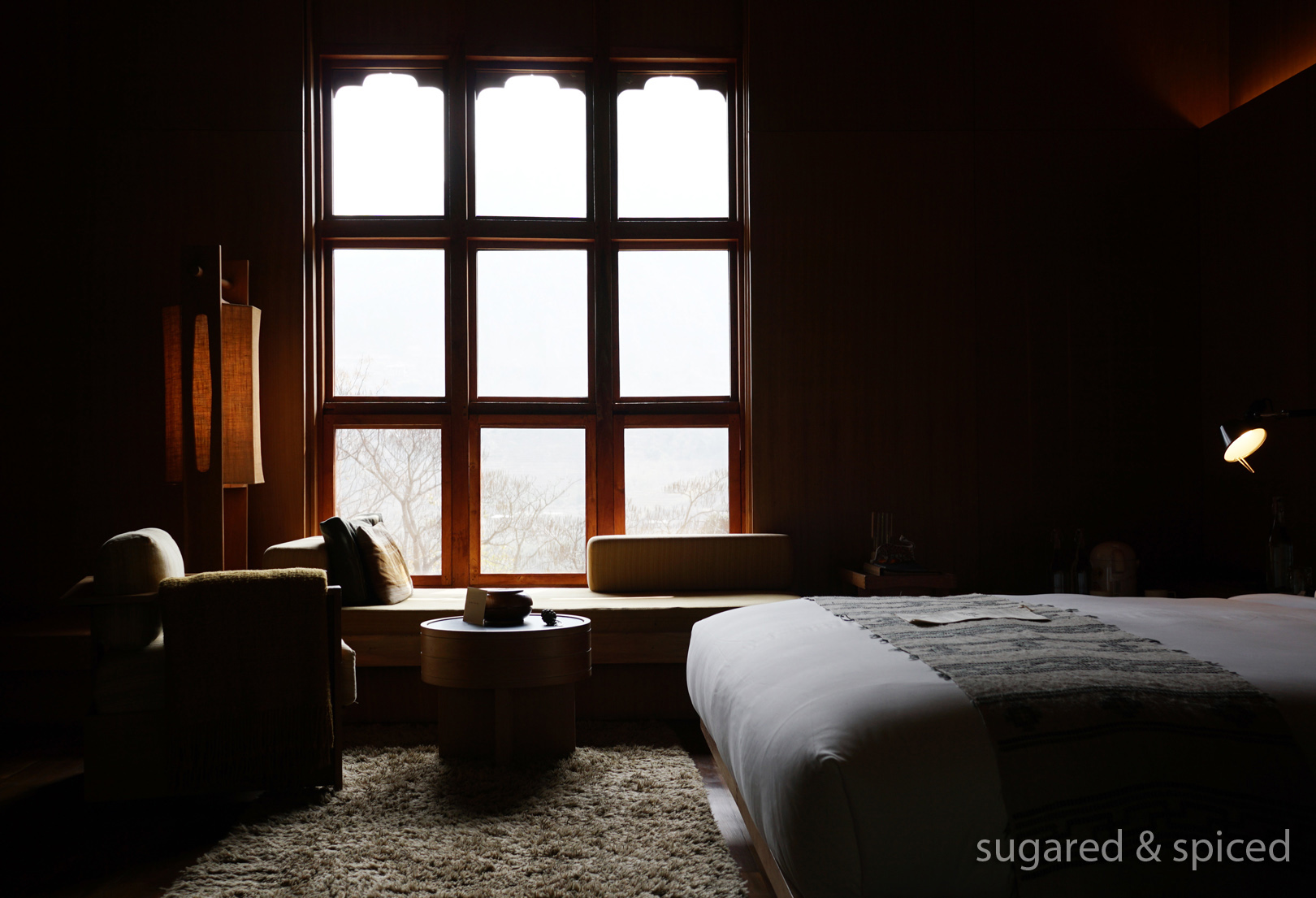
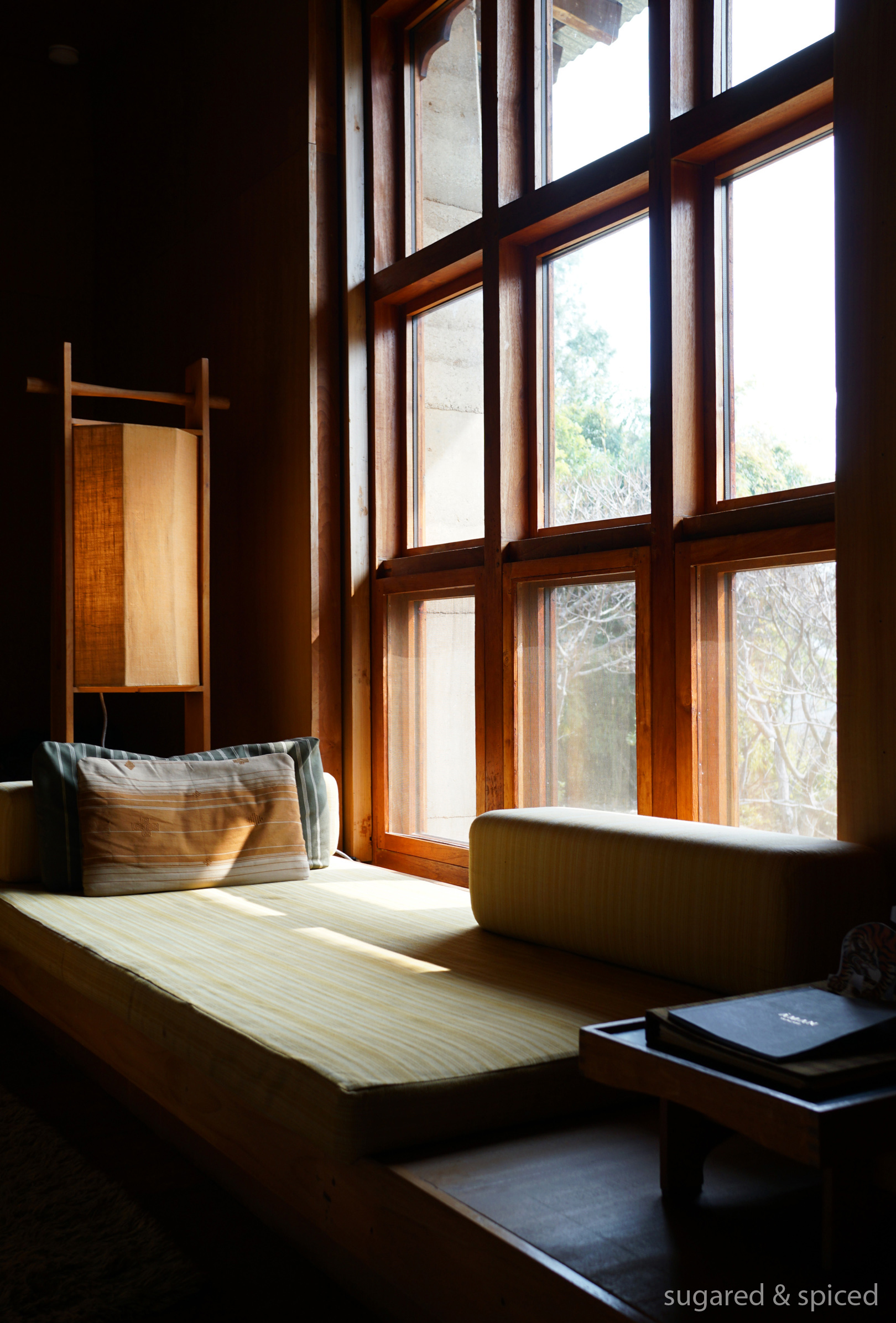
With a change of view.
同樣的窗子,不同的景色。
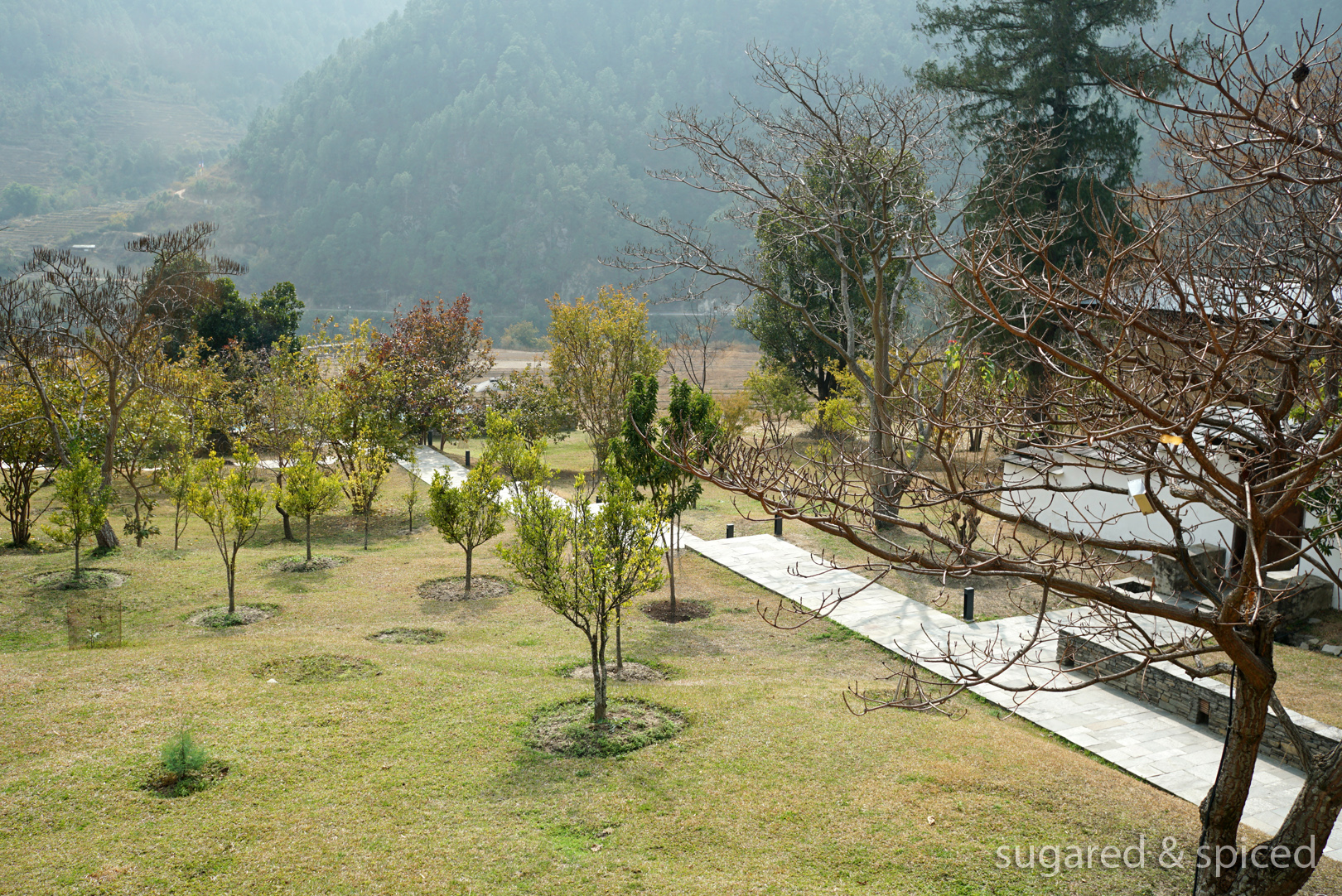
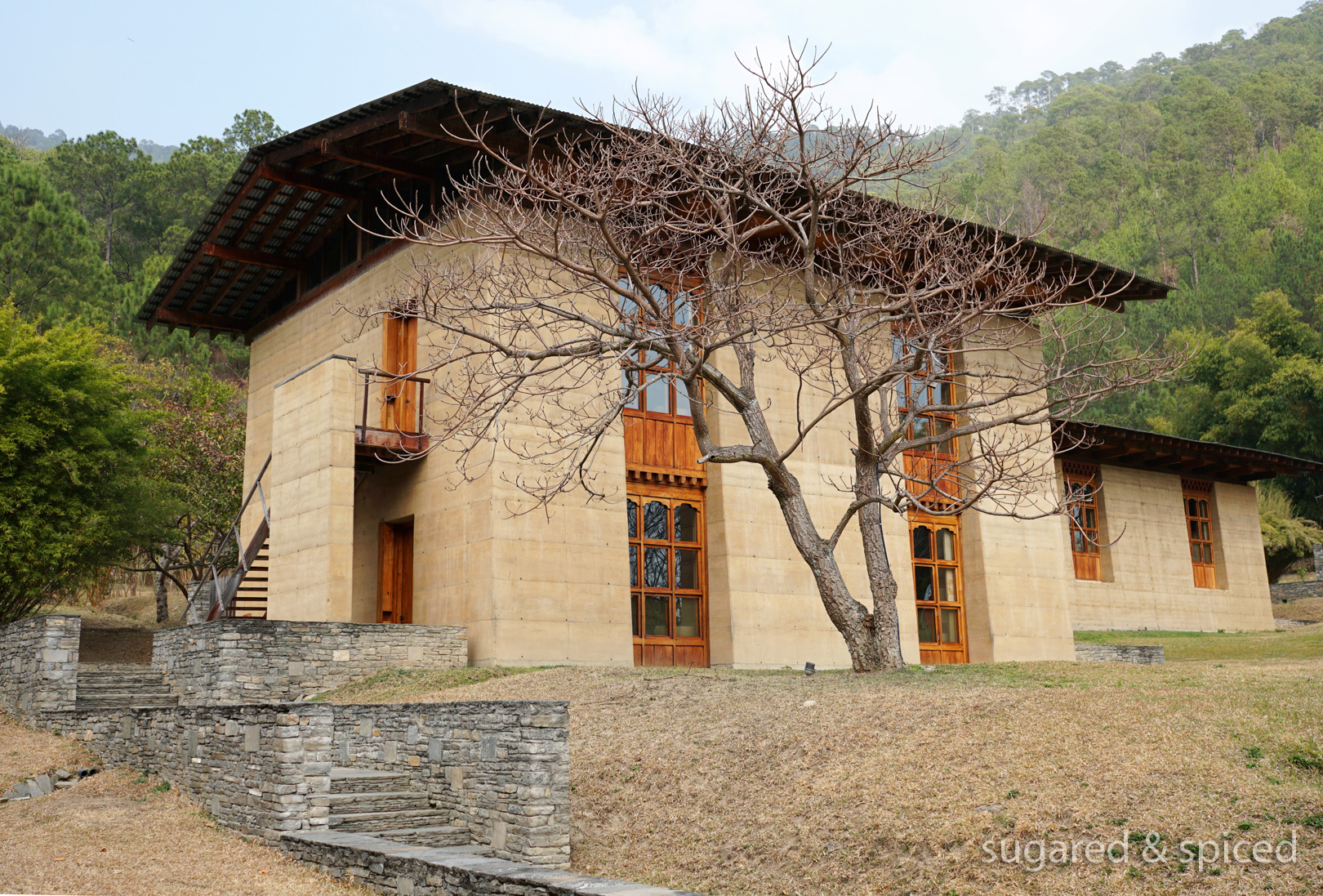
We decided to stay on property for the rest of the day, and seeing that it had a beautiful archery field, we thought it would be fun to give Bhutan’s national sport a try.
初抵 Punakha lodge 時就注意到這裡有個景色優美的射箭場,趁著下午的好天氣,我們決定來試試不丹的國民運動。
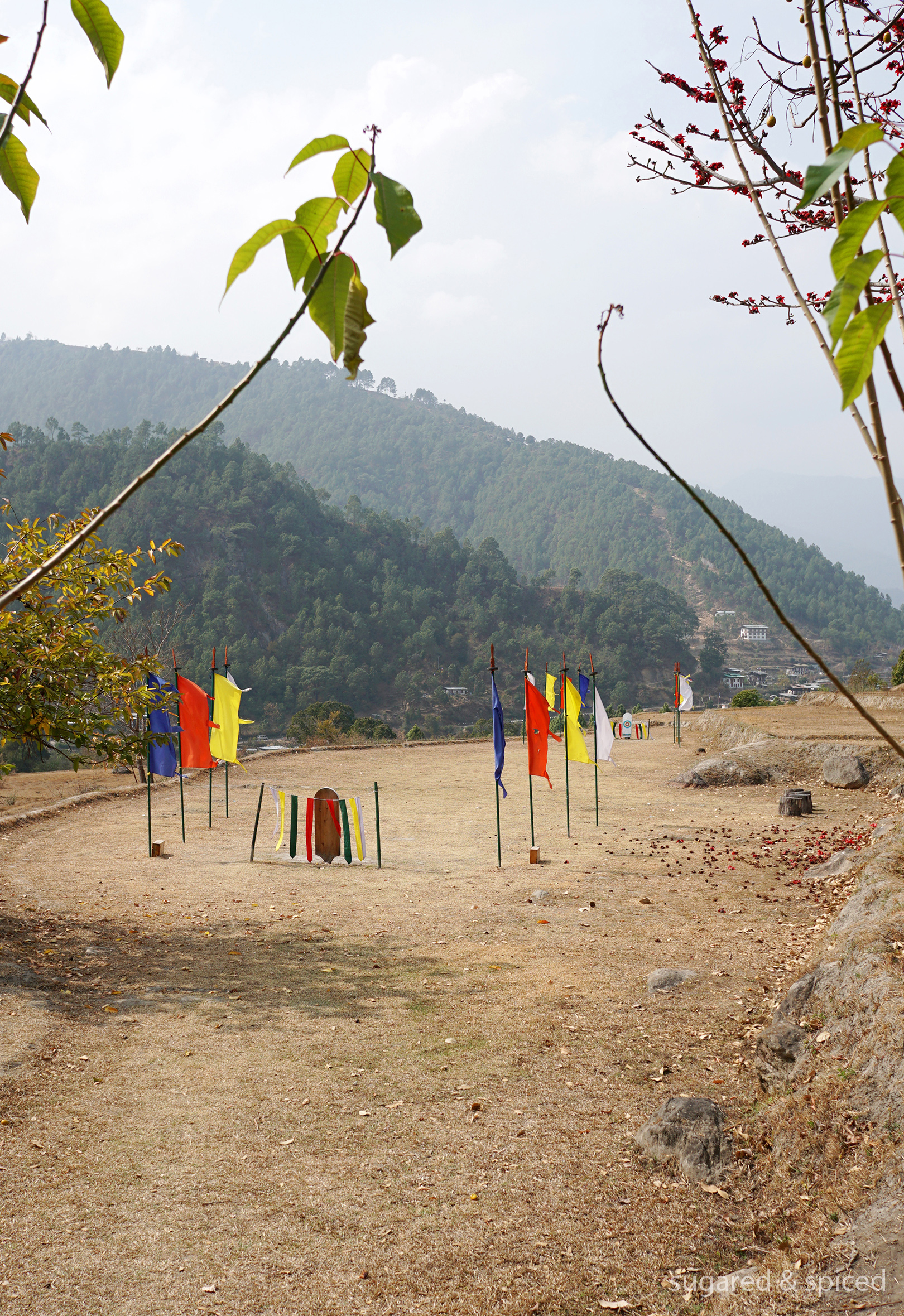
The typical archery field in Bhutan measures 140 meters long (twice as long as the range used in the Olympics), but the one at the lodge is only 50 meters, perfect for beginners like us. It turned out that I’m not too bad at shooting arrows, and managed to hit the mark after some practice (and probably with a good dose of beginner’s luck).
不丹一般的射箭場長度為140米(奧林匹克標準的兩倍),靶心畫在一個細長的木板上,我連看都看不清楚,更別說要射中了。好在 Amankora Punakha 的場地是給初学者玩的,距離大約50米,在工作人員的悉心指導下居然射中了箭靶。
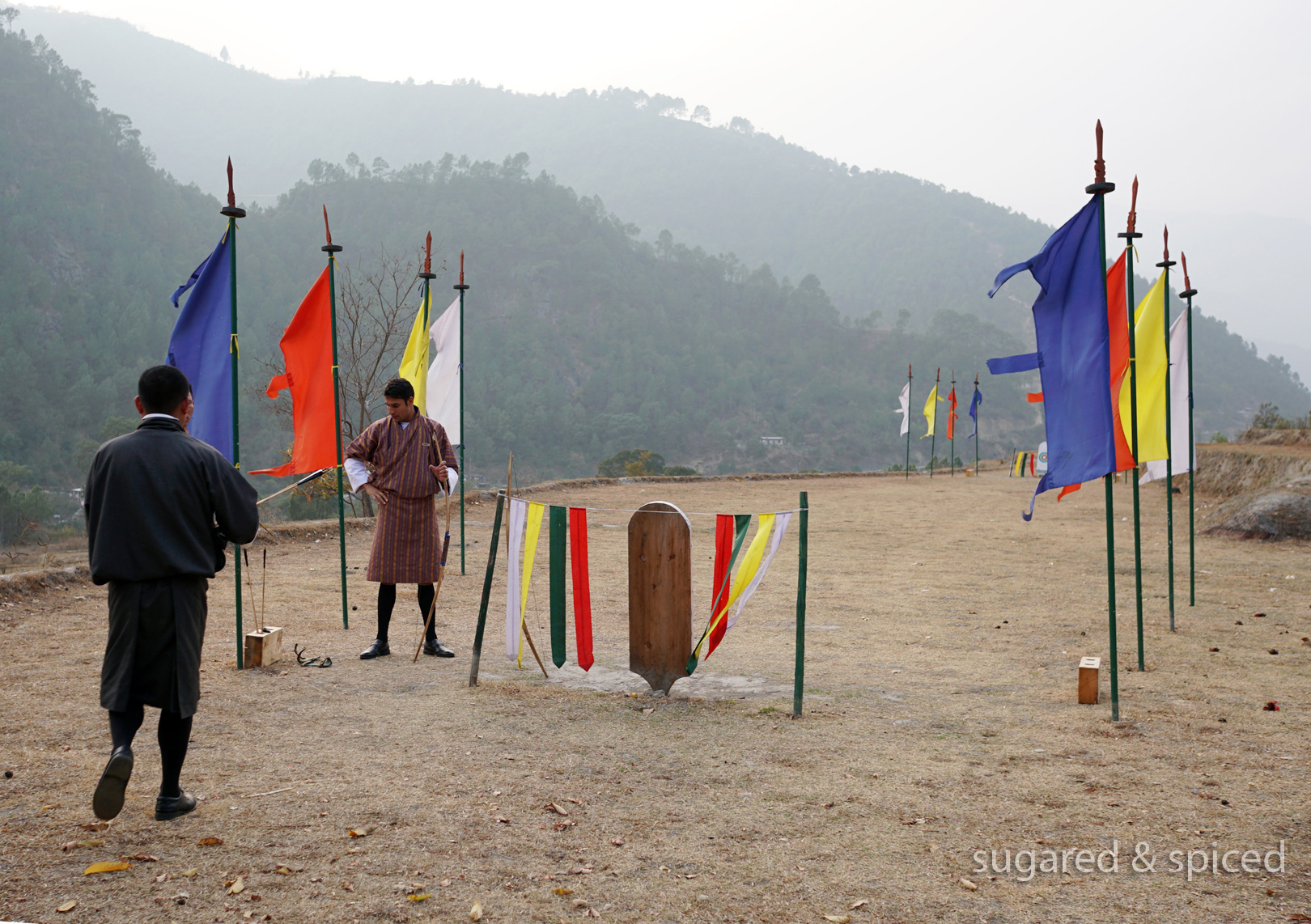
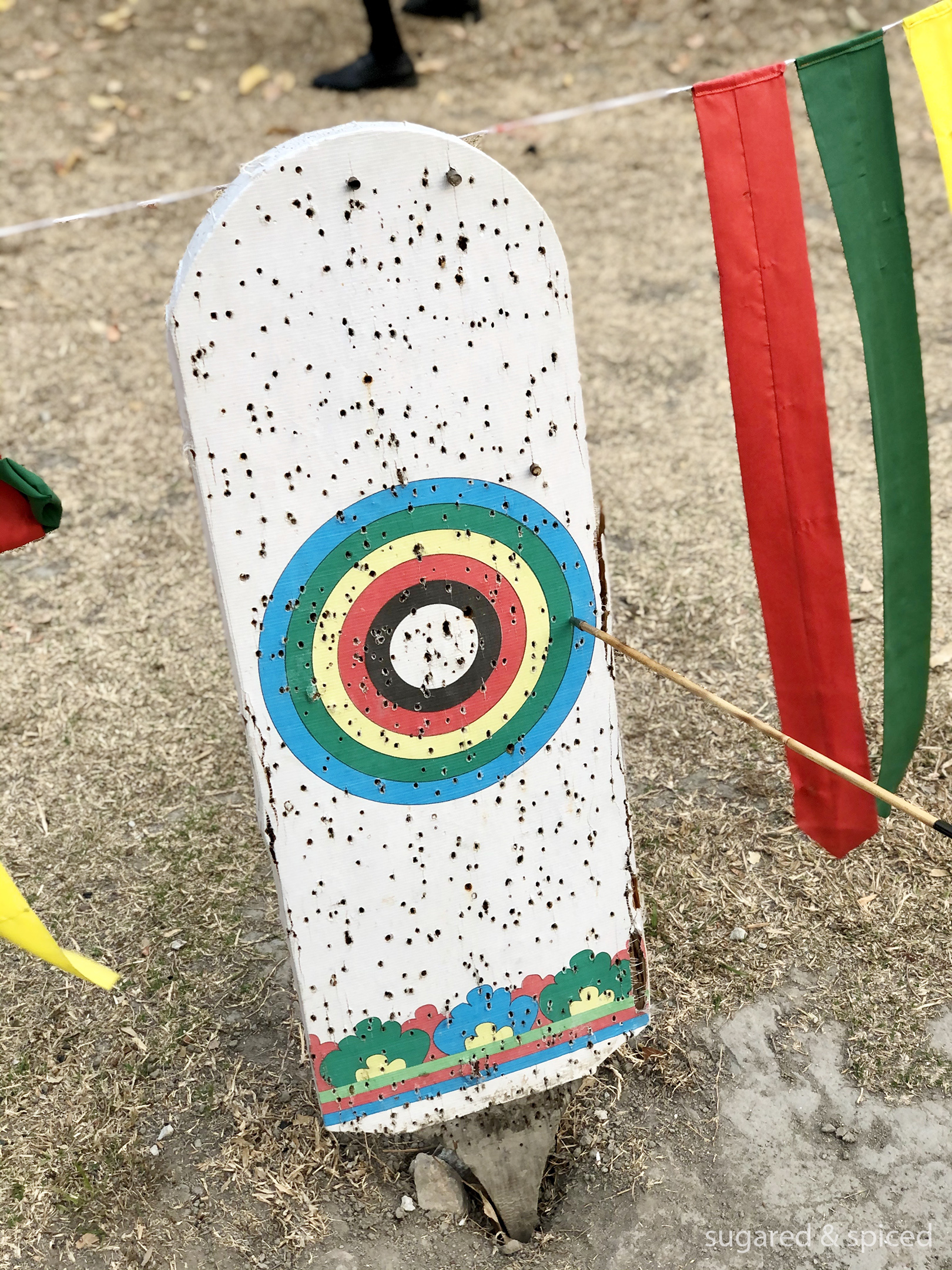
In Bhutan, archery is both a competitive sport and a social glue, as villages get together every weekend to compete against one another. With every arrow that hits the mark, Bhutanese archers line up, face the target, and break out in a traditional song and dance – it’s all very, very raucous and cheery. I was also delighted to find out that the game is rarely unaccompanied by copious consumption of ara, the local rice wine.
不丹人非常熱愛射箭,全國各個鄉鎮都必定有射箭場,幾乎每個週末和假期都有大大小小的比賽在某個角落進行。這對不丹人來說不僅是運動,也是社交活動,當有人射中靶心時,隊友們會圍著他歌唱跳舞,開心又熱鬧。更棒的是,射箭時一定人手不離當地的釀酒 “ara”,喝得越 high,射得越準(真的嗎?)。
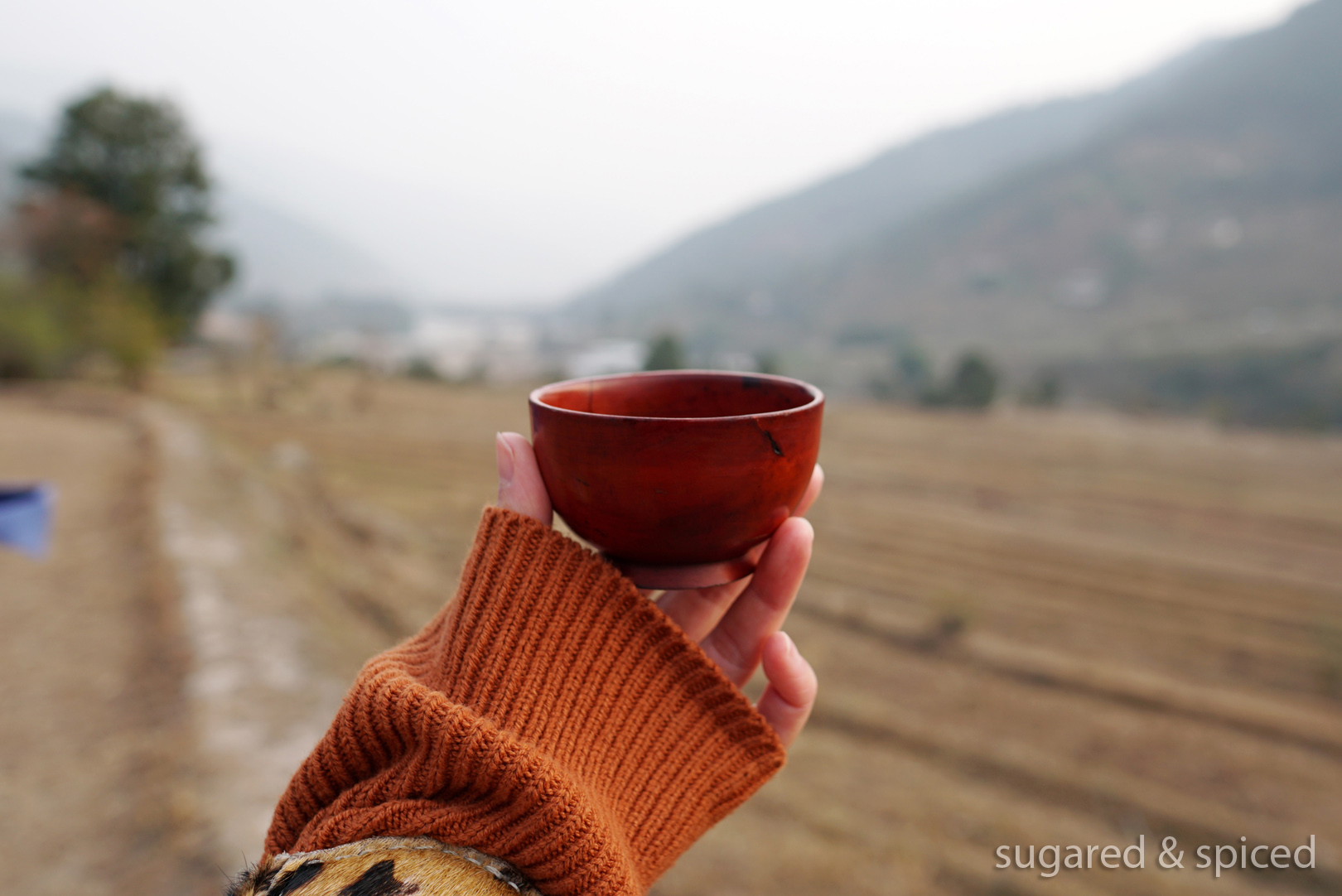
The aftermath of drinking…
喝完酒後,什麼都射中了。
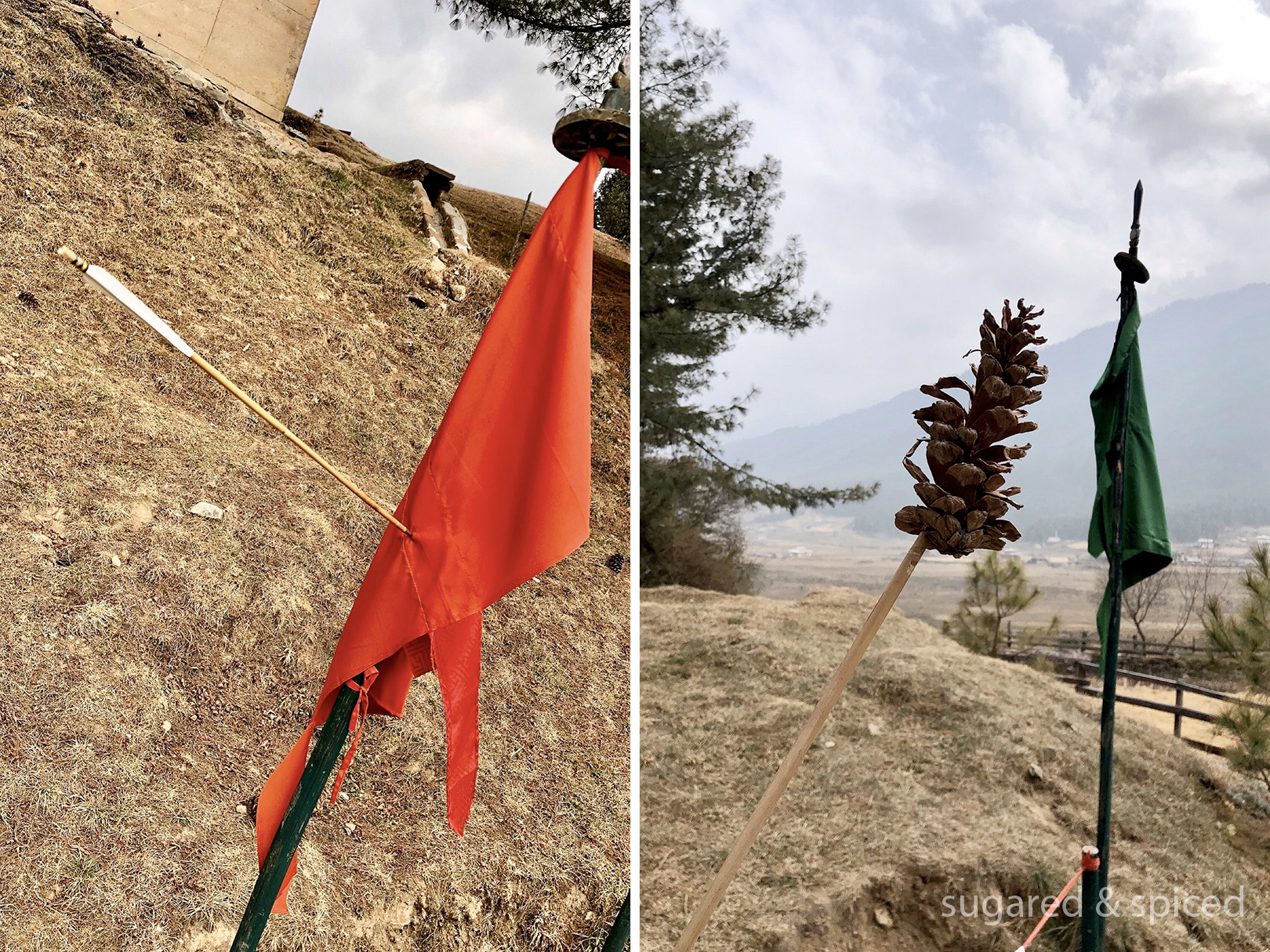
In the late afternoon, we revisited the farmhouse altar room to observe the practice of Threma, which aims to remove obstacles both for our short-term happiness and ultimate enlightenment. As we lit butter lamps, a group of six Threma practitioners chanted and sang, sometimes accompanied by spin drums and kangling, a Tibetan trumpet traditionally made from human femur. The incessant chanting, the wailing, enigmatic sound of the bone trumpet, and the flickering of butter lamps in the background altogether created an otherworldly atmosphere that was unlike any I’ve previously experienced.
傍晚,我們回到三樓的佛堂參加祈福法會,先對佛像跪拜,點上酥油燈,隨後坐下聆聽。小小的佛堂裡充斥著似歌唱般的誦經、手鼓的節奏、剛令*悽厲的笛聲,還有在昏暗中搖曳的酥油燈火…神秘而詭譎的氛圍,讓人有種處於異空間的微妙感。
*西藏的吹奏樂器,由人腿骨製成。
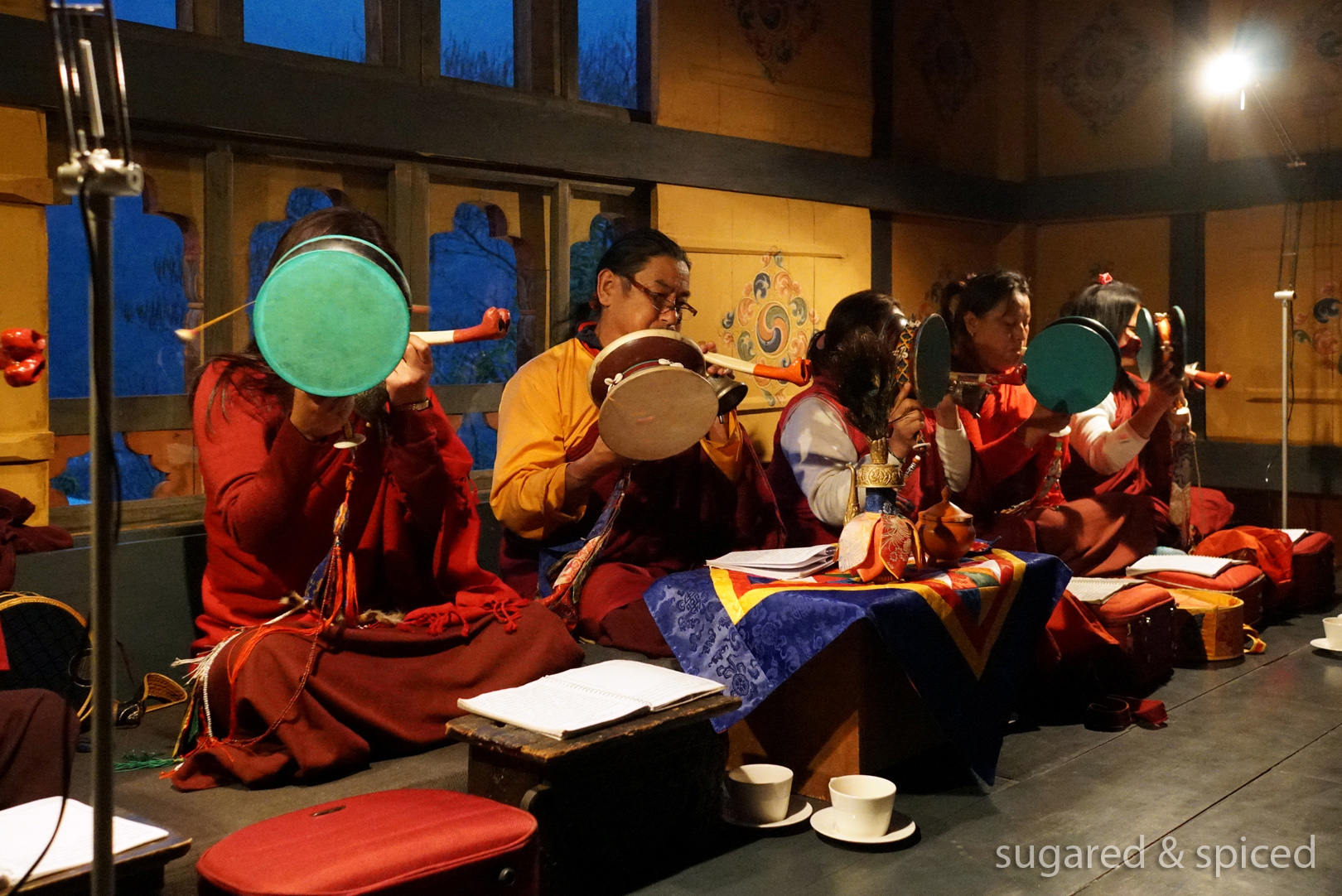
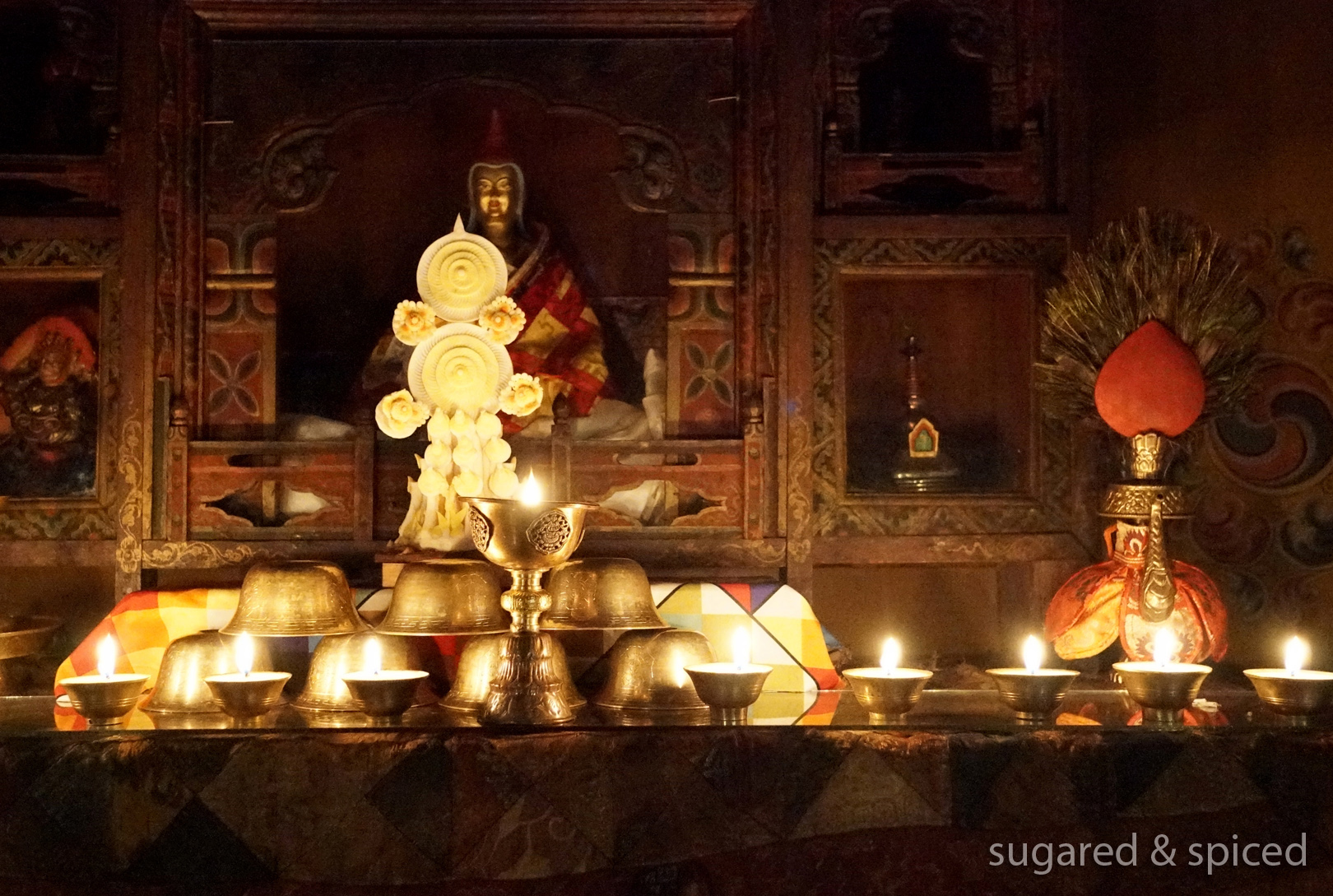
As intriguing as I found the eerie sound of kangling to be, my ears much preferred the drangyen (lute) and yangchen (hammered dulcimer) melodies played by this lovely musician during our dinner, which was enjoyed outside on the terrace.
入夜後,庭院裡點起了溫暖的篝火。雖然還不餓,但仍在這裡坐了一會兒,喝杯熱茶,享受樂手現場演奏的琵琶和揚琴。揚琴的音色時而如叮咚山泉,時而似大珠小珠落玉盘,和上不丹歌謠,讓人聽得入迷。
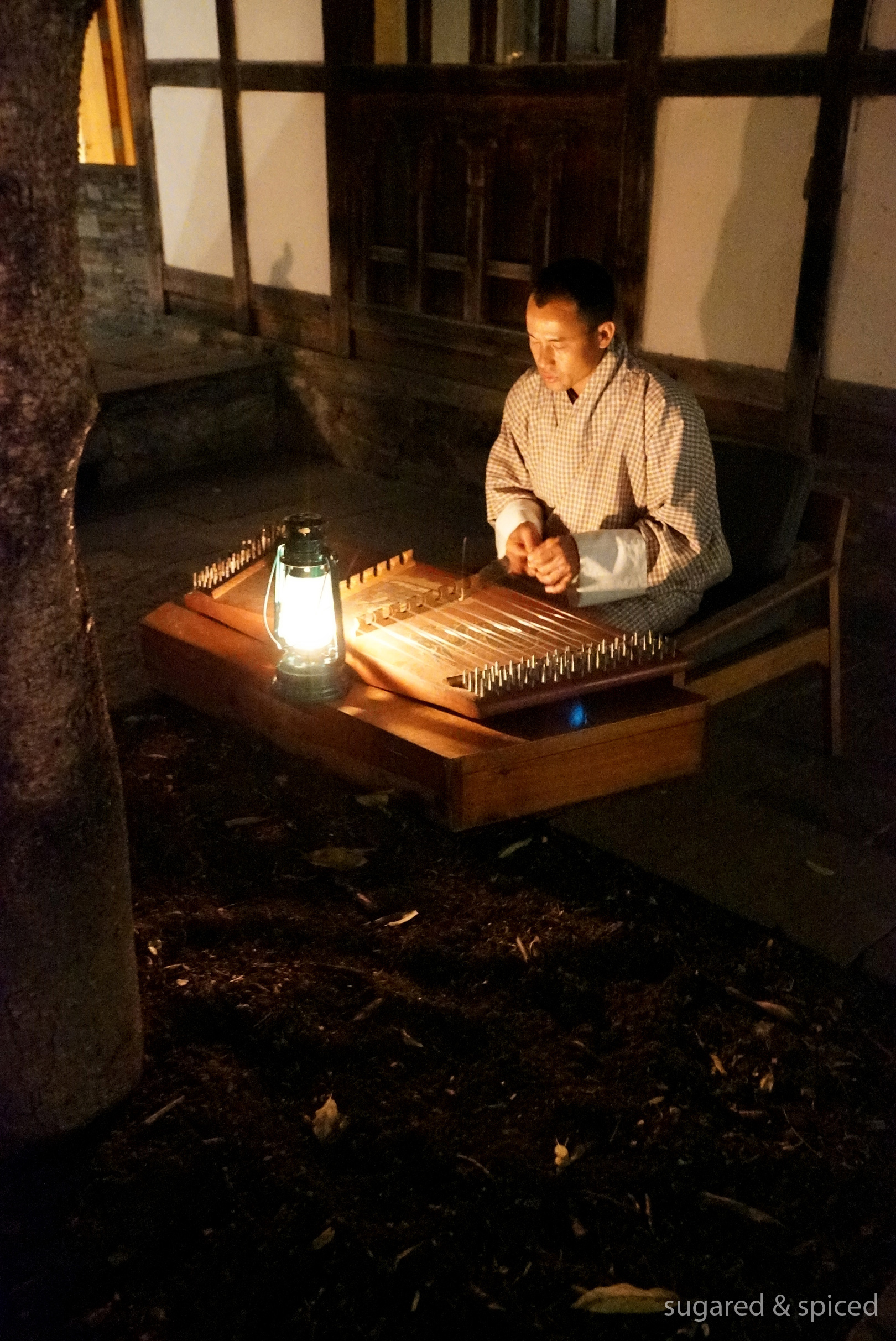
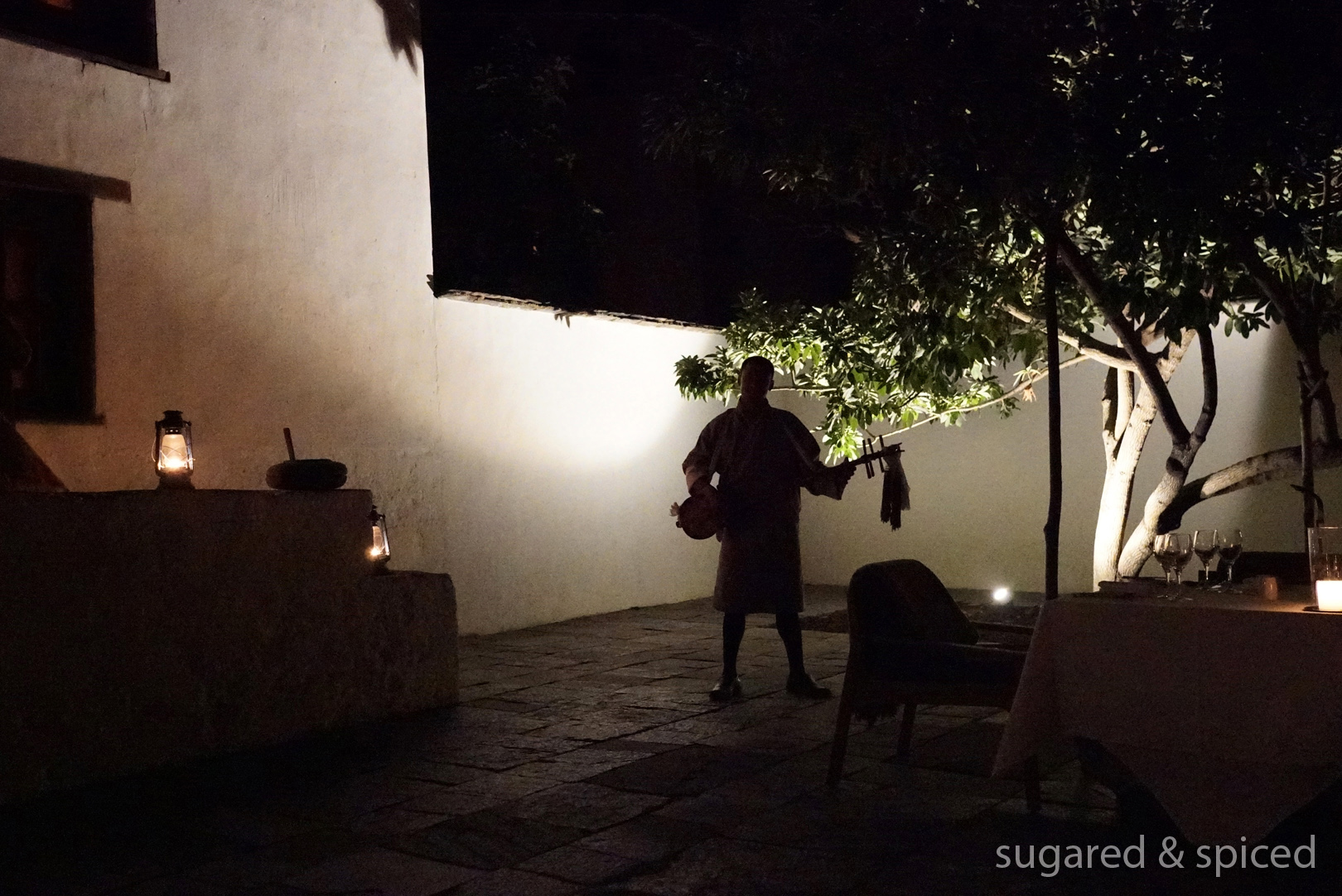
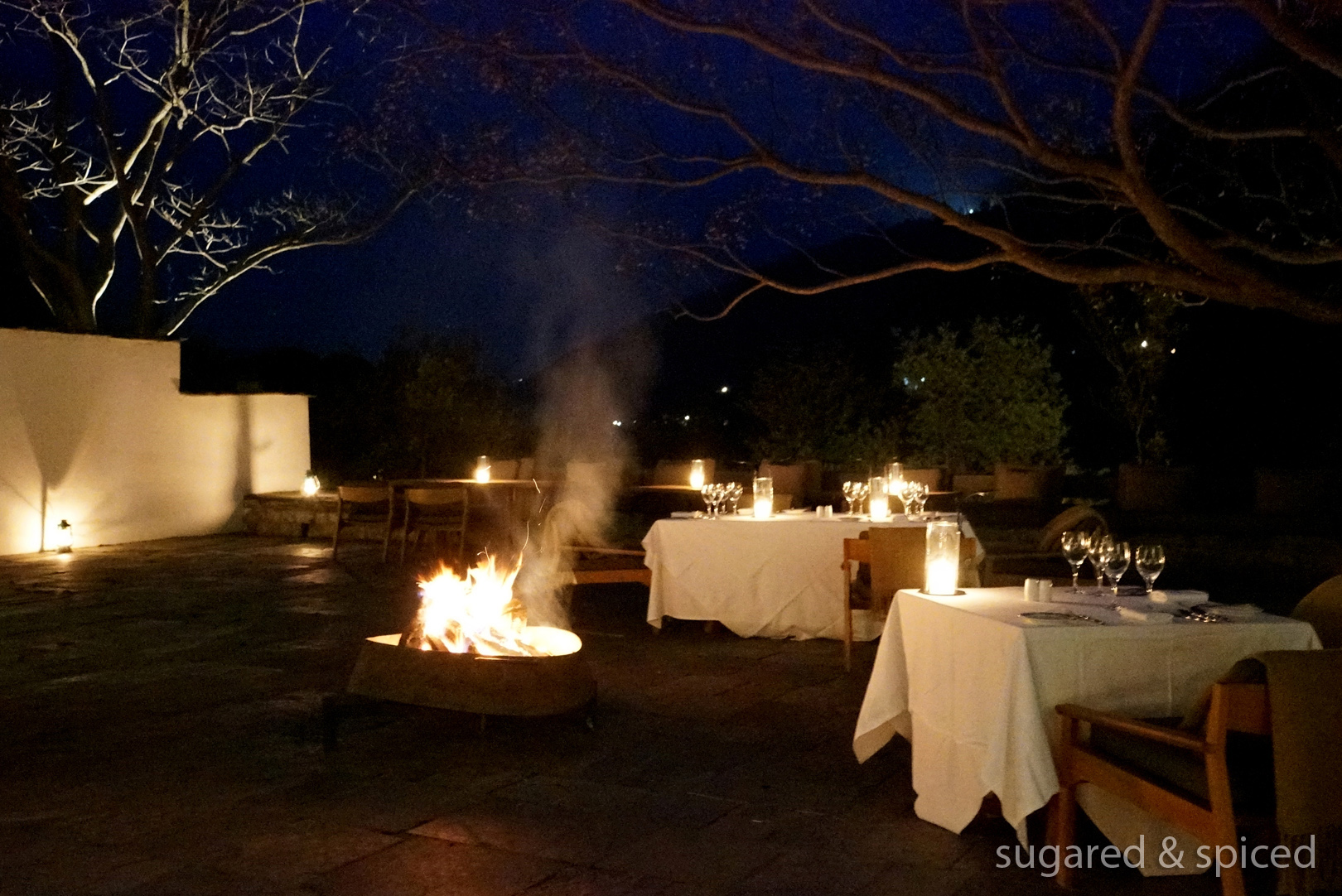
As day 4 drew to an end, I realized that our journey was more than half way over, and a sudden feeling of reluctance hit me – a reluctance for this trip to end, a reluctance to leave Bhutan. I reminded myself that for the next three days, I must open my eyes and heart even more to soak up all that wonders of this beautiful land.
第四日來到尾聲,驚覺這趟旅程已過半。回想這幾天在不丹感受到的極致美好,一種非關繁華,安定而紮實的存在感,心裡居然開始有點不捨。只能提醒自己在剩下的三天里,要更加放開心胸感受、吸收這片土地帶來的震撼…
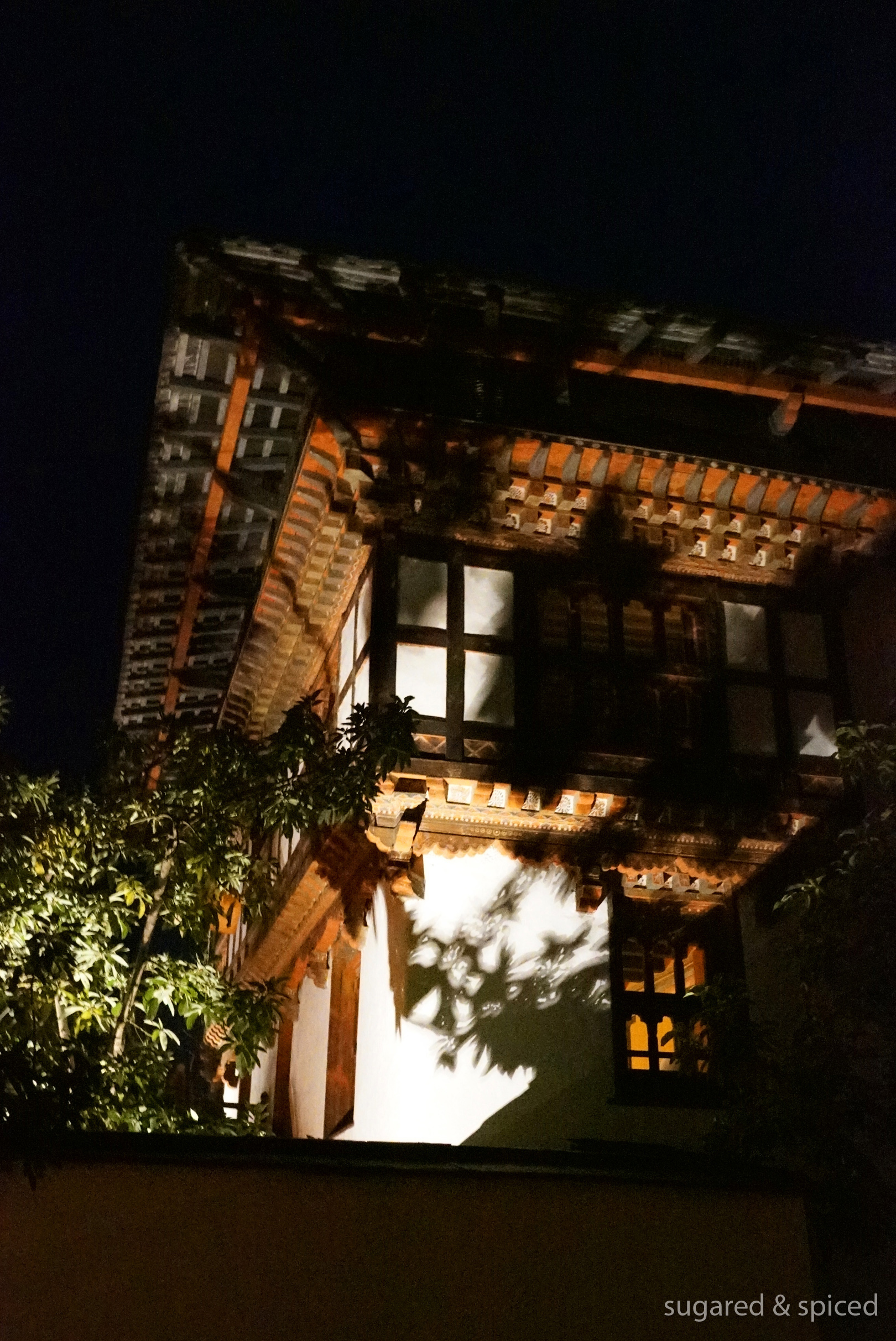
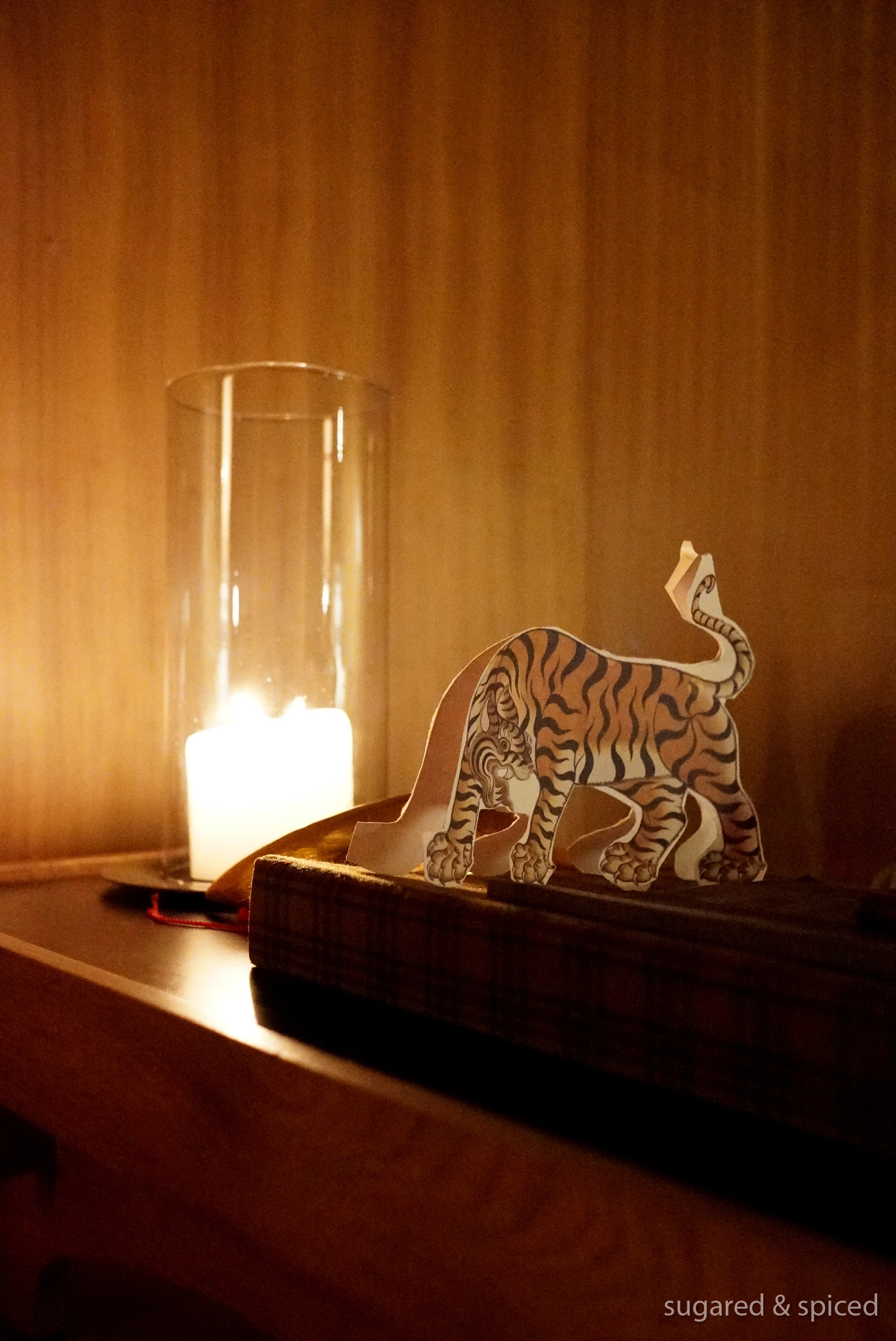
Day 5, Punakha
Our first stop today was Punakha Dzong, the second largest and second oldest dzong (fortress) in Bhutan, constructed in 1637. Sitting majestically at the confluence of the Pho Chhu and Mo Chhu rivers, it is often considered the most beautiful dzong in the country, especially during spring time when lilac-colored jacaranda trees are in full bloom. During our time of visit, it exhibited another sensuality – a heavy mist was floating down from mountain tops, rendering the picturesque dzong almost fairy castle-like.
位於公河 (Po Chhu) 與母河 (Mo Chhu) 相匯之處的普納卡宗建於1637年,是不丹歷史裡第二悠久、面積第二大的「宗」(宗 = 堡壘)。聽說這裡的景色在春天藍花楹盛開時最為動人,不過我們到訪時有另一種詩意 – 山頭飄下濃濃的霧,讓堡壘看起來宛如在飄渺的仙境之中。
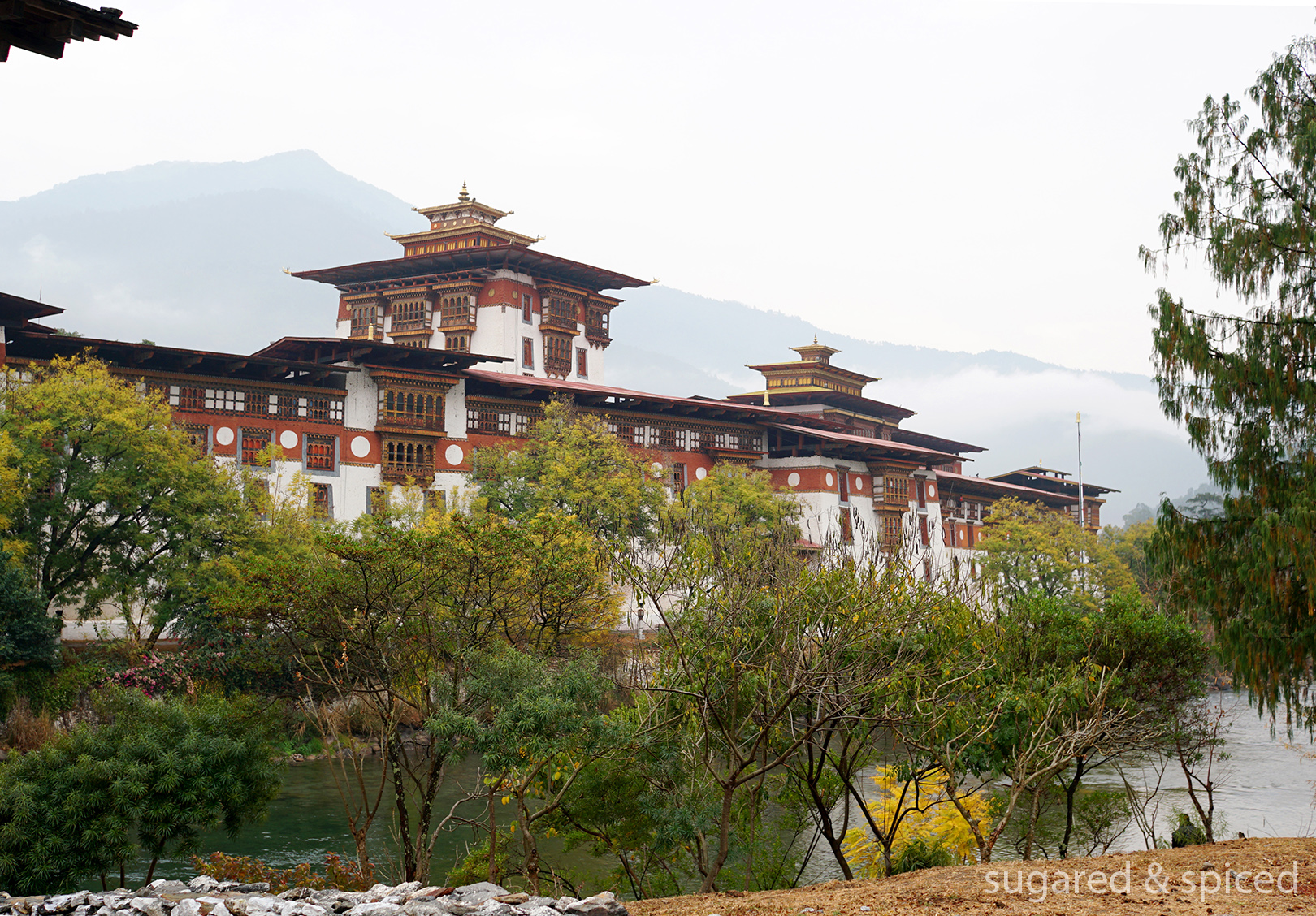
This formidable structure was, for some three hundred years, the administrative center and the seat of the government until Bhutan’s capital was moved to Thimphu in 1955. It still holds great significance today as the winter residence of Je Khenpo (the chief abbot) and his entourage of monks; it is also where all of Bhutan’s kings have been crowned, as well as the royal wedding venue for the current King and Queen back in 2011.
Punakha 曾經是不丹的首都,可想而知,這座宗在歷史上扮演了許多重要角色。這里至今仍是 Je Khenpo(不丹國師 / 最高宗教領袖)的冬日居所,同時也是歷任國王加冕之地,現任國王和皇后在2011年的皇室婚禮也在此舉行。
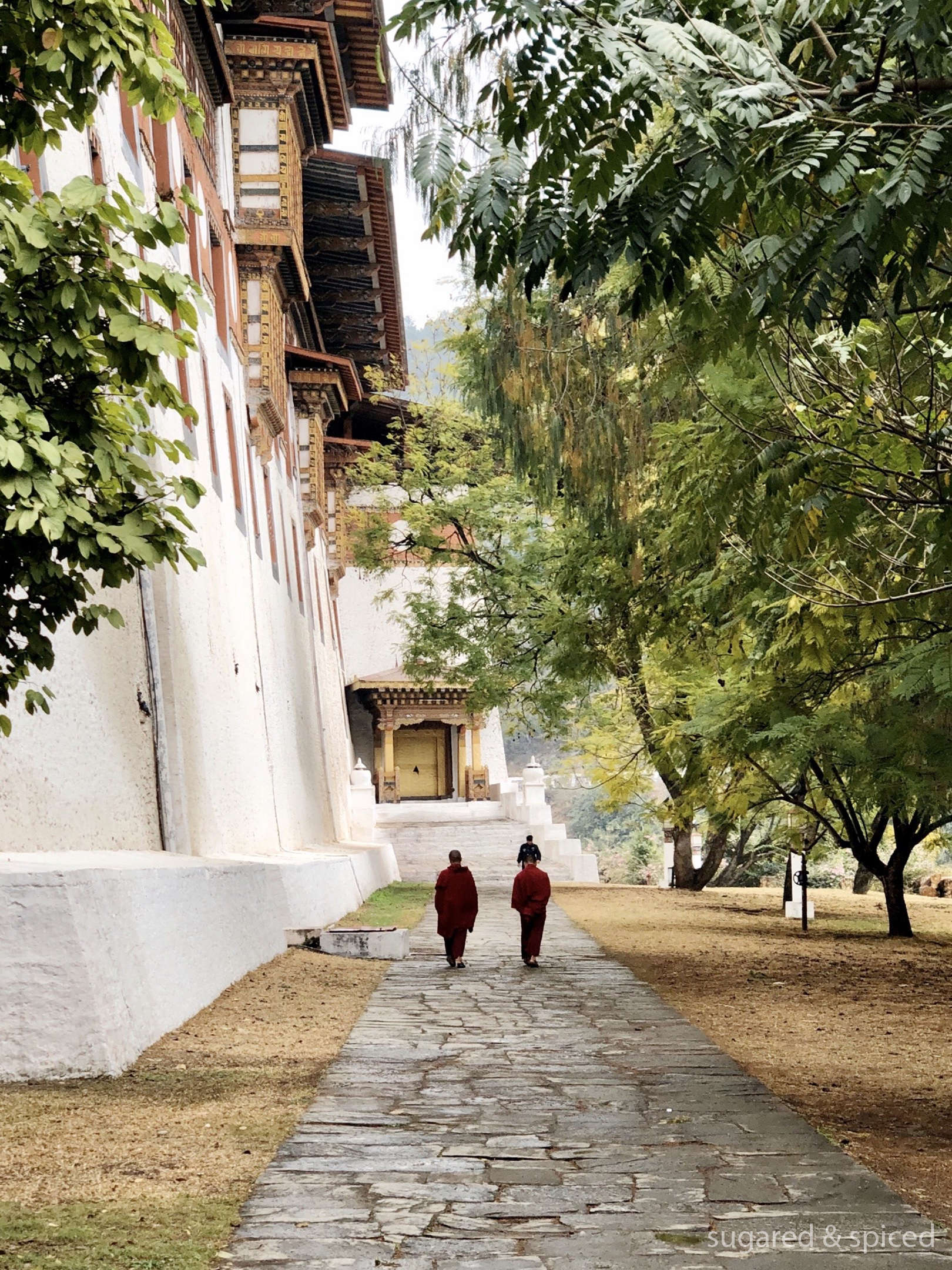
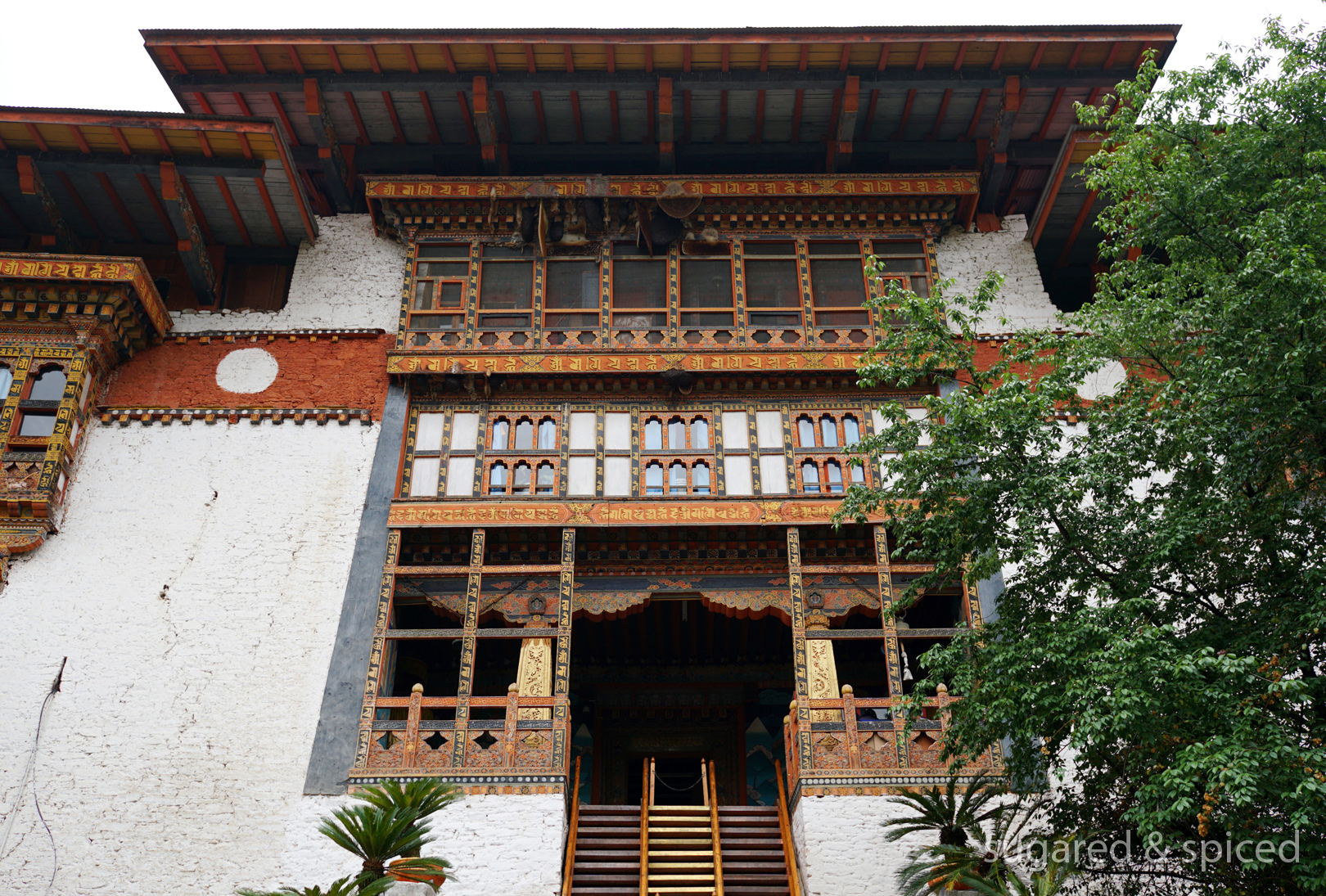
Punakha Dzong is massive, sprawling, and mysterious, home to many national treasures accessible only by the King, the Je Khenpo, and two guardian lamas. Impressively, this structure only took about a year to build, and was done completely without the use of nails.
普納卡宗巨大而神秘,裡面藏了許多國家寶藏,某些建築只有國王、國師、以及兩位守衛喇嘛得以入內。令人驚訝的是,這座龐大的堡壘只花了一年時間就建造完成,*過程中未使用任何一根釘子,完全採用榫接的方式搭建。
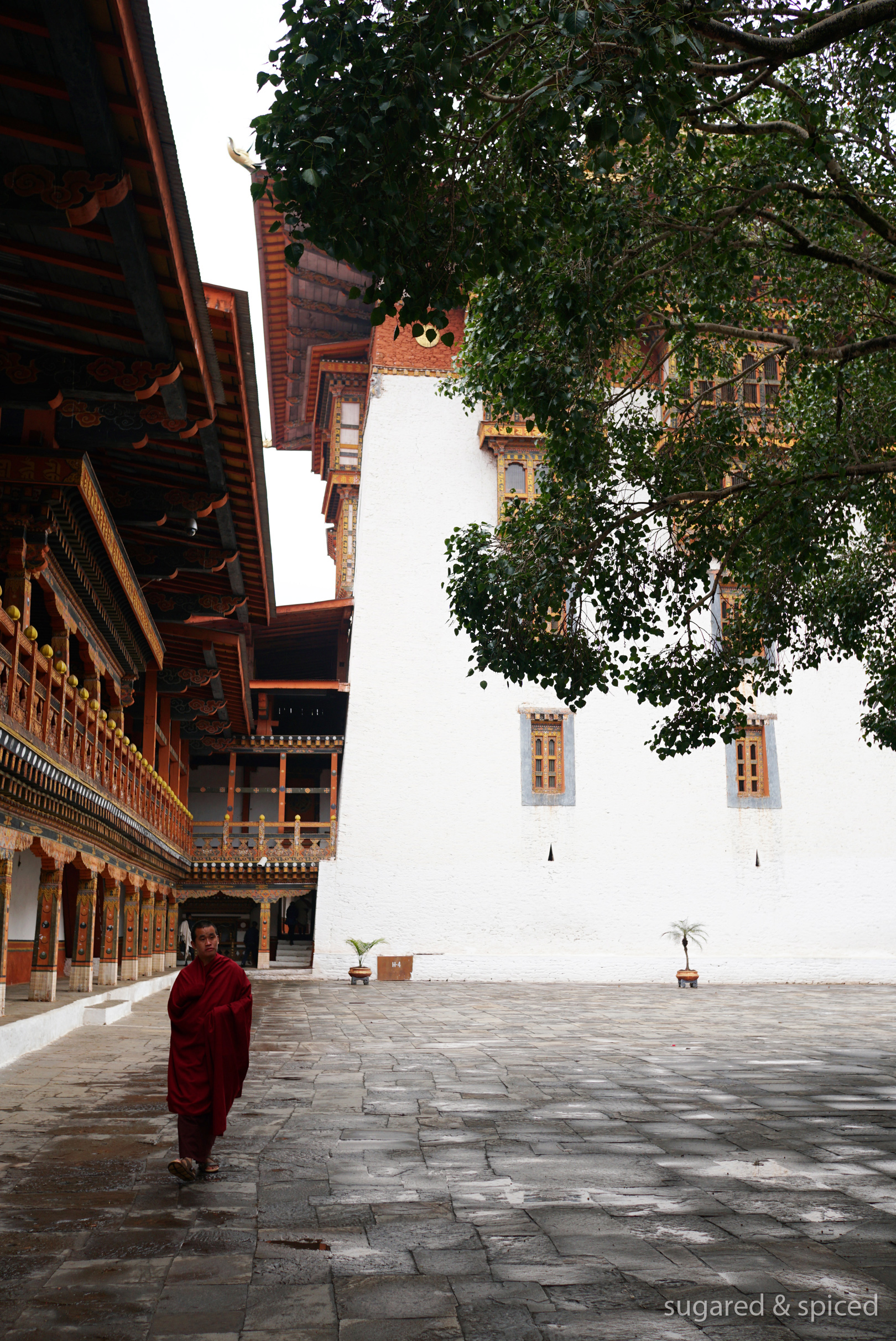
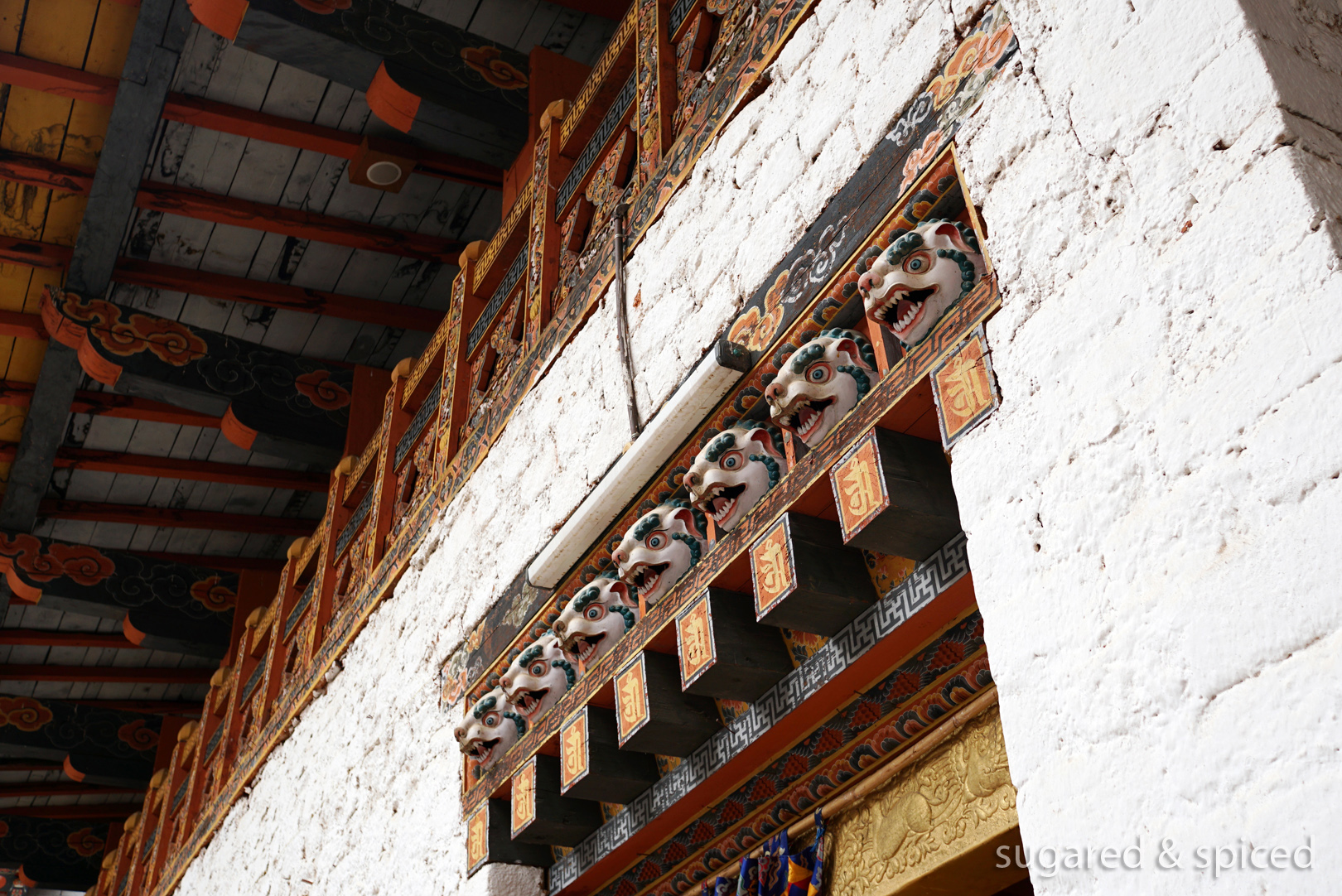
After thoroughly admiring the exquisite exteriors, we headed into the kunrey, the hundred-pillar assembly hall (which actually has only 54 pillars). Covering the walls of the hall are exceptional murals depicting the life of Buddha, from his birth as Prince Siddhartha Guatama to his eventual enlightenment under a bodhi tree. There are also three monumental golden statues of the Buddha, Guru Rinpoche and Zhabdrung (known colloquially as the Bearded Lama, he was a Tibetan lama who unified Bhutan as a nation-state) dating back to the mid-18th century.
開放給游客參觀的佛堂里供有三座巨大的聖象,分別是釋迦牟尼佛、將藏傳佛教帶入不丹的蓮花生大士,以及統一不丹的夏宗法王。牆上的唐卡壁畫精美地描繪著釋迦摩尼佛的一生,從他的皇室出生直至在菩提樹下大徹大悟的過程。
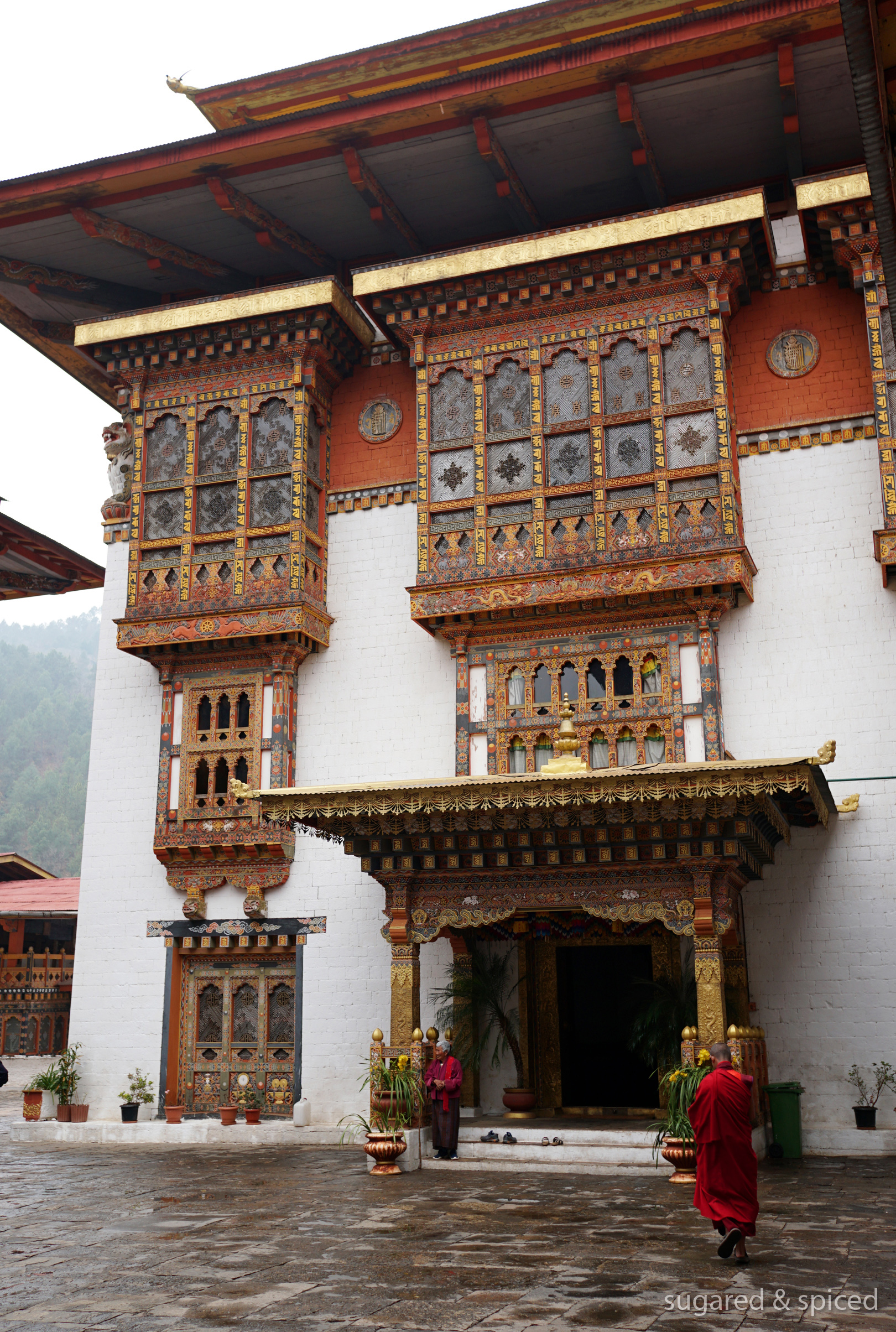
An old man, chanting as he turned the giant prayer wheel.
一位當地的老人,邊唱誦邊轉動著巨大的經輪。
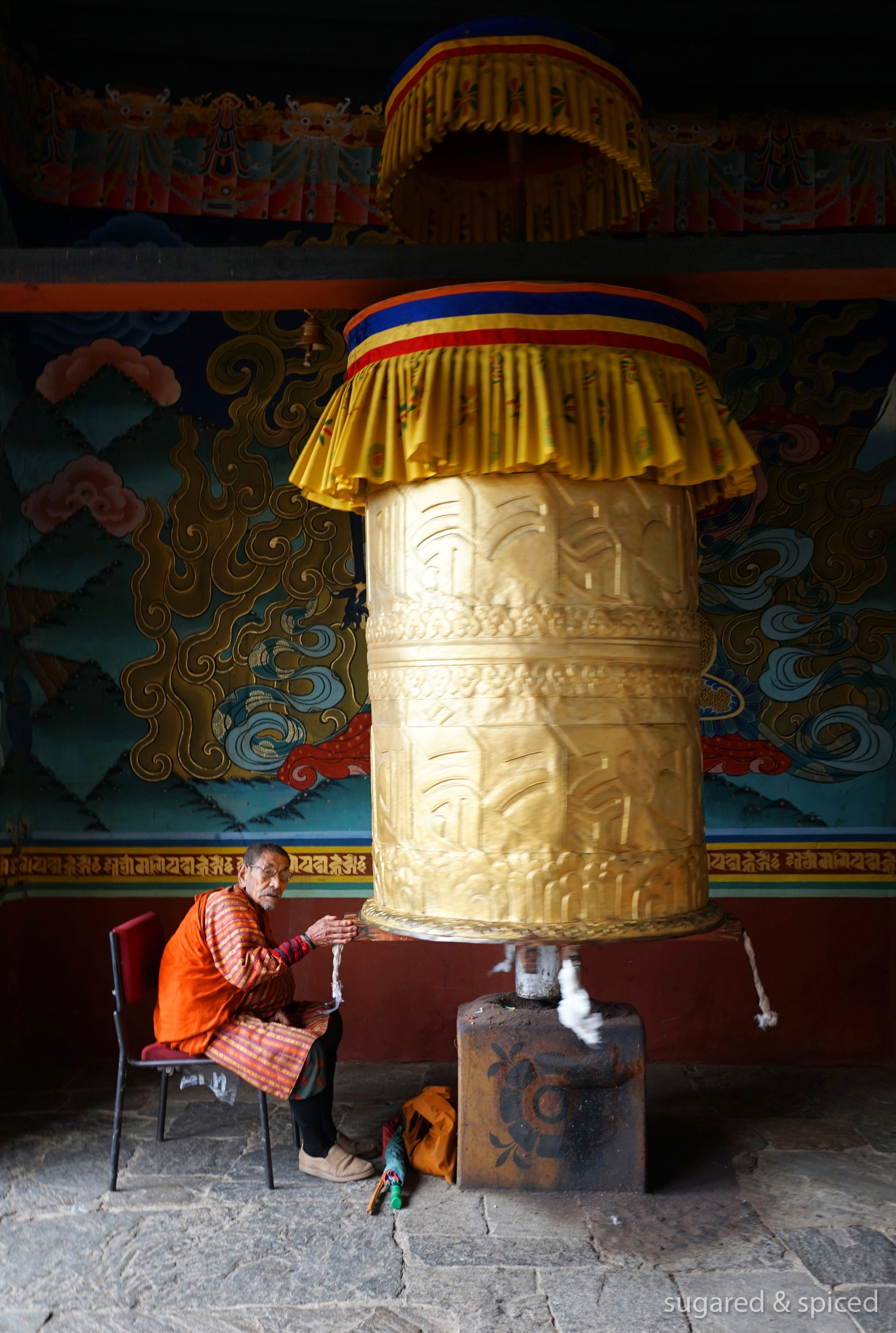
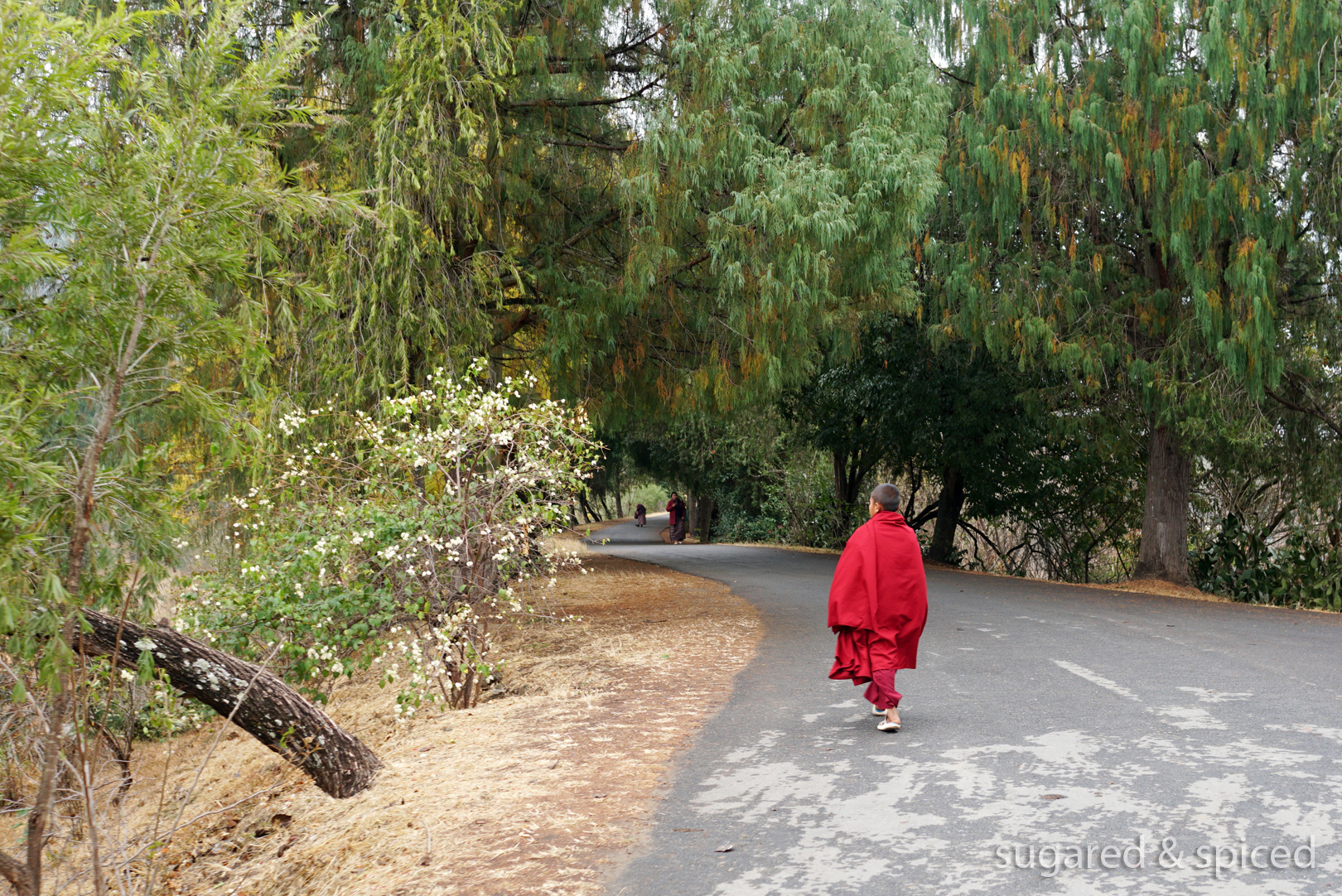
From Punakha Dzong, it was a short stroll to reach Bhutan’s longest suspension bridge, an excellent vantage point to view the gorgeous river banks of Po Chhu.
參拜完普納卡宗,我們步行至不丹最長的吊橋。對岸是名為 Punakha Ritsha Village 的小鎮,走在橋上可欣賞兩岸的農村風景,腳下是緩緩流過的 Po Chhu 公河。
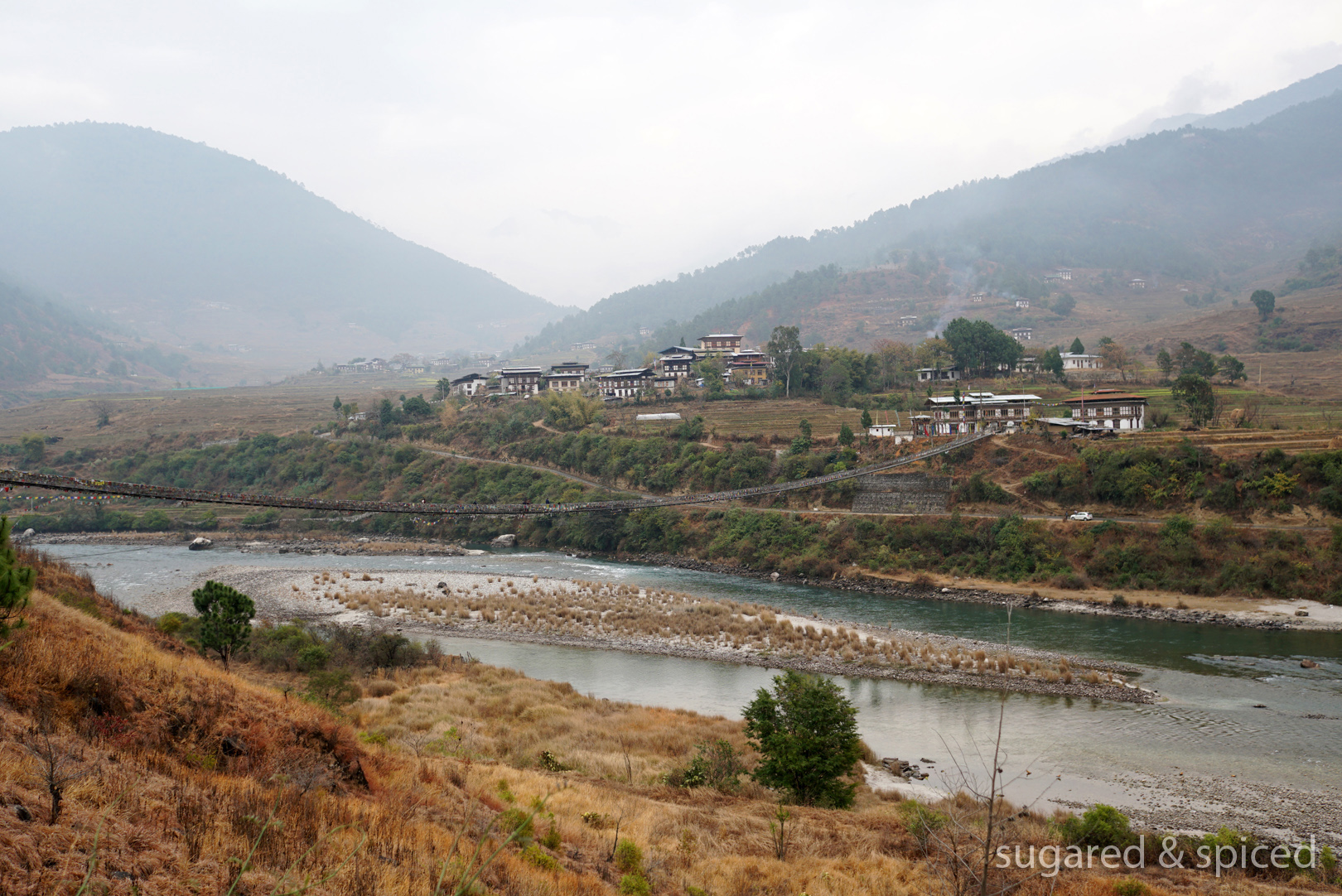
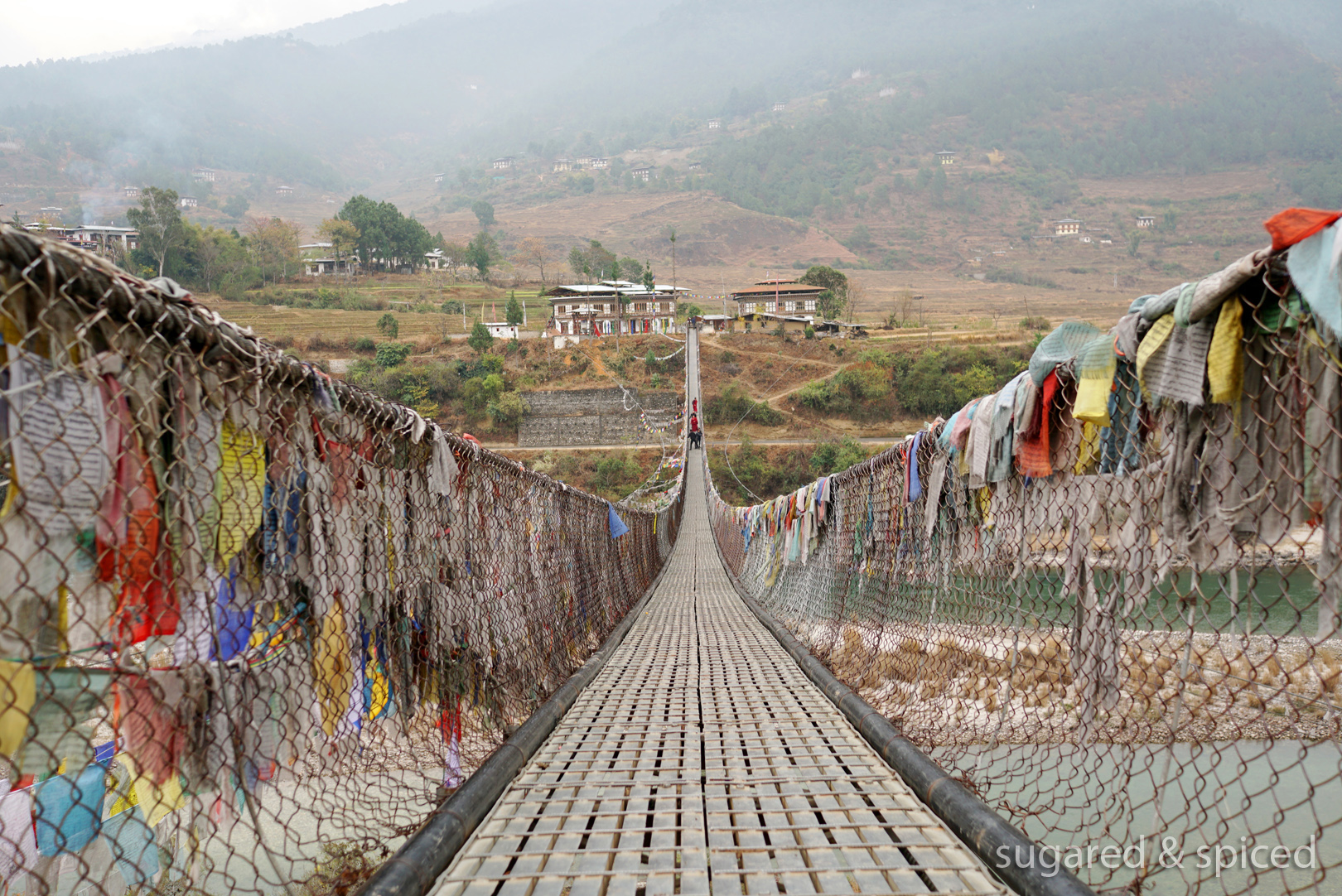
Here, I noticed a woman wearing a conical hat made out of bamboo strips and ends with a sharp point to the sky. Dawa explained that those wearing these conical hats are Layaps, the semi-nomadic yak herders of Tibetan ancestry. They usually live in a settlement of about 100 houses high up at 3800m in Northern Bhutan, but during harsh winters, they come down to stay in lower altitude villages like Punakha. This friendly Layap woman told Dawa that as winter was drawing to an end, she would soon return to the high mountains with her herd.
Interestingly, other than the milk and fur of yaks, the Layaps can also profit from harvesting cordyceps, a fungus that’s highly sought after for its potential health values. Cordyceps are used extensively in traditional Chinese medicine, and though there have been no well-controlled clinical trials in humans to date, they still cost over 20,000 USD per kilogram!
橋的入口處坐著一位佩戴竹編尖帽子的女人。Dawa 解釋說這帽子是 “Layap 拉雅” 半游牧民族特有的,他們一般都和氂牛一起生活在不丹北部海拔3800米高的地區,只有在冬天極度寒冷時會暫時移居至海拔較低的村落。友善的拉雅女人和 Dawa 用當地語言聊著天,說冬天即將結束,她差不多準備要和族人一起回到山上了。
拉雅人主要靠氂牛的毛(可製成衣服、帳篷)和牛奶(奶油、芝士的原料)維生,也通過採集冬蟲夏草得到可觀的收入,聽說冬蟲夏草現在一公斤要價2萬美元呢。
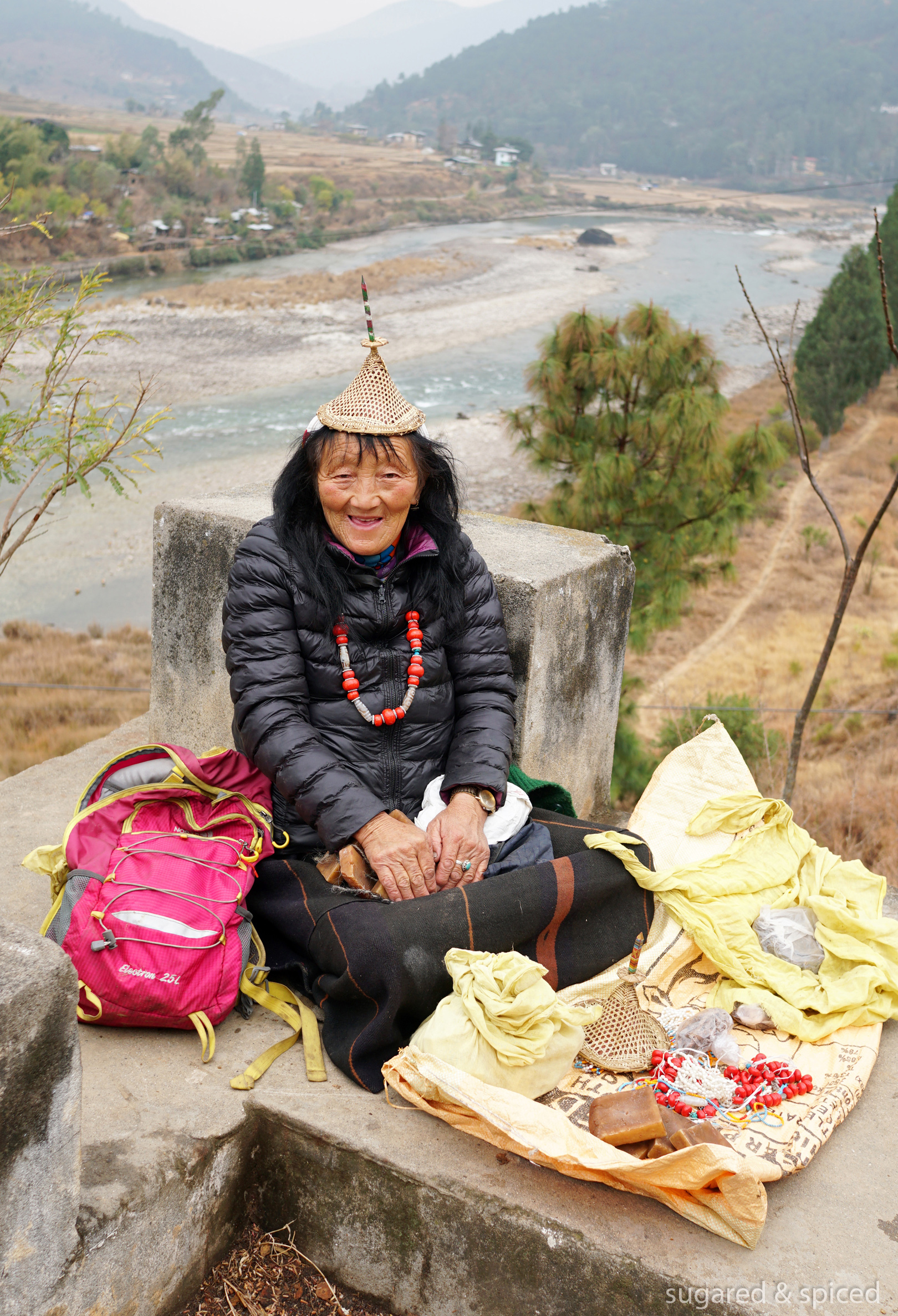
After lunch back at the lodge, it was time to hike to Khamsum Yulley Namgyal Chorten. We followed a narrow track along a little creek and through rice paddies, chili pepper farms, grazing ponies, cow sheds…
在 lodge 吃完午餐後,上山參拜 Khamsum Yulley Namgyal Chorten 佛塔。沿著梯田間的小徑往上爬,穿過牛舍、辣椒苗兒、吃草的馬…一片質樸的山村景象,看著令人舒心。
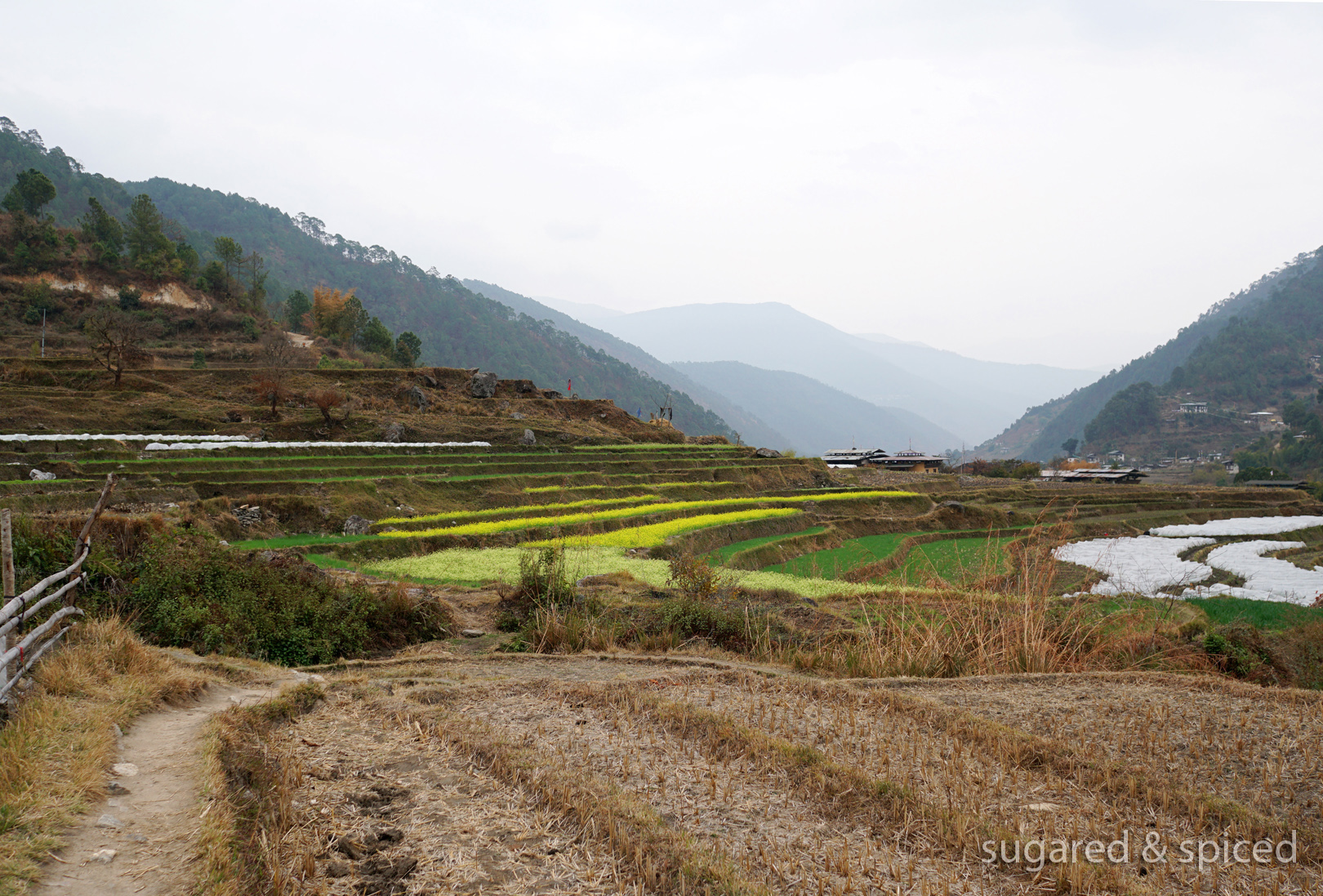
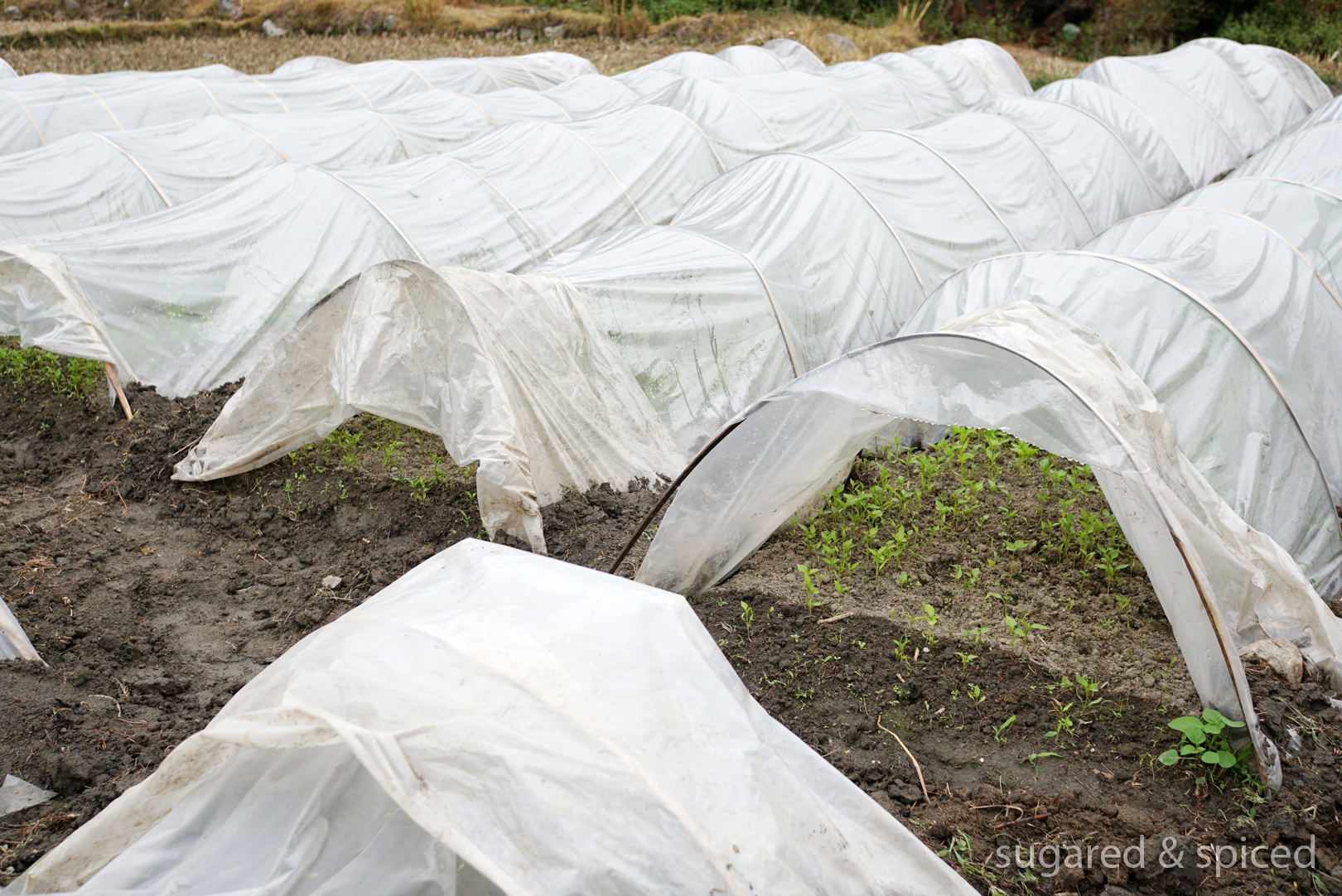
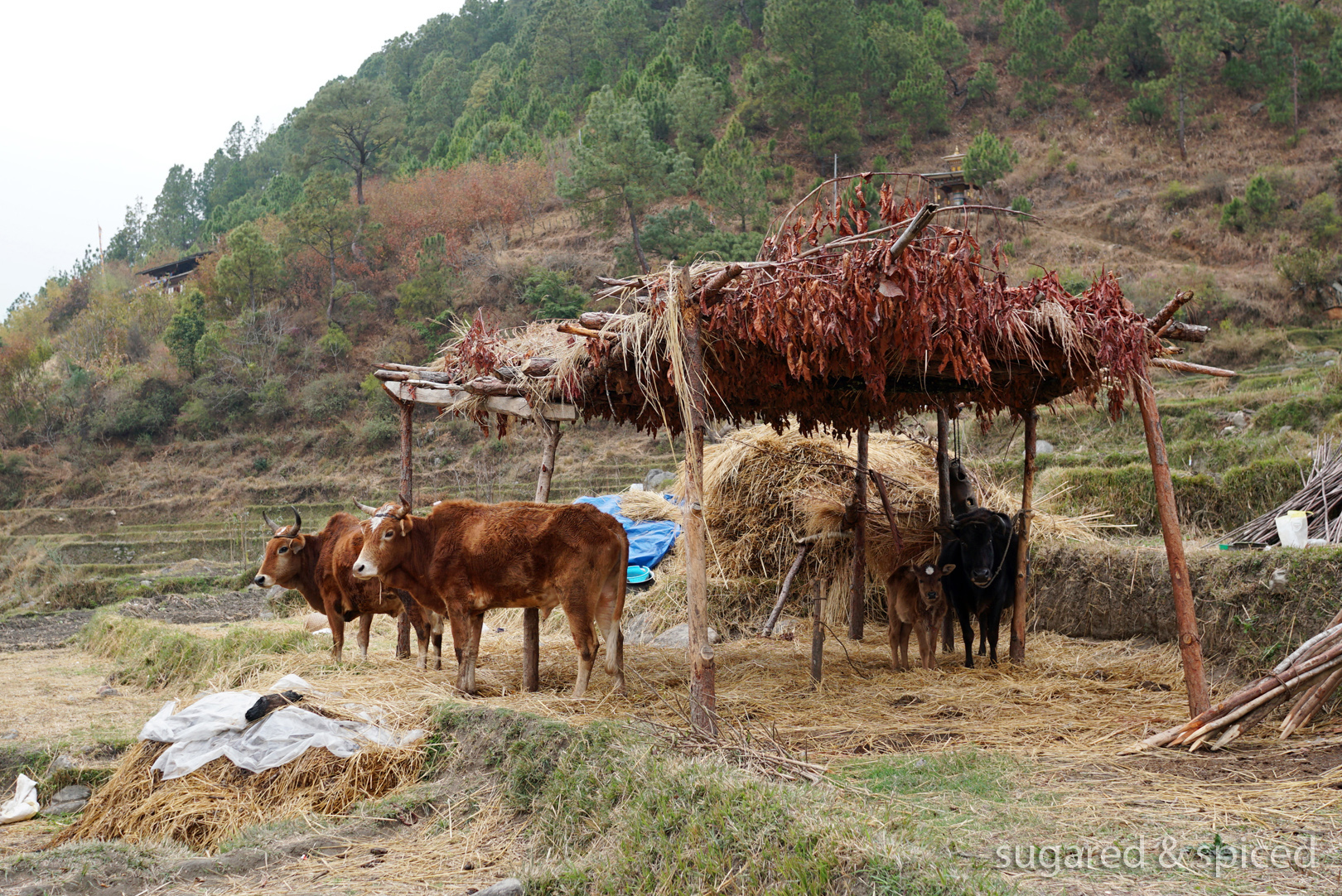
The scenic route was made even more memorable by the kind faces we saw along the way. First, there was a group of 7 or 8 teenage students in their goh and kira. They were coming down the hill as we were climbing up, and we crossed path amidst the rice paddies. “Kuzu zangpo“, they said hello to us in Bhutanese, with a shy expression and smiles so pure and genuine, I couldn’t help but stare for a second before I returned the greeting.
“Is there a school up the hill?” I asked Dawa after the students had passed us.
“No, it’s an auspicious day today, so they just went to the temple to pray.”
I tried to think back to my after school hangouts with friends. What were we doing back then? Whatever we did, it definitely did not involve hiking to a temple.
沿途遇到的人們,臉上無一不綻放著溫暖笑容。令我印象最深刻的是一群穿著傳統制服的中學生們,他們從山上下來,和我們在稻田中相遇。 “Kuzu zangpo”,他們用當地語言跟我們打招呼,笑容燦爛中夾雜點害羞,映著後方的層層梯田,太美了。
“山上有學校嗎?” 等學生們離開後,我好奇地問 Dawa。
“不,今天是個好日子,他們是上山去祈福的”。
學生們的課後活動,居然是結伴上山拜佛。回想當年的自己,在做什麼呢?大概跟朋友們在星巴克喝星冰樂,還自以為很酷吧…
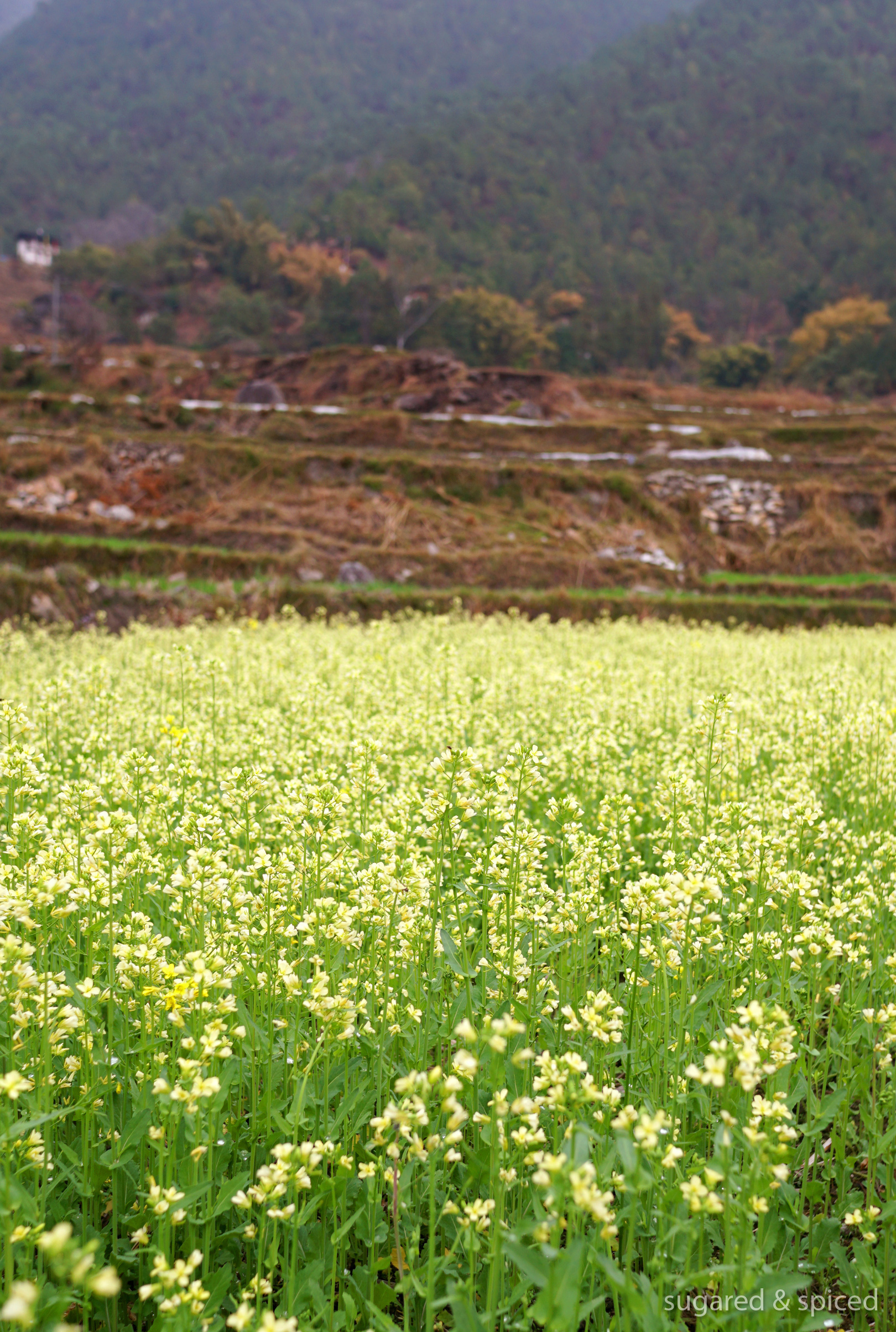
We also came across a group of archers, who joked enthusiastically that we were a blessing to them – apparently the game had just ended the very moment we arrived, and they had won. In a nearby tent, generous amounts of ara were being consumed as men and women casually bantered.
路過射箭場時,一場熱烈的比賽正好結束。射箭手們歡呼著,開玩笑說我們是讓他們贏得勝利的幸運星。一旁的帳篷里,看比賽的村民們喝著 ara 聊著天,就這樣度過一個午後。
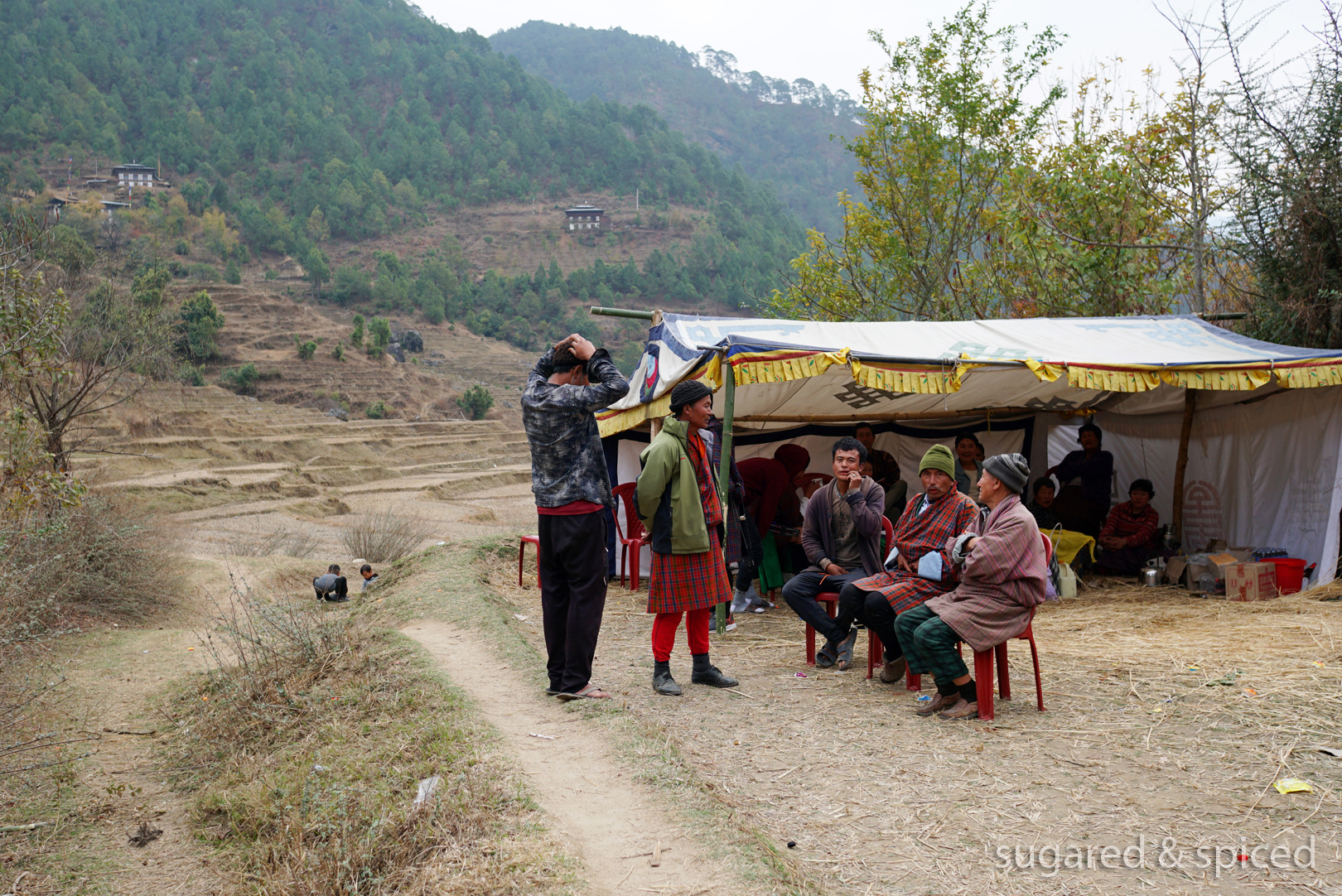
Kids, proudly showcasing their skills of cartwheeling down the terrace fields.
在梯田裡翻著跟斗的孩子們。
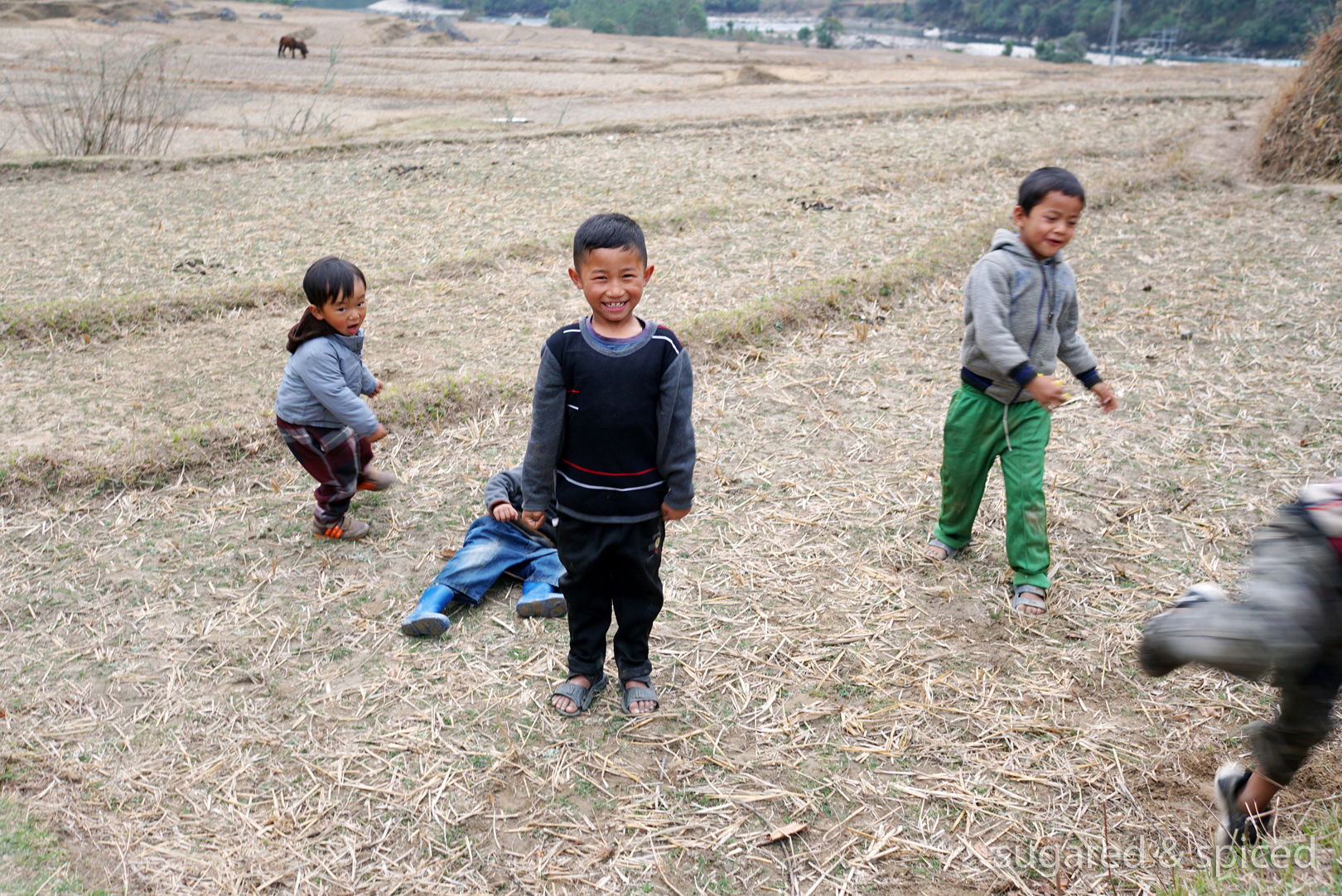
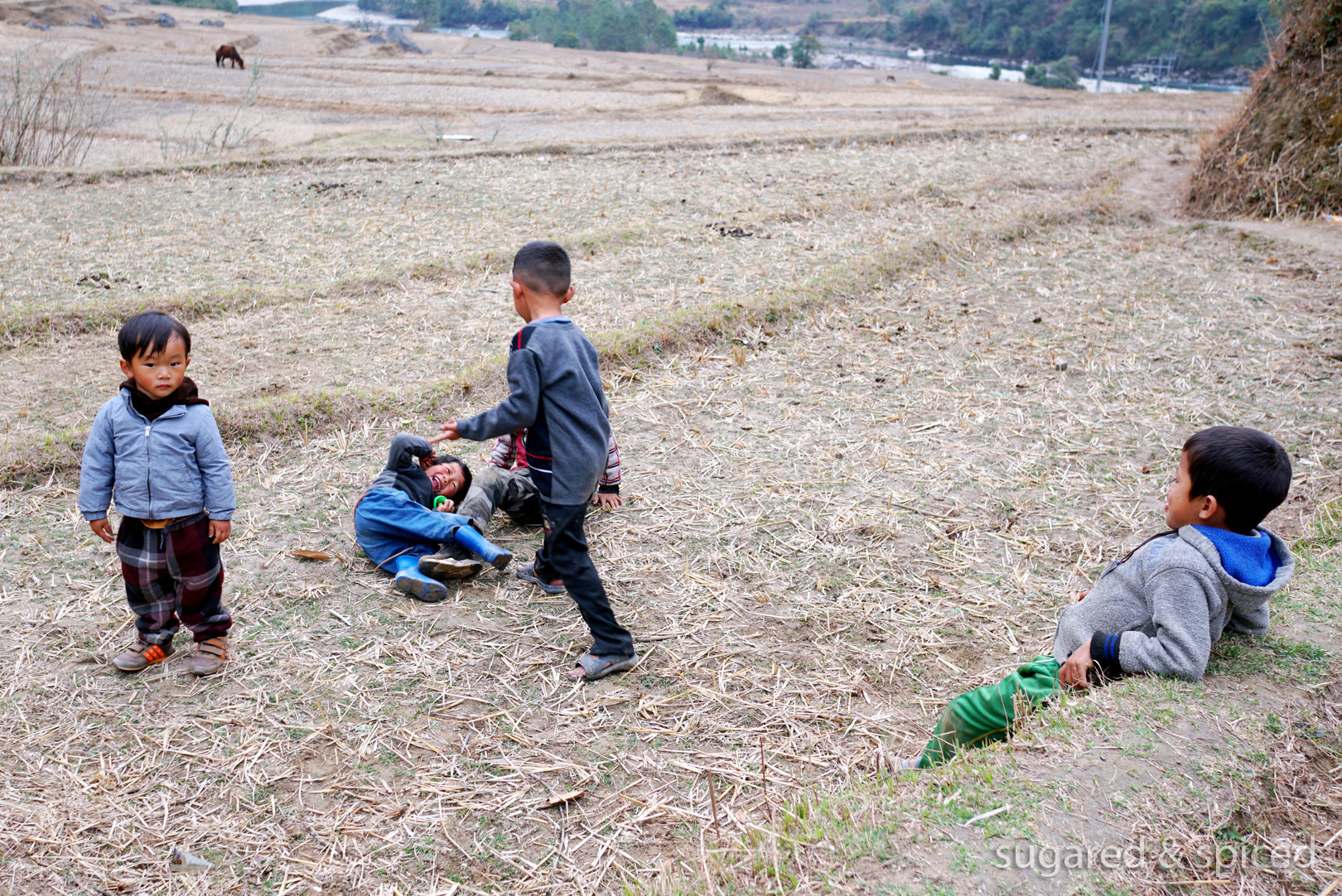
Then there was this family under the shelter of the prayer wheel. The woman holding her baby smiled quietly at us while the man engaged Dawa in a friendly conversation. I couldn’t understand what he was saying, but I knew they were kind words, for his eyes were smiling.
半山腰的轉經輪亭里,一家三口正坐著休息。抱著孩子的媽媽安靜地對我們微笑,爸爸則和 Dawa 聊起了天。雖然聽不懂,但看著他們眼裡的笑意,說的肯定也是親切溫暖的話語吧。
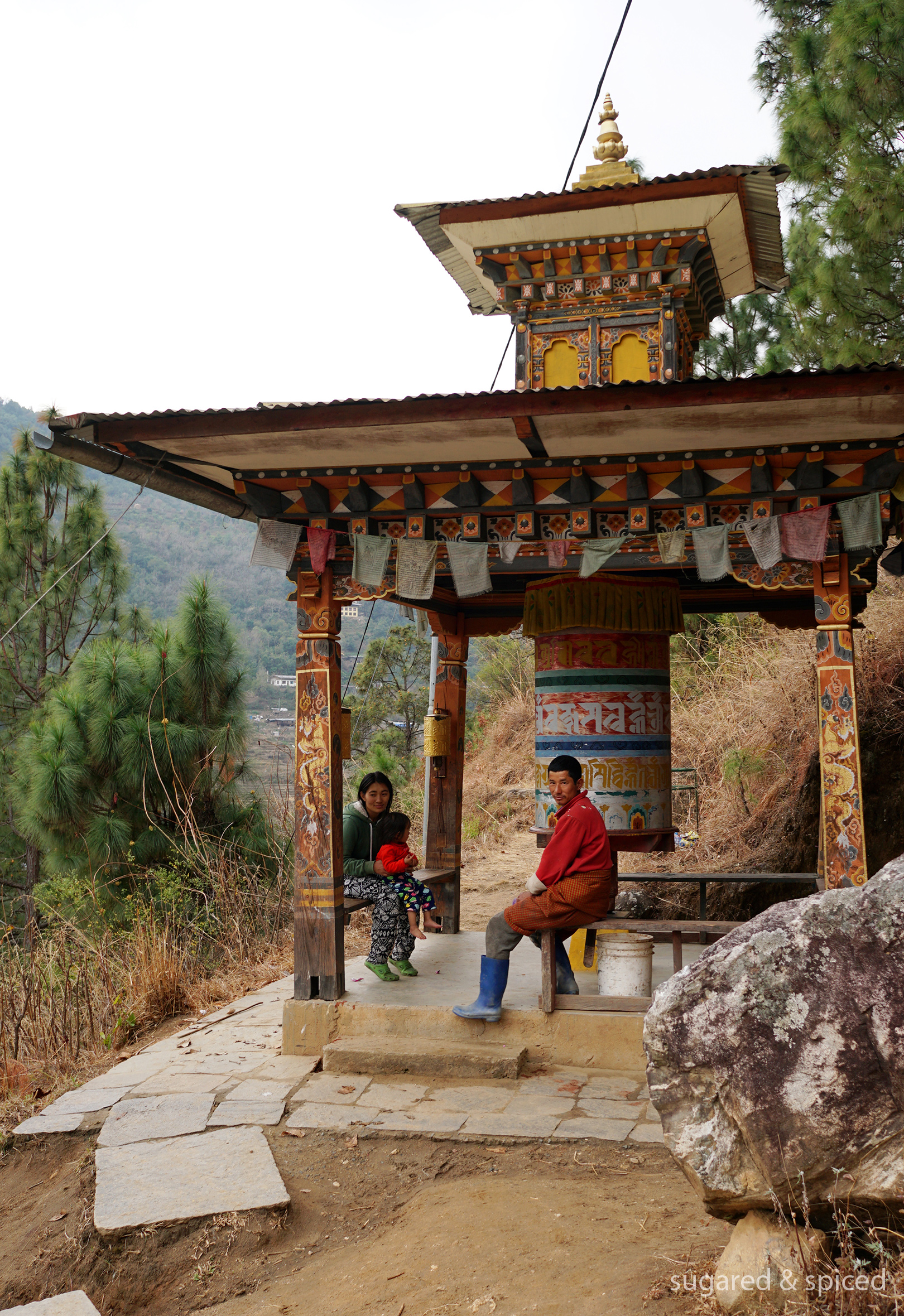
And finally, we arrived at Khamsum Yulley Namgyal Chorten. This four-story, pagoda-style chorten was built by one of the Queen Mothers with the purpose of warding off evil spirits, and bringing peace and harmony to all living things. There had been a ceremony at the temple earlier during the day, and this young monk came over to share the blessed offerings with us. Seeing that we only took a piece of melon, he insisted on us taking more, stuffing a second piece of fruit in our hands.
終於,我們抵達 Khamsum Yulley Namgyal Chorten。這座四層高的佛塔由皇太后所建,目的是驅邪,給生靈帶來和平與安寧。當日早上有個祈福儀式,小和尚拿著一盤加持過的供品跟我們分享,看我們一人吃取了一片黃瓜,硬是又多塞了一些給我們。
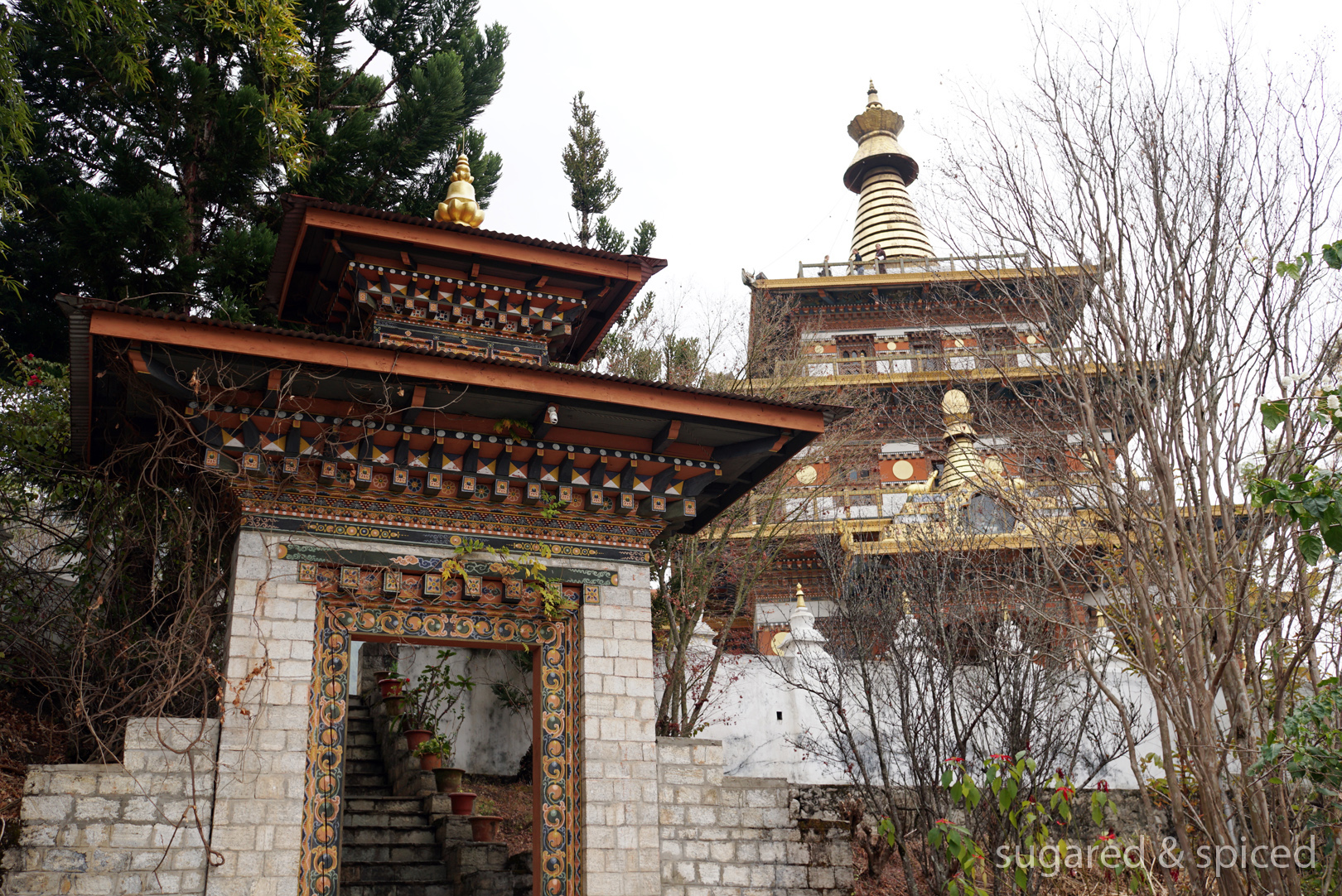
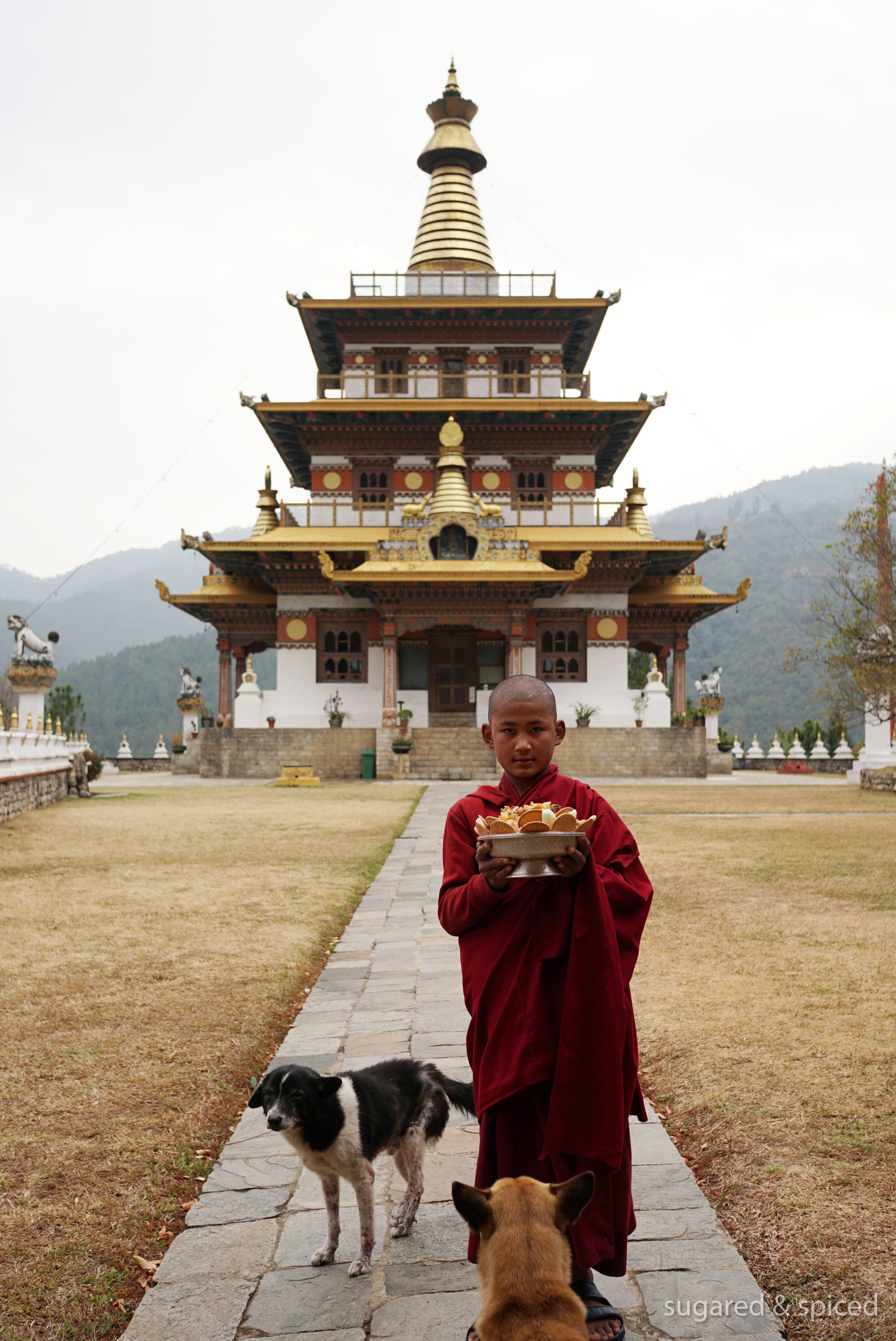
The ambience was peaceful. A few local villagers were having a small picnic inside a well-tended garden with a lovely bodhi tree, two large prayer wheels stand quietly under shelter, and 108 mini chortens surround the entire Khamsum Yulley Namgyal grounds.
佛塔周邊由108座迷你佛塔所圍繞,修剪整齊的花園里種著兩顆菩提樹,幾位村民就地野餐,氣氛寧靜。
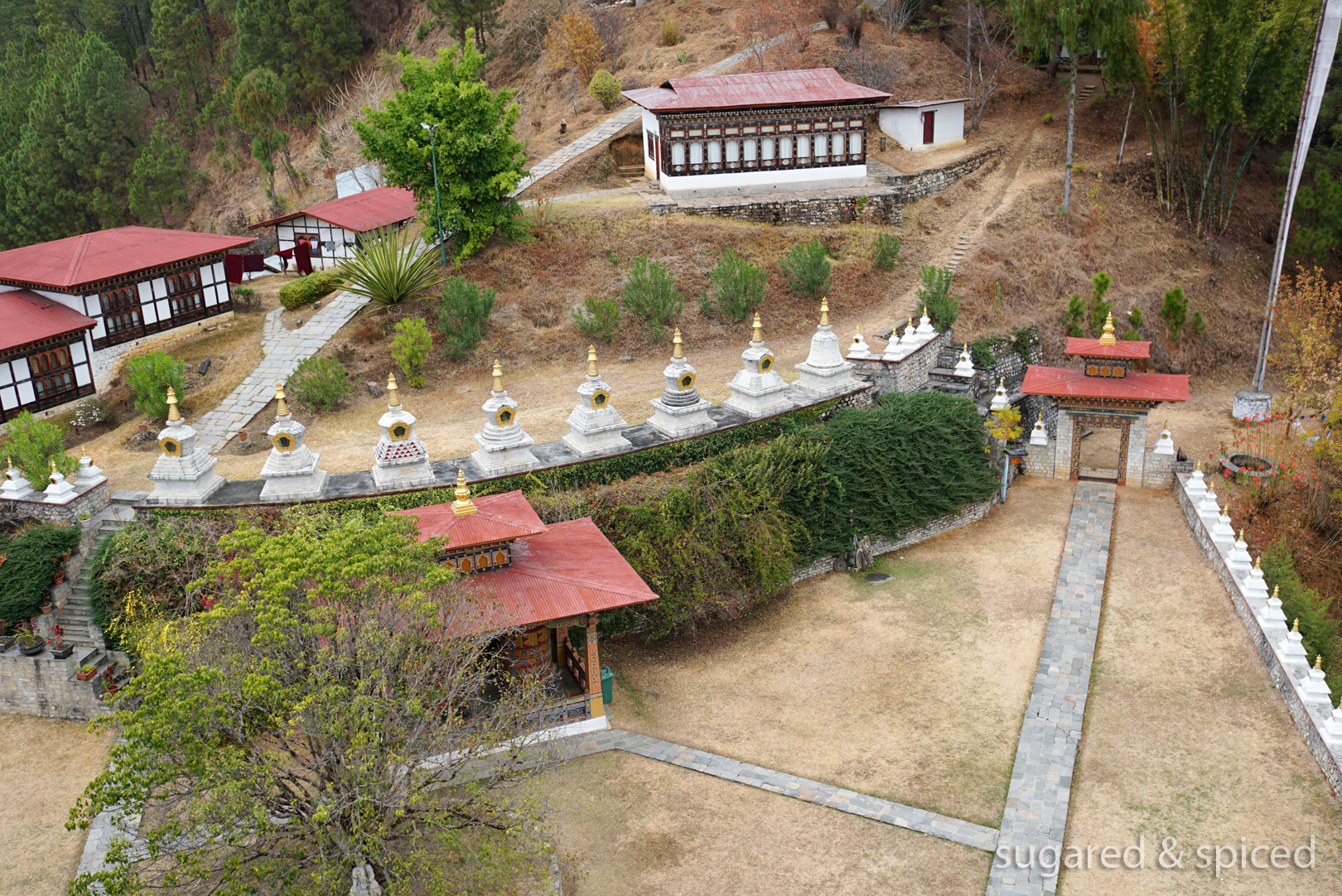
The main chorten was unlike any we’ve visited so far. Upon entering, we immediately came face to face with an imposing statue of Vajrakilaya, the wrathful deity most known for his power in subjugating demons and other obstacles to enlightenment. The giant statue of about 5 meters tall practically fills up the whole room, and upon closer observation, it actually consists of 103 sculptures, each a different manifestation of Vajrakilaya carved in dizzying details and painted in brilliant colors. Wearing a crown of skulls, with weapons in his hands and demons under his feet, the statue was truly an overwhelming presence.
The second and third floor also house statues of wrathful deities, while on the fourth floor sits a golden golden statue of Sakyamuni Buddha in his classic pose, serenely facing the valley below.
這里和我們之前參拜過的寺廟大不相同,是不丹唯一一座用來供奉各類護法神的佛塔。踏入一樓就可看到一座五米高的巨大普巴金剛像,祂三頭六臂四足二翅的模樣十分凶狠,是擁有強大的降魔和消災能力的護法神。佛堂的第二、三層也分別供奉著不同保護神,到了第四層則是一座面容安詳的釋迦摩尼佛像,靜靜地俯瞰整片 Punakha 谷地。
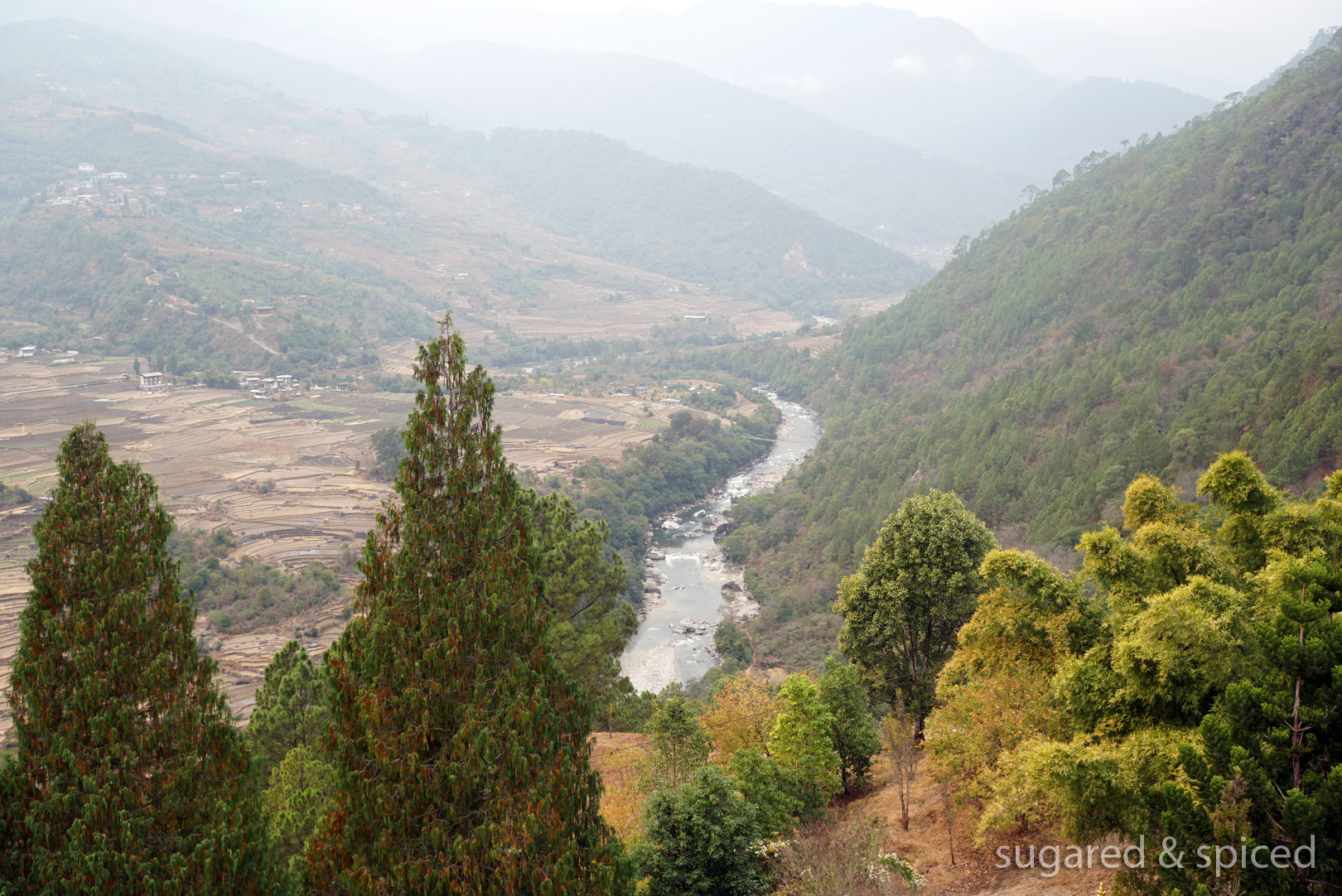
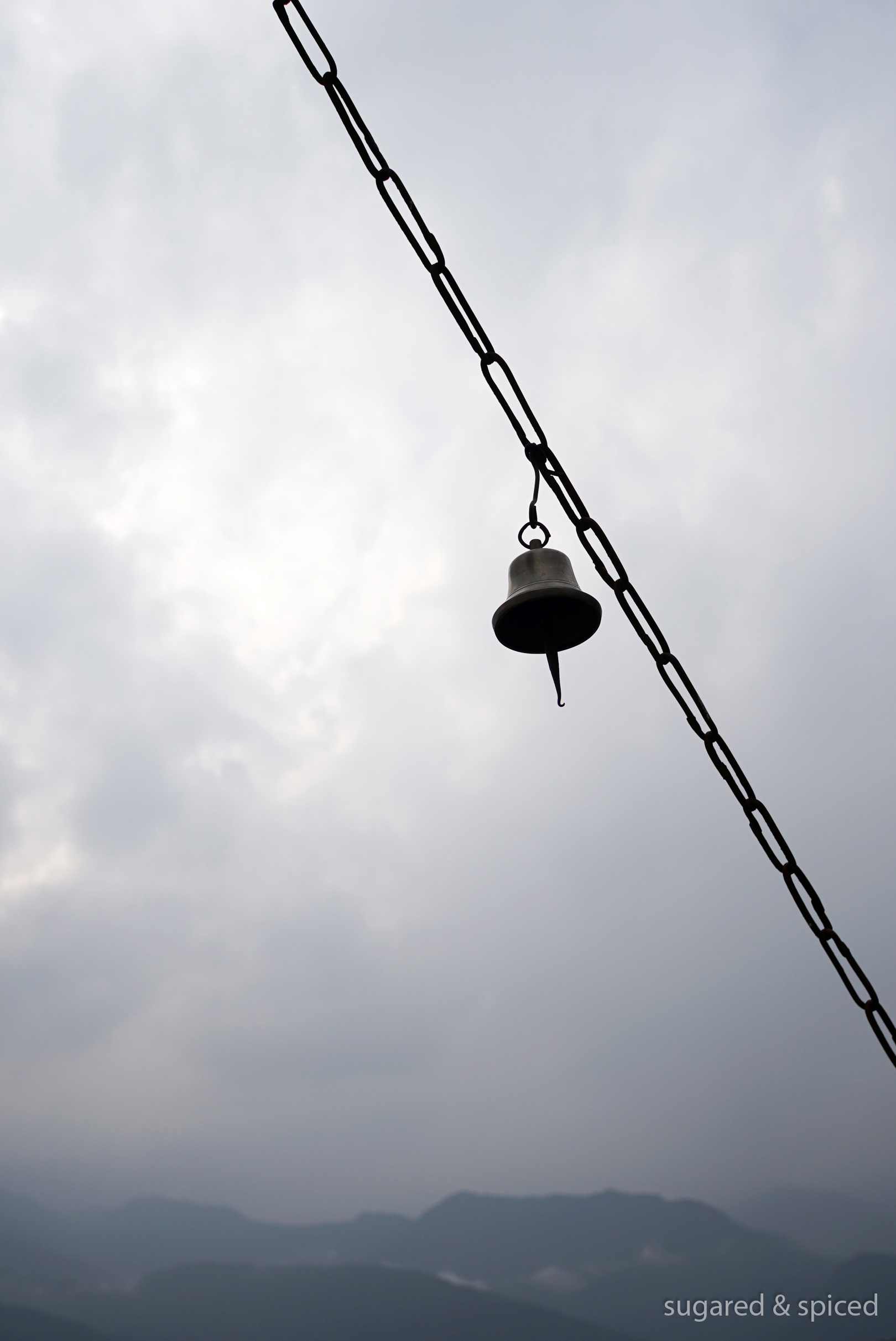
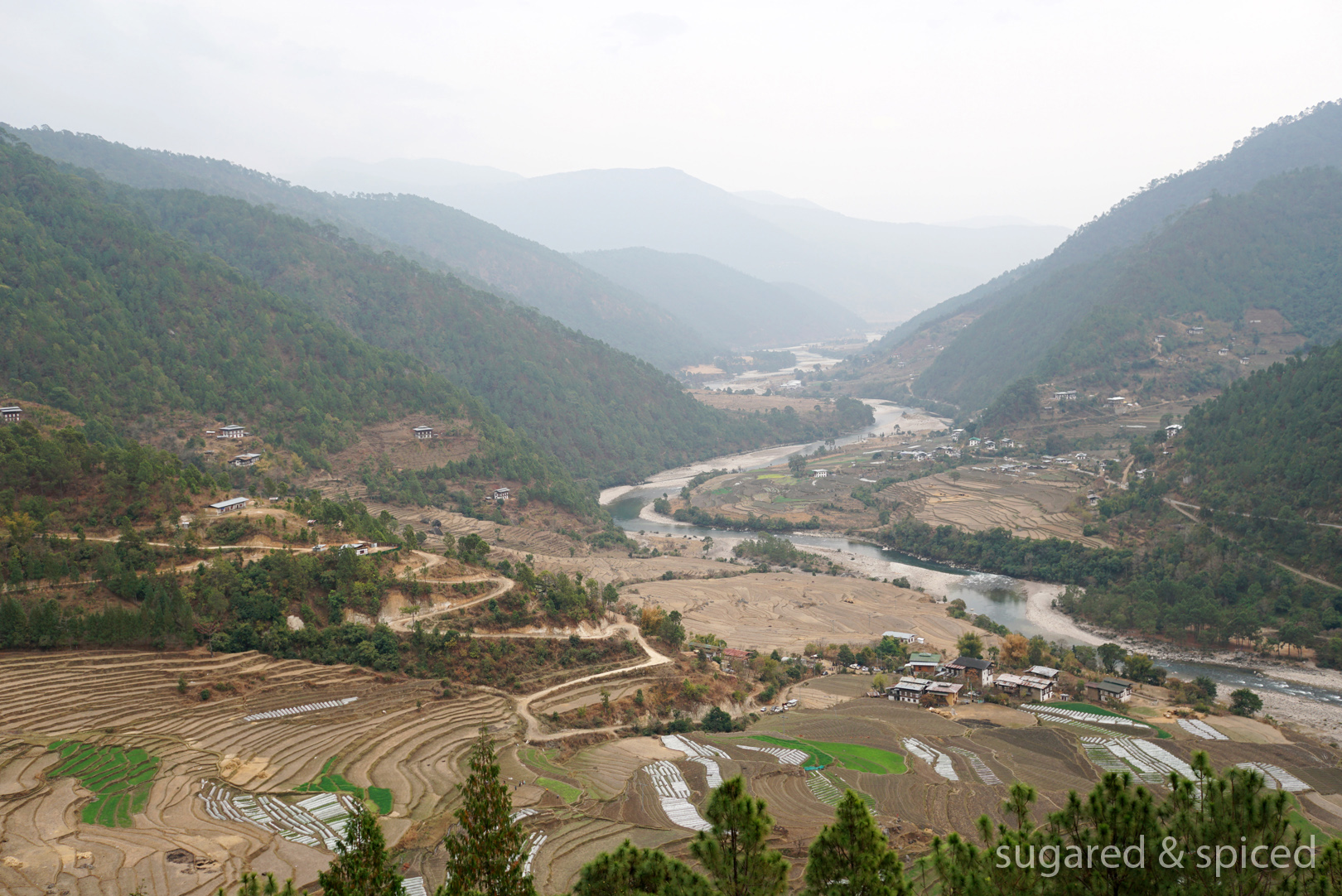
It was another hour-long hike through terraced paddy fields before we arrived back at the lodge, and it was already getting dark. The birds were singing their late afternoon tunes, a bonfire had been lit in the courtyard, and a special cooking class was waiting for us…
又在梯田中穿梭一個多小時後,回到酒店。天色已晚,鳥兒們唱著傍晚的歌,中庭點上了篝火,一堂烹飪課正等著我們…
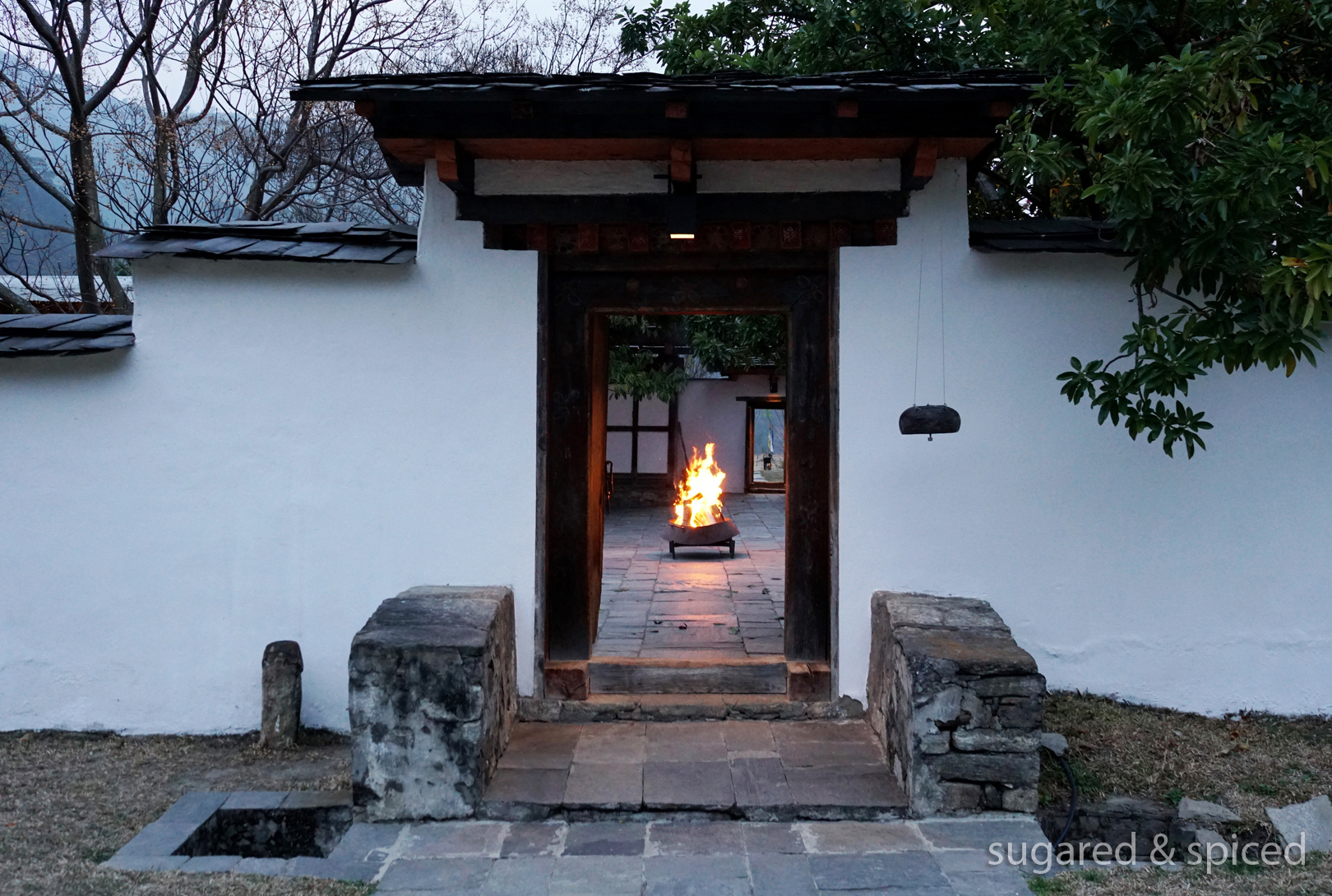
Bhutanese cuisine is simple, spicy, and comforting – I’ve been in love with it since the first day I tried it. Ezay (chili condiments) have become such an integral part of our diet for the past few days, that we decided to arrange a cooking class with Amankora kitchen staff so we could learn how to make these addictive spicy dips.
不丹料理那簡單樸實的美味,我從第一天嘗過後就喜歡上了,於是請 Amankora 安排了烹飪課,教我們做一些簡單的菜色。
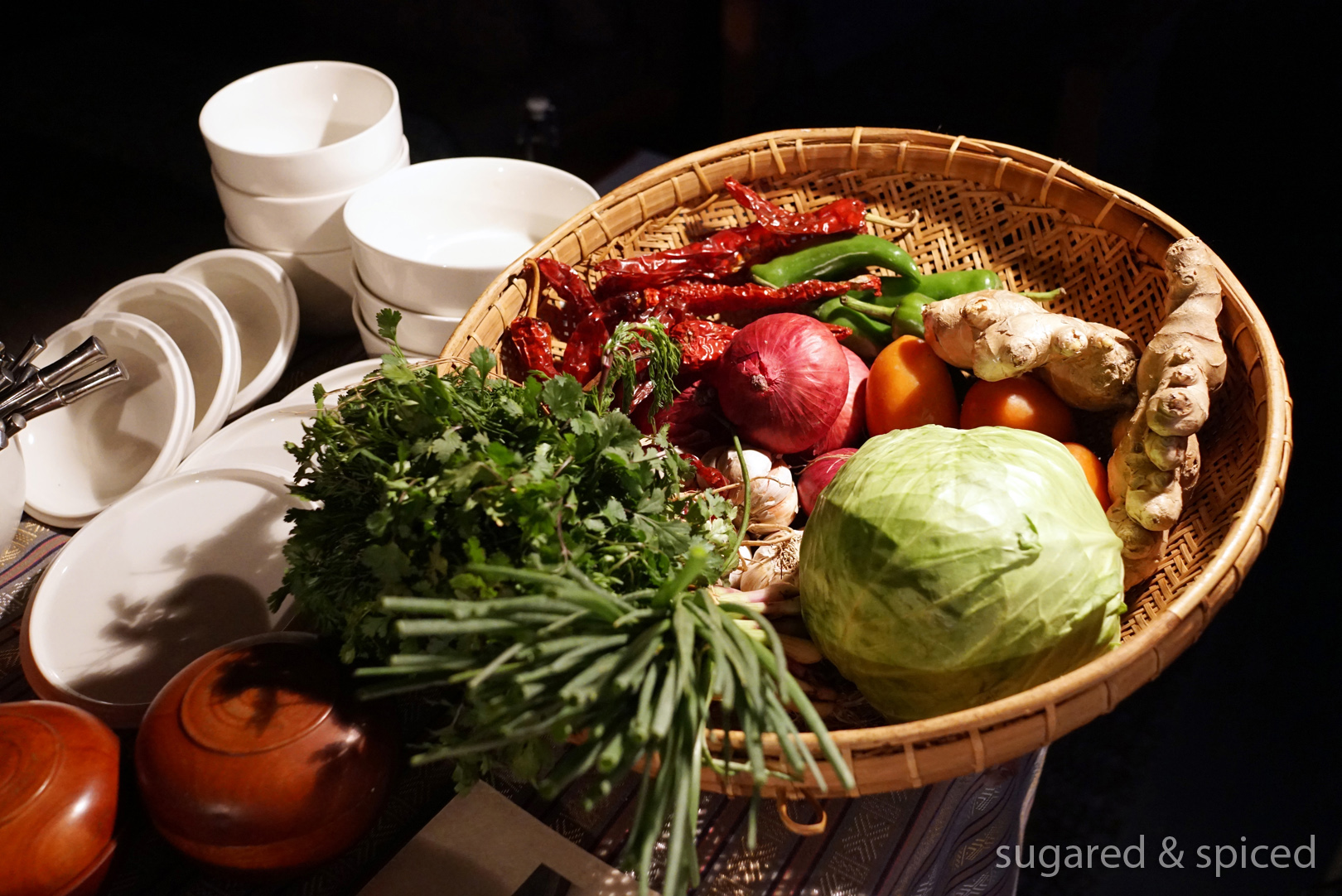
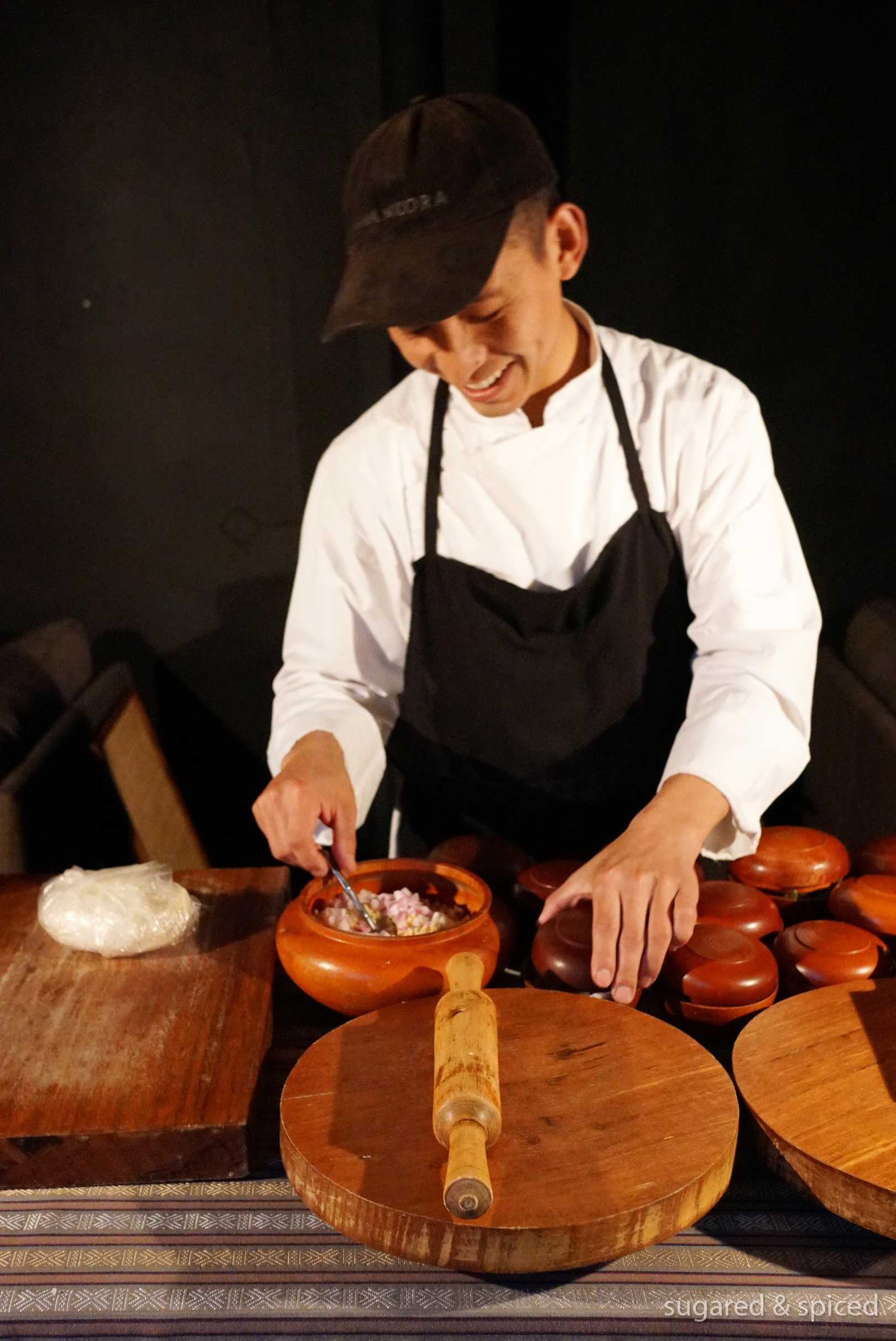
We started by learning how to make the “momo”, Bhutanese steamed dumplings. Being Taiwanese, we are of course very familiar with dumplings, but it was interesting to see variations on the filling and the method of wrapping. After thoroughly mixing a filling of chopped cabbage, red onion, ginger, and local cheese, we folded it into round dumping wrappers, which were made simply with flour and water.
Chef 先示範如何做 momo 蒸餃。雖然我們對餃子並不陌生,但不丹餃子的內餡和包法都和我們所知道的稍有不同。這天做的是素餃,包的內餡是捲心菜、紅洋蔥、薑、和當地起司。
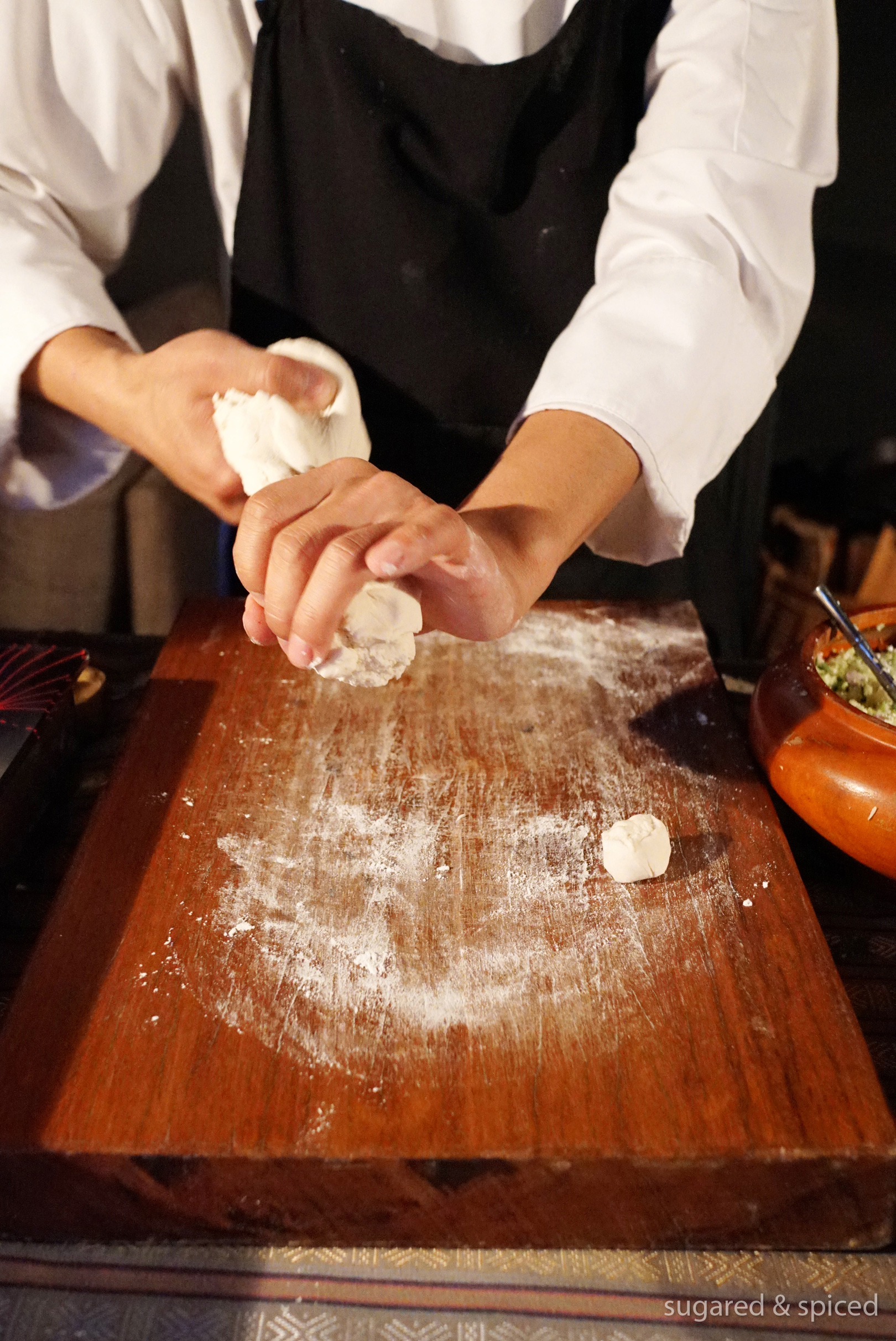
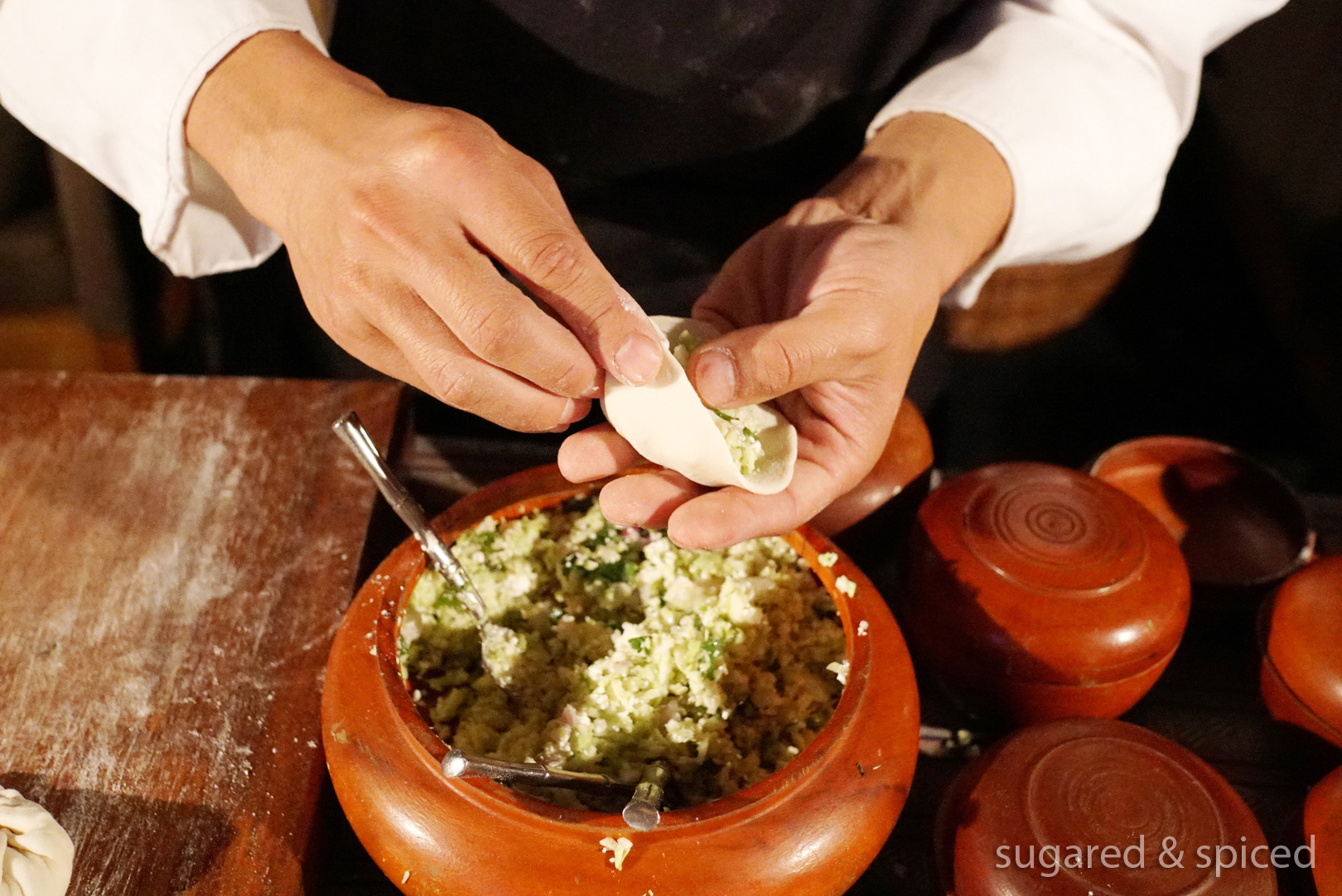
Three different ways of shaping the momo.
三種不同的包法。
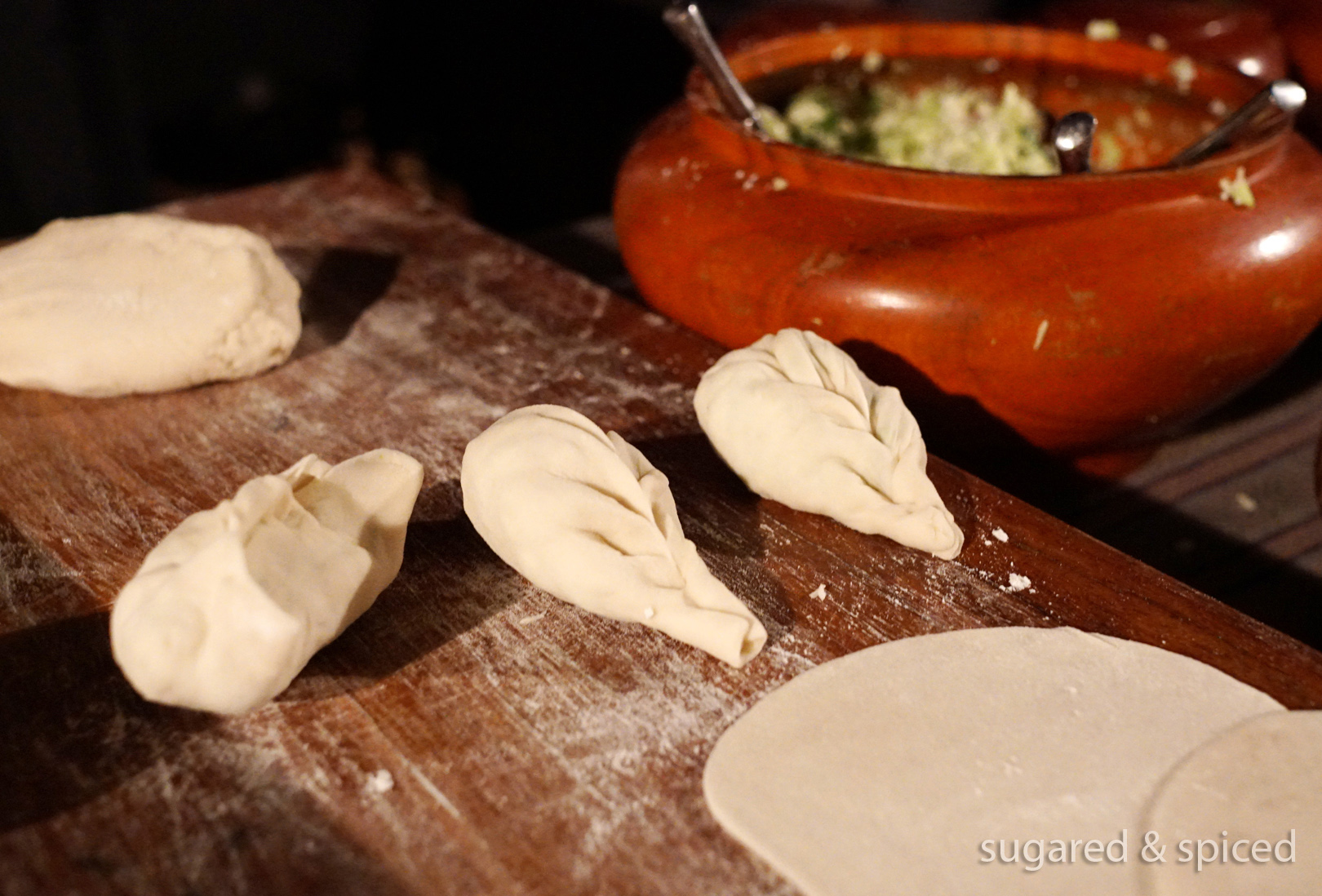
As we wait for the momo to be steamed, the chef demonstrated making three types of ezay. The first, lambada ezay, involved sautéing red onions, garlic, tomatoes and ginger in oil before adding a little mountain of red chili powder. The second, ema ezay, was done by simply mixing onions, tomatoes, chili, coriander, and cheese (no heating required). For the third, ema kam ezay, one must deep fry dry chilies until they are crispy, then mix with onions, tomatoes, and cheese. All are full of flavors, and very, very spicy.
等待餃子蒸熟的同時,chef 示範如何製作三種 ezay 辣椒醬。Lambada ezay:先爆香紅洋蔥、大蒜、薑,再加入番茄和一小山丘的紅辣椒粉。Ema ezay:直接將洋蔥、番茄、青辣椒、香菜、和起司混合,無需加熱。Ema kam ezay:將乾辣椒炸至香脆後,拌入洋蔥、番茄、和芝士。每一種都辣的過癮,每吃一口都額頭冒汗,卻停不下來!
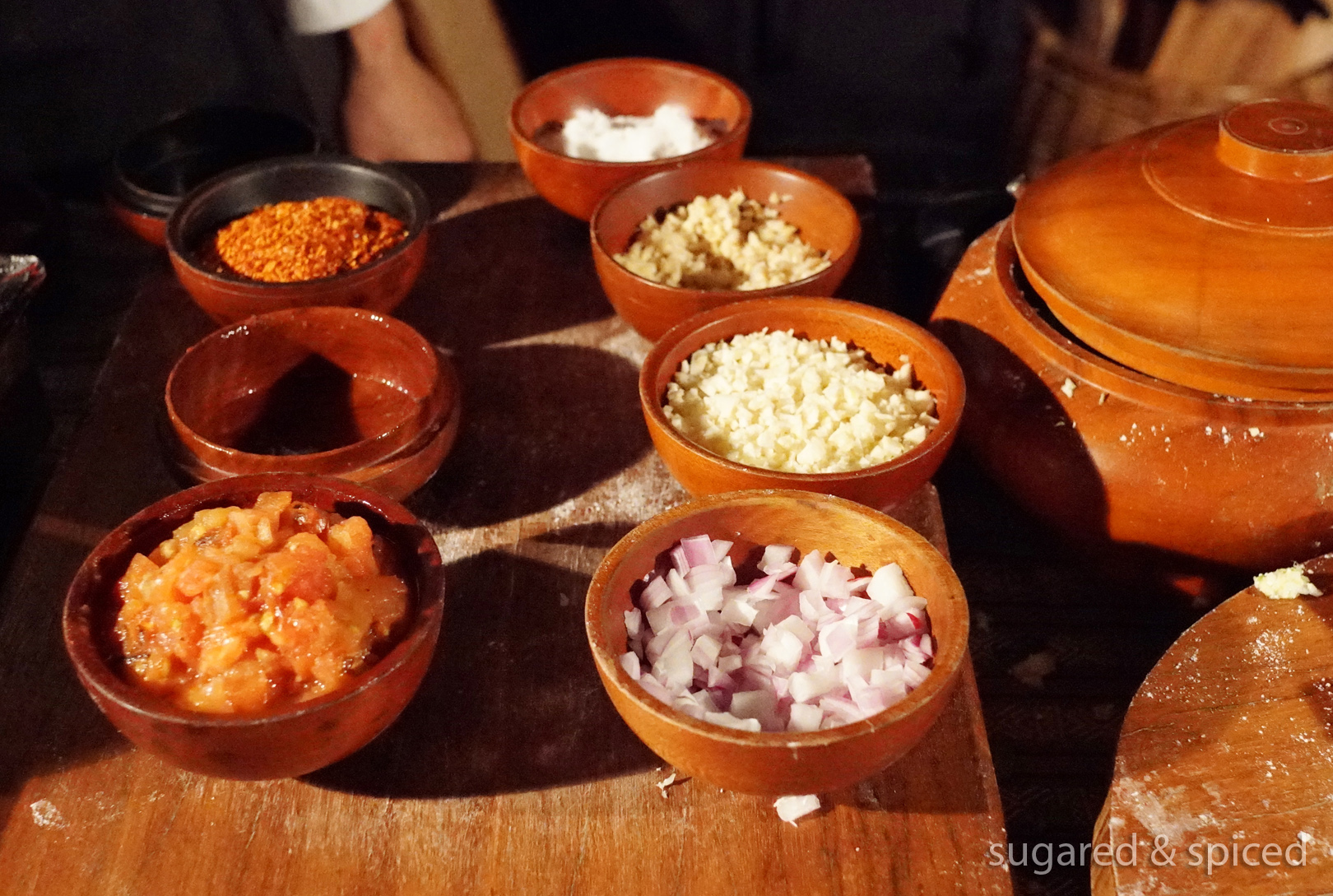
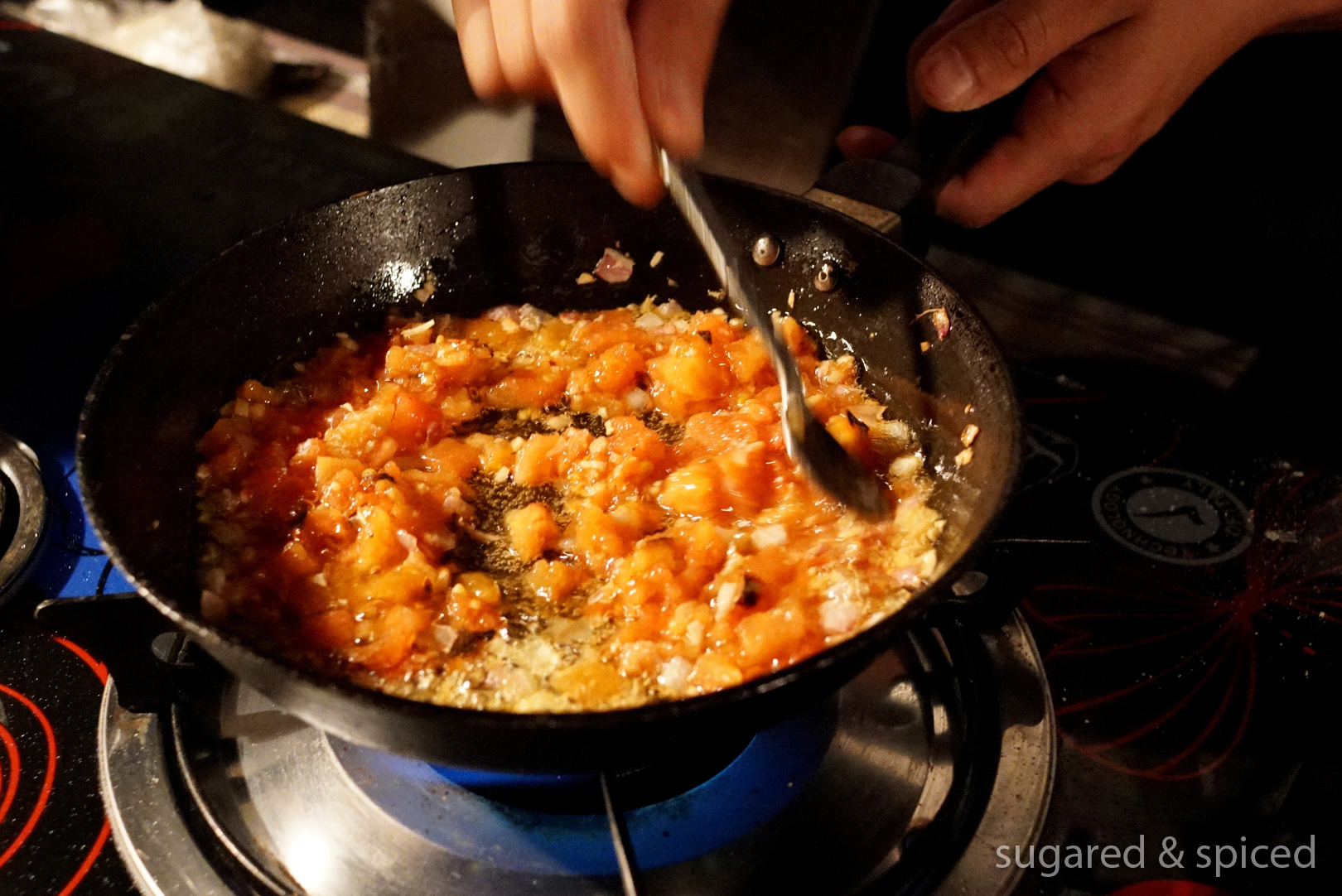
The finale of the class was Bhutan’s national dish, the ema datse. Ema means chili, and datse means cheese, so “ema datse” literally is chili cheese. The process is incredibly simple – add vegetable oil, onion, garlic, tomato, green chili (can also substitute with red or white chili), local cheese, and a pinch of salt in a pot and simmer until cooked. Done. It seems like a rather easy affair, but our taste buds definitely got a kick out of it.
課程的最後是不丹國民料理 ema datse。“Ema” 是辣椒,“datse” 是起司,這道菜顧名思義,就是辣椒炒起司。做法非常簡單 – 在鍋裡加入油、將洋蔥、大蒜、番茄、青辣椒(也可用紅辣椒或白辣椒)炒香後加入當地芝士以及一點鹽調味,燉煮至熟透即可。看似簡單但美味滿點,配上一碗米飯,就是令人滿足的一餐。
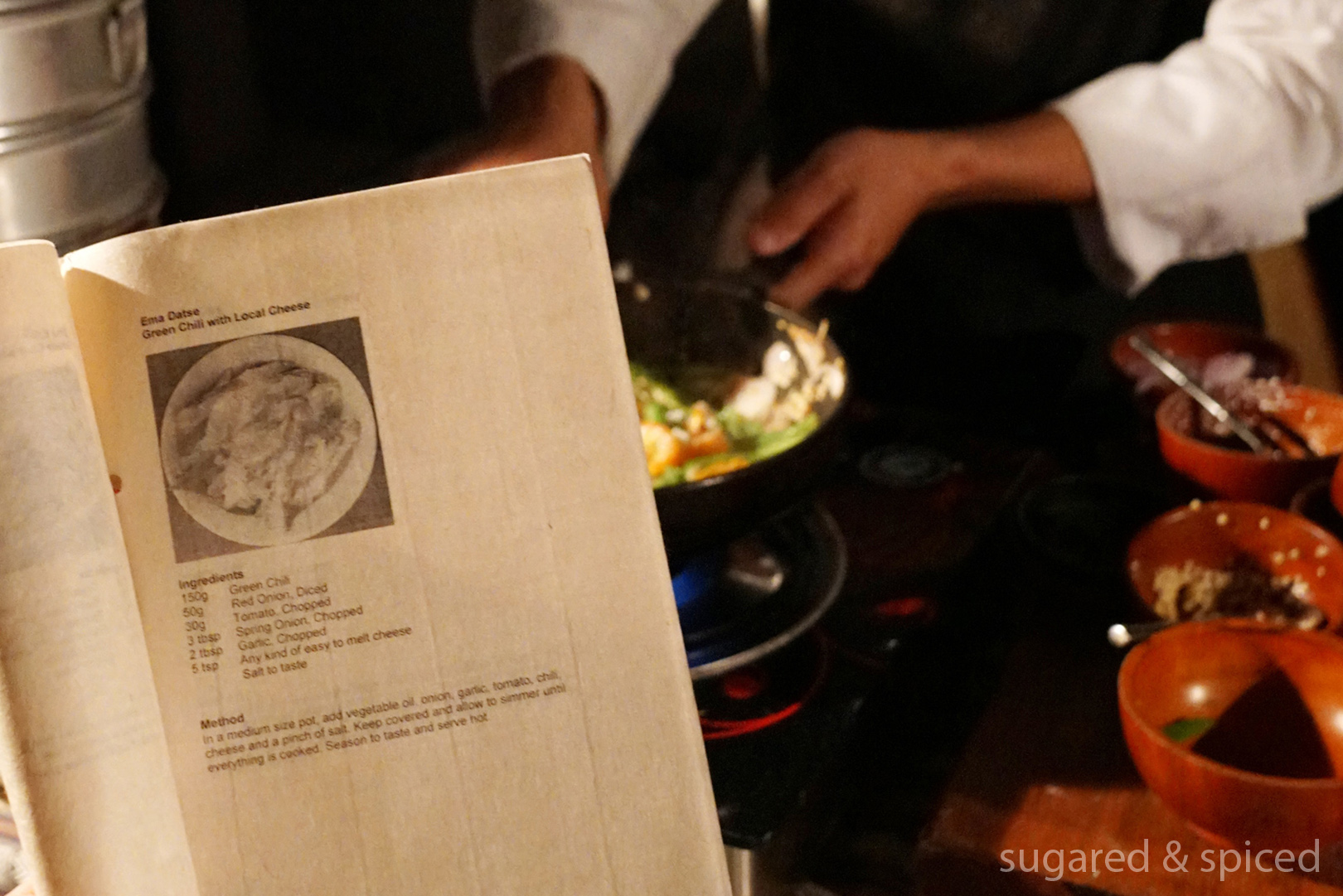
Instead of moving to the dining room, we settled on enjoying the fruits of our labor (rather, the fruits of our chef’s labor) right here in the kitchen. Everything was as fresh as they could be – momo that just came out from the steamer, ezay and ema datse still sizzling from the heat of cooking….the chef also brought us solar (soup of buttermilk with onion, tomato, and chili), jasha maru (local chicken curry), and a heap of steamed rice lest we were still hungry. I could think of no better way to end the day.
料理完成後,我們決定在廚房趁熱直接品嘗。每樣食物都是新鮮出爐 – momo 餃子剛從蒸鍋里取出,ezay 辣椒醬 和 ema datse 辣椒炒起司都才剛起鍋,還冒著煙。Chef 為我們額外準備了 solar(洋蔥、番茄、辣椒、白脫牛奶湯)、jasha maru(不丹雞肉咖哩)、以及熱騰騰的紅米飯。能以自己做的料理(其實大部分是 chef 的功勞)做為一天的結尾,實在太棒了。
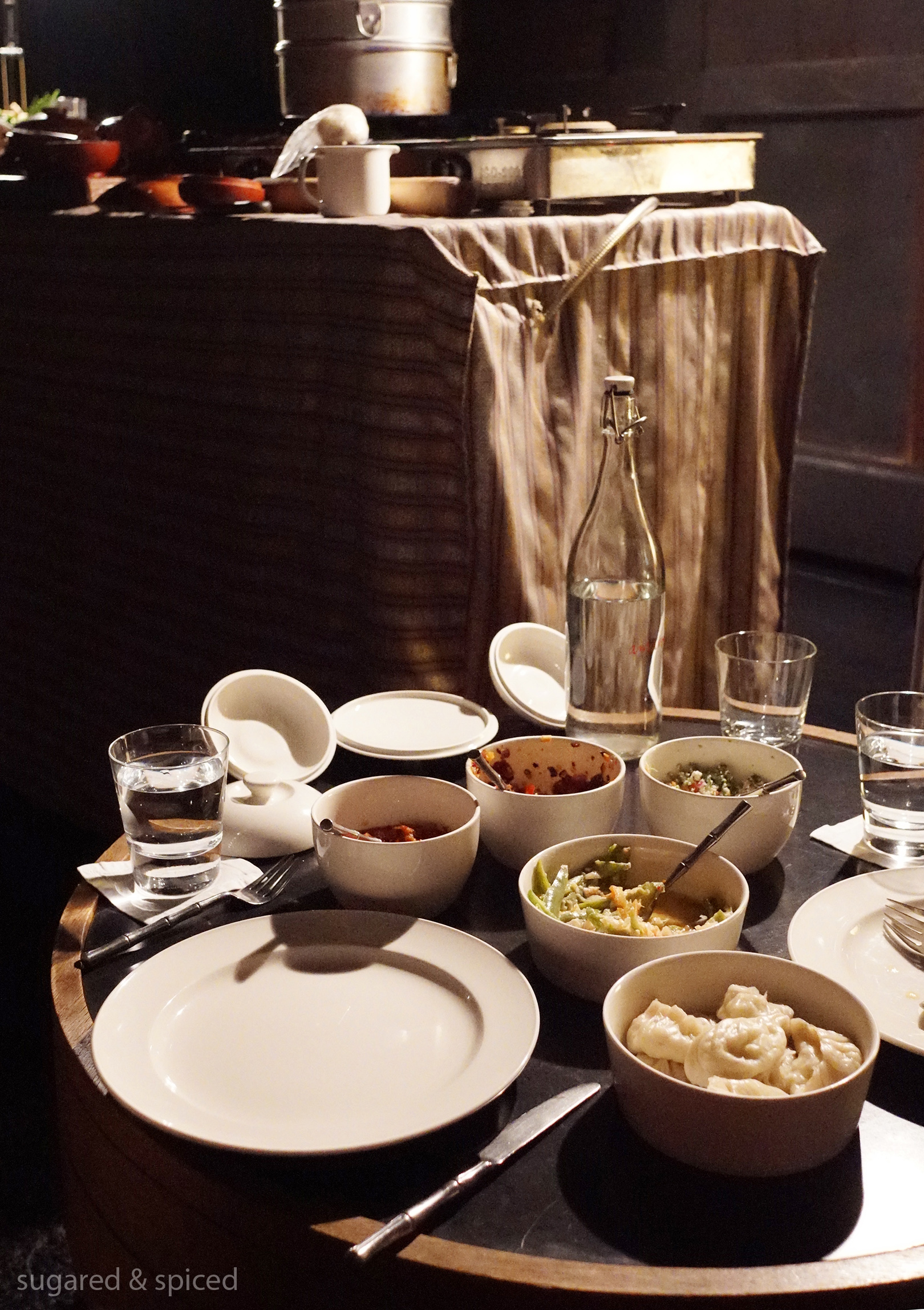
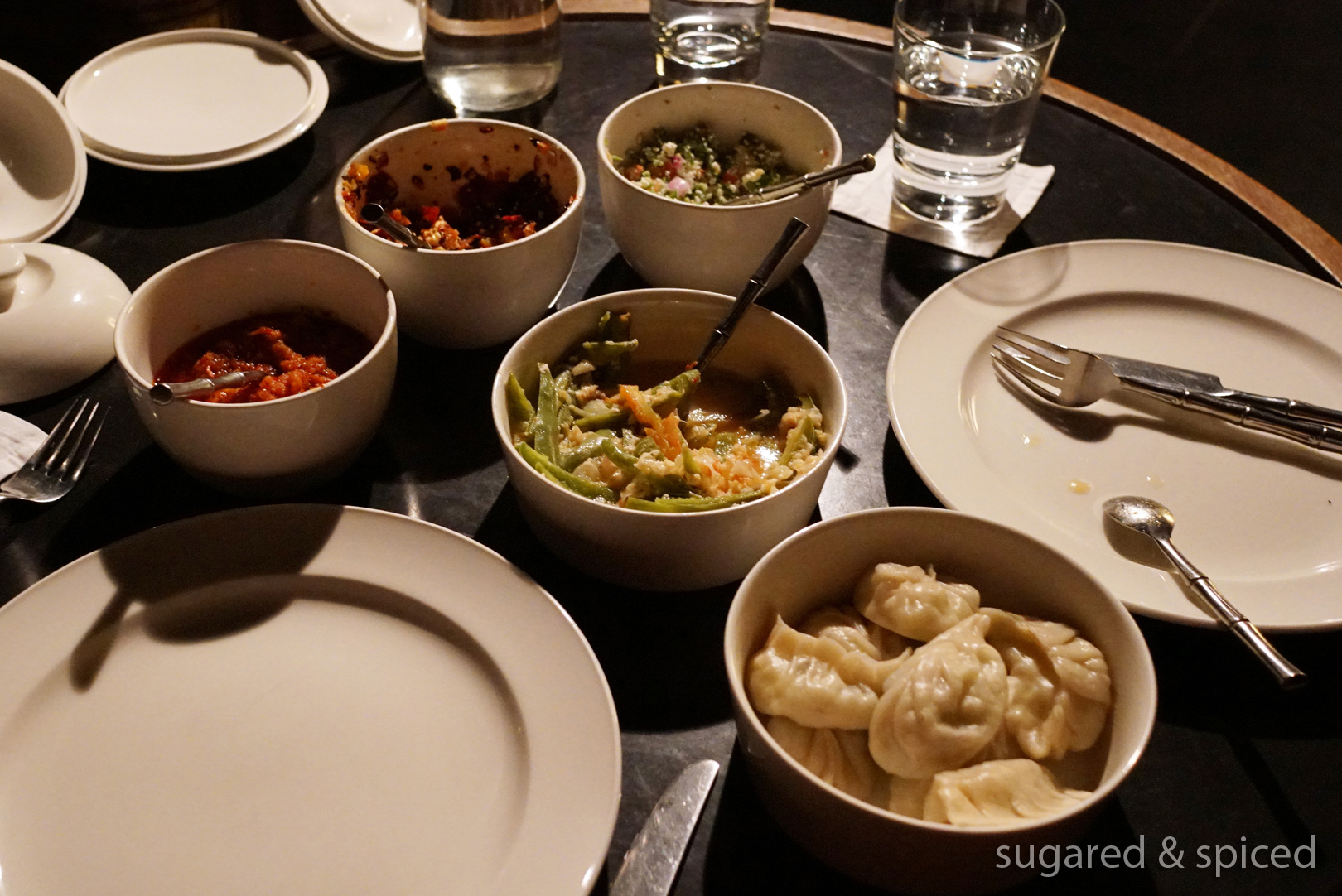
Later that evening, as I lay down in bed, I let my mind wander back to that seemingly banal encounter in the rice paddy field. The students, their checkered uniforms, the simple hello, and their shy, unadulterated smiles. It was one of the most beautiful moments for me on this trip, but for some reason, I didn’t stop them to ask if I could take a photo, as I sometimes do with strangers. Maybe I was focusing on the moment so I could imprint that scene into memory. Even now, as I’m writing this post long after I’ve left Bhutan, I could feel my heart swell with emotions as I retrieve this memory…
回房後,我躺在床上回想今天下午在梯田間的種種相遇 – 和學生們、射箭的男人們、翻跟斗的孩子們、以及在涼亭休息的一家三口。在不丹,每天都體會到人與人之間短暫卻又充滿善意的互動。在連擦身而過的人都會給你一個璀璨笑容的國度,怎能不快樂?直到現在,即使離開不丹已久,回想起那天在梯田上的光景,心又再次被感動填滿…
